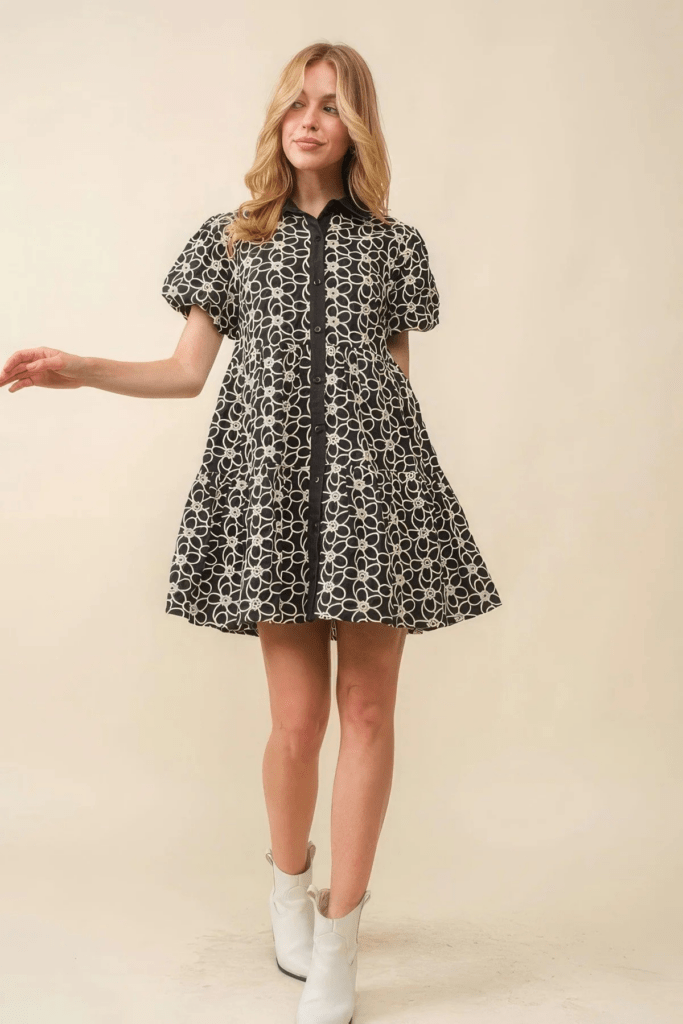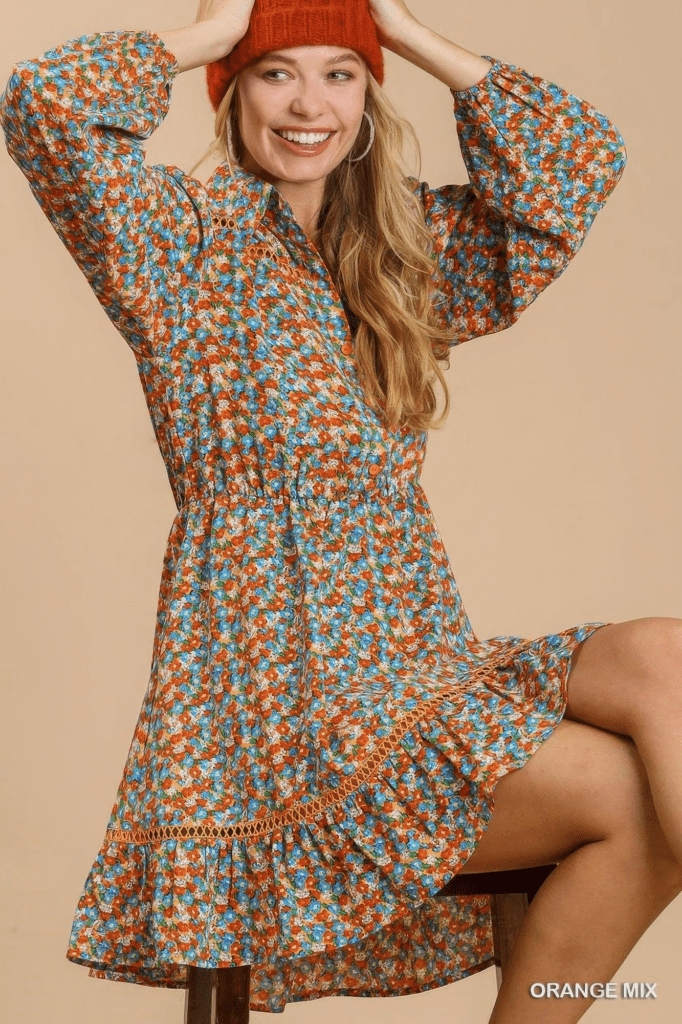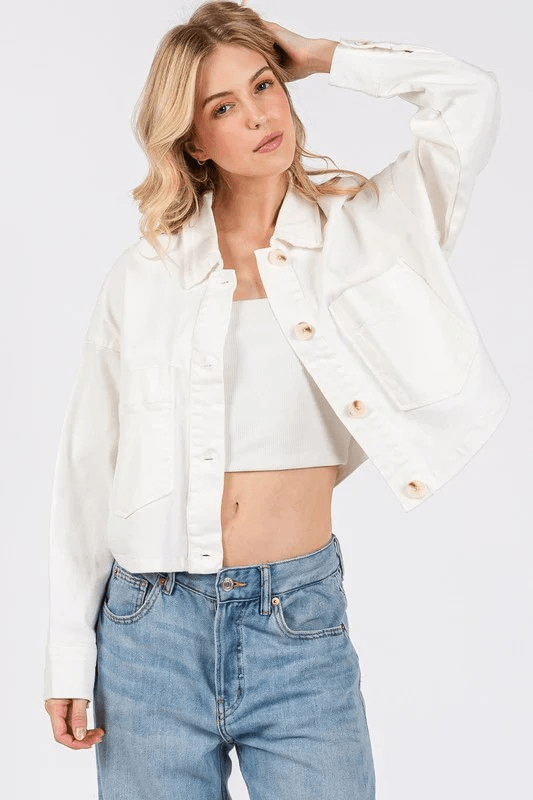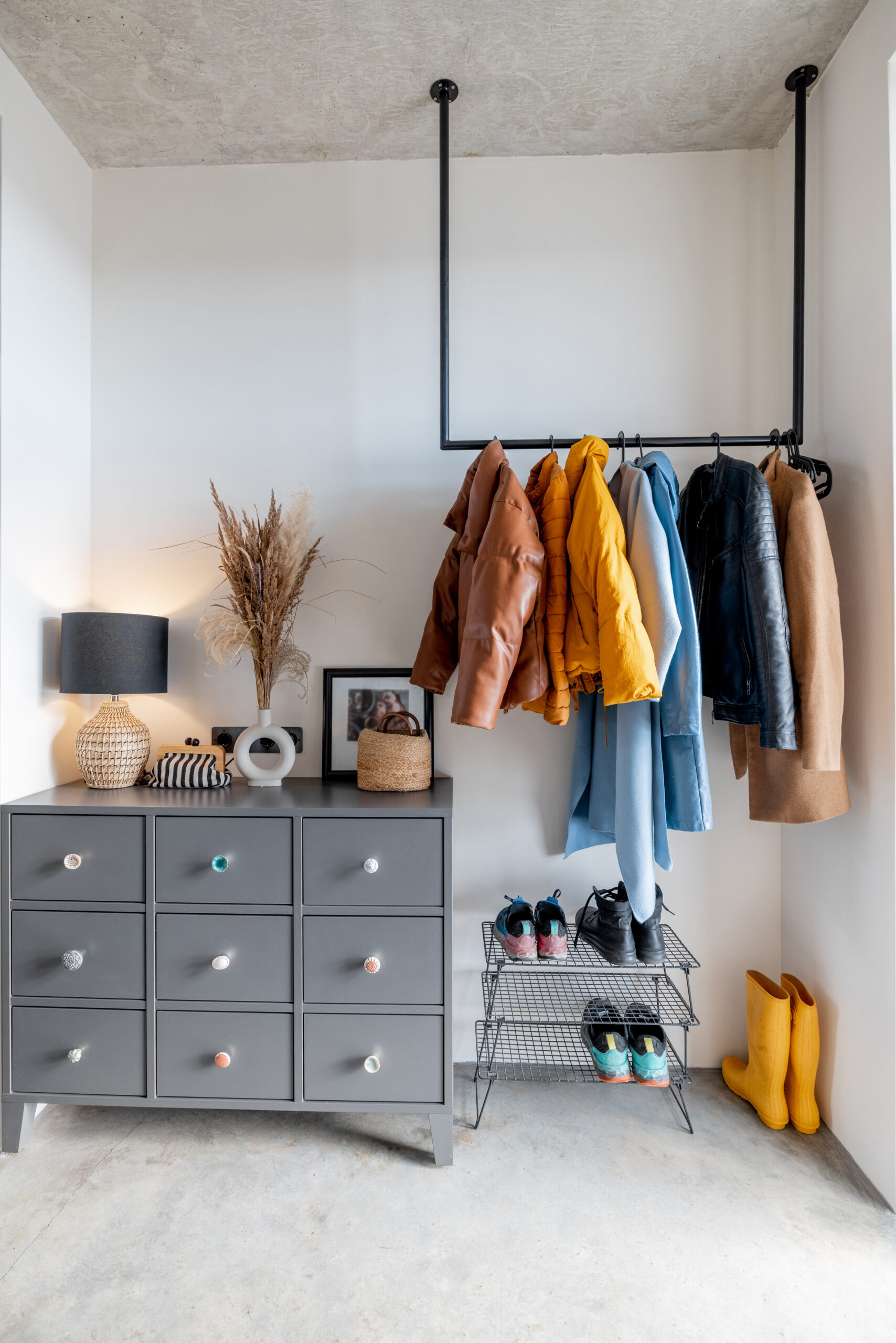
How to Build a Stylish Wardrobe in Your 30s
At some point in your 30s, you might look at your closet and think, something just isn’t working anymore. Over time, we all collect clothes—some that once made sense, and others we’ve just hung onto out of habit or because they carry some sort of sentimental value. But how often do we actually stop to clear things out? The result? A packed wardrobe, yet nothing that feels quite right to wear.
Now that you are in your 30s, maybe your lifestyle has shifted—less late nights out, more zoom video calls, grocery store runs, and school pickups. That’s totally normal. In fact, it’s a great sign! It means you’re evolving, and your closet should evolve with you.
This is the perfect moment to start aligning your wardrobe with the life you’re living now—one that reflects who you are and where you’re headed. Ready to make room for outfits that actually work for your day-to-day? Good. In this guide, I will teach you how to get organized, rediscover old favorites, and maybe even treat yourself to a little shopping. Yay!
Let’s talk about how to simplify your wardrobe, define your style, and fall back in love with getting dressed again all while saving money in the process.
Start with the Essentials: The Core of a Functional Wardrobe
Before we talk about shopping or organizing, let’s get clear on the essential clothing items every woman in her 30s should have. These are the pieces that form the backbone of your closet—the ones you reach for again and again. You may also realize that you already own some of these items which is going to save you time and money when it comes to actually building your perfect wardrobe. Don’t worry if you do not wear some of these items often, we will find new ways to style them!
Timeless Essentials Include:
A classic white button-down
This is an essential clothing piece that does it all! You can pair it with trousers for a “business casual” look or jeans if you are going for a more relaxed vibe. Your button down should be both comfortable and well fitted. This means not too baggy and not too fitted.
A well-fitted pair of jeans
I am going to be honest and let you know right away that finding the perfect pair of jeans can be a bit challenging. Don’t worry, I have a blog post that covers everything you need to know about how to find the perfect pair of jeans for your specific body type. After reading through the article, you will want to find your perfect fit even if it means heading to the Old Navy to do a try-on haul. Fun!
A versatile black dress
The little black dress (LBD) has been a timeless fashion staple due to its simplicity and versatility. A black dress can be dressed up with statement jewelry and heels for a night out or dressed down with sneakers and a denim jacket. You can even wear it to work with a cute blazer.
Comfortable, neutral shoes (think white sneakers or loafers)
Neutral color shoes like nude, beige, black, white, and gray can complement almost any outfit. They can also go with a wide range of colors without overpowering them.
A tailored blazer
I never thought of buying a blazer until I realized just how much of a difference it can make in terms of making an outfit pop! Tailored blazers can elevate just about any outfit from formal to casual occasions.
A cozy knit or two
Cozy knitted clothes like cardigans or light sweaters are perfect for keeping you warm during cooler months and stylish during warmer ones.
A go-to tote or shoulder bag
This will be your everyday bag that is practical and fits your specific needs. If you tend to carry more items in your bag like I do, opt for a bag with different sections for organization.
Basic Tee or Tank
A high-quality tank is a great layering essential wardrobe item. Basic tees are perfect for days when you just don’t know what to wear. Find one that is high quality and won’t lose its shape over a few washes. Stick with black and white to start.
How to Build a Stylish Wardrobe: Understanding your Closet Type
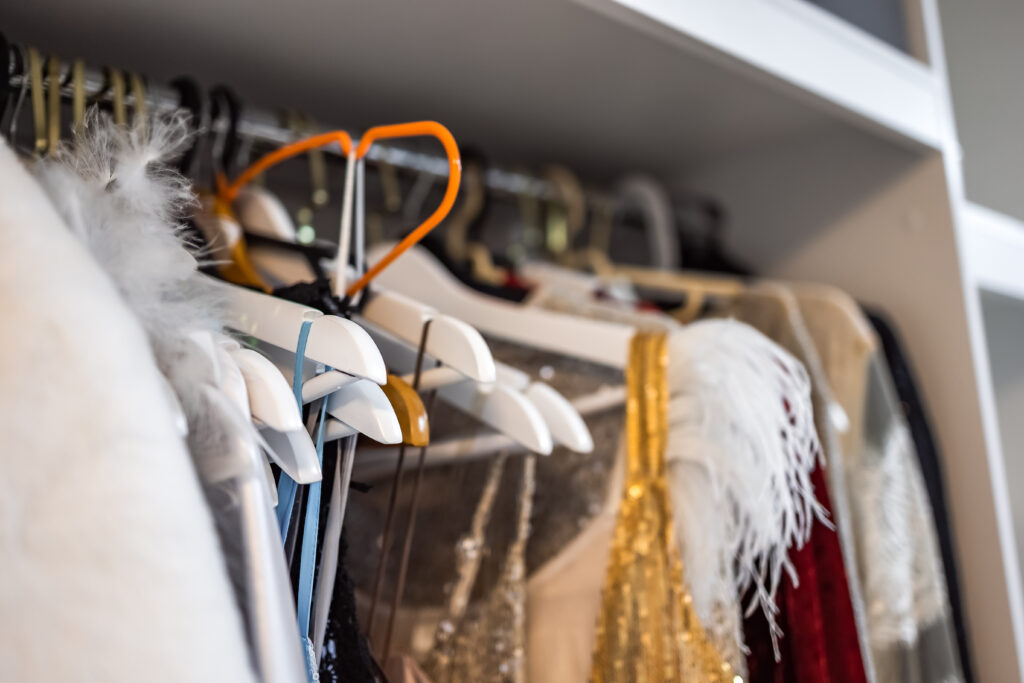
Before you begin to purge your closet, it is important that you understand what kind of closet you are working with. Not all closets are created equal. Walk into your closet and take a quick look around. The way you use your clothes should determine how you organize and curate your wardrobe. This is also a great time to look upon the clothing that you will be parting ways with as we are about to say “bye-bye” to some of them. Here are a few “closet types” to consider:
- The Capsule Closet: Minimal, intentional, often under 40 pieces. Great for decision-fatigue and simplifying.
- The Rotating Seasonal Closet: You swap clothes in and out each season for variety.
- The Sentimental Closet: Packed with memories—but maybe not practicality.
- The “I Might Need This Someday” Closet: Overflowing with ‘just in case’ pieces.
- The Hybrid Closet: A mix of all of the above (which is most of us).
Check out my blog post on different types of closets to learn more about these closet types. Now that you know what essentials you need and what type of closet you are working with, it is time to organize and declutter.
Organize and Declutter
This is where the leg work begins. Grab a bottle of water before you begin. See how nice I am? Lol. Okay, so first thing’s first create three piles. Keep, donate/sell, or discard. Only discard clothing as a last resort if the clothing is worn out or beyond mending. You can create some cute signs to make the process more fun too! With the exception of the essentials that we discussed in step 1, you are going to take every single item out of your closet that you have hardly worn and try them on. Here are some questions to consider throughout this process.
Have I worn this in the past year?
If it hasn’t made it out of the closet in 12 months, chances are it won’t in the next 12 either.
Does it still fit my current body and lifestyle?
Our lives and bodies change. Keep clothes that reflect who you are now—not who you were or think you might be.
Would I buy this today?
Imagine spotting the item in a store right now. Would you be excited to purchase it again?
Is it damaged, stained, or uncomfortable?
If it’s not wearable or it feels off every time you put it on, it’s not serving you anymore.
Am I keeping it out of guilt or sentimentality?
Emotional attachments are real but try to separate the memory from the item. You can honor the memory without the clutter.
Does this item make me feel confident and happy?
If you don’t feel good wearing it, it probably doesn’t belong in your closet.
After you have successfully created your piles, you are ready to identify your personal style.
Identify Your Personal Style
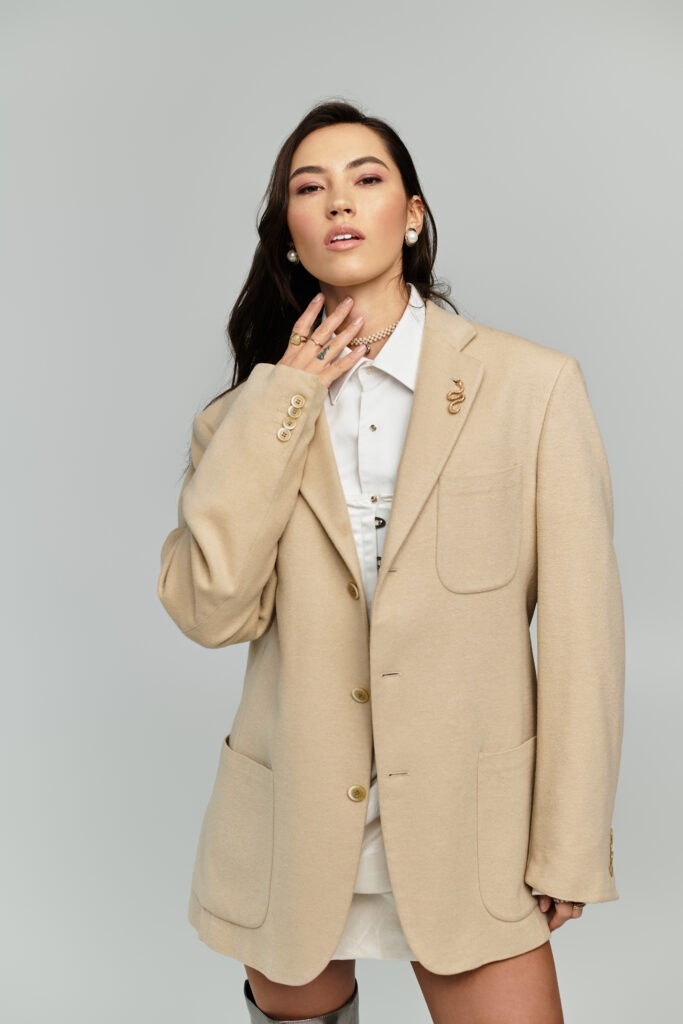
Building a capsule wardrobe is not something that you can do overnight. It takes some time to truly find which specific style you are drawn to. Take a few days and take note of the following:
- Audit your current wardrobe. Take a look at your clothing and notice the colors you gravitate towards.
- Take a look at the fabrics you own. Do you like cozy, soft fabrics (like knits and fleece) or structured, sleek ones (like leather and denim)?
- Think about one clothing item from your closet that you always reach for and ask yourself what you like about it. How does it make you feel and why?
- Take a look at the patterns that you own and see which you wear the most. Some people love the look of patterns but don’t enjoy wearing them.
- What shapes make you feel most confident—fitted, flowy, cropped, oversized?
- Identify recurring shapes (e.g., high-waisted pants, A-line skirts, boxy tops).
- Use Pinterest or a style mood board app to collect outfit inspiration and spot recurring themes.
- After doing your research. Choose 3–5 words that define your style. Ex: “Casual, feminine, earthy, vintage-inspired.”
Pro tip: Use the 80/20 Rule
80% of your wardrobe should be things you wear often and feel great in. The other 20% can be for experimentation—wild prints, bold textures, or seasonal statement pieces.
How to Build a Stylish Wardrobe: Shop Mindfully
How to Shop for Your Unique Style
Build a Color Story
Identify a few go-to colors that flatter your skin tone and are easy to mix and match. This helps streamline your closet and makes getting dressed way easier.
Focus on Versatile Staples First
Before jumping on trends, invest in well-fitting basics you can style multiple ways—like a great blazer, quality denim, or the perfect white tee. Then layer on personality pieces that reflect your vibe.
Be Honest About Comfort
If you’re not comfortable, you won’t wear it—no matter how cute it looks on the hanger. Pay attention to fabrics, waistbands, and cuts that feel good on your body all day.
Try It On with Your Life in Mind
Don’t just ask, “Is this cute?” Ask: “Can I wear this on a Monday morning?” or “Would I wear this to dinner with friends?” Imagining real situations helps weed out impulse buys.
Make a Pinterest or Screenshot Folder
Collect outfits you love and patterns you notice (e.g., “I always save outfits with ankle boots or midi skirts”). This can guide future purchases and help define your signature look.
How to Save Money) While Building a Stylish Wardrobe
Shop with a Plan
Impulse buys can drain your budget fast. Instead, create a wish list of items you actually need or pieces that will fill gaps in your wardrobe.
Embrace Thrifting and Secondhand Finds
From consignment stores to online resale apps like Poshmark or ThredUp, secondhand shopping is a goldmine.
Wait for Sales (But Don’t Wait Forever)
Sign up for brand emails or use price tracking tools (like Honey or Karma) to get alerts when something goes on sale.
Prioritize Cost-Per-Wear
A $100 blazer you wear twice a week is a smarter buy than a $25 dress you wear once.
Know When to Splurge and When to Save
Invest a bit more in timeless staples (like a great pair of jeans or a neutral coat), and save on trendy pieces that might be out of style next season.
Borrow, Swap, or Rent for One-Offs
Have a wedding, fancy event, or vacation coming up? Instead of buying something new, consider borrowing from a friend or renting through a service like Rent the Runway.
How to Build a Stylish Wardrobe in Your 30s
Brands to Look for while Thrifting
Different Types of Closets
Embrace Minimalist Outfits That Still Feel Like You
Minimalist doesn’t mean boring. It means intentional. It means choosing pieces that work together, fit your lifestyle, and bring you joy. The best thing about having a minimalist wardrobe is the fact that you can easily shop your closet when you are not sure what to wear.
Minimalist Outfit Formulas:
- White tee + straight-leg jeans + blazer + sneakers
- Knit dress + ankle boots + denim jacket
- Monochrome (black or tan) outfit with a bold lip or earrings
Start building “uniforms” that make getting dressed feel easy and enjoyable.
Thrift Smarter: Brands to Look For
If you’re ready to add something new, thrifting is the budget-friendly, sustainable way to go. But not all secondhand finds are created equal. Follow this quick guide.
Thrift-Worthy Brands Known for Quality:
- Everlane
- J.Crew
- Madewell
- Banana Republic
- Eileen Fisher
- Patagonia (for outerwear)
- Frye (for boots)
- Levi’s (especially 501s)
Bonus Tips:
- Learn to spot natural fibers (cotton, wool, linen = long-lasting)
- Make sure your thrifted clothing is free from harmful odors
- Look for structure: seams, tailoring, and lining indicate quality
- Check for wear and tear in common spots (underarms, inseams, zippers)
Final Thoughts
Your 30s are the perfect time to refine your style without losing your personality—or your paycheck. A well-curated closet isn’t about having more. It’s about having the right things—and knowing how to wear them. With a few core essentials, a better understanding of your style, and a thrifty eye, you can create a wardrobe that feels fresh, functional, and fully you. I hope you enjoyed this blog post. Please let me know in the comments if you find this information helpful!
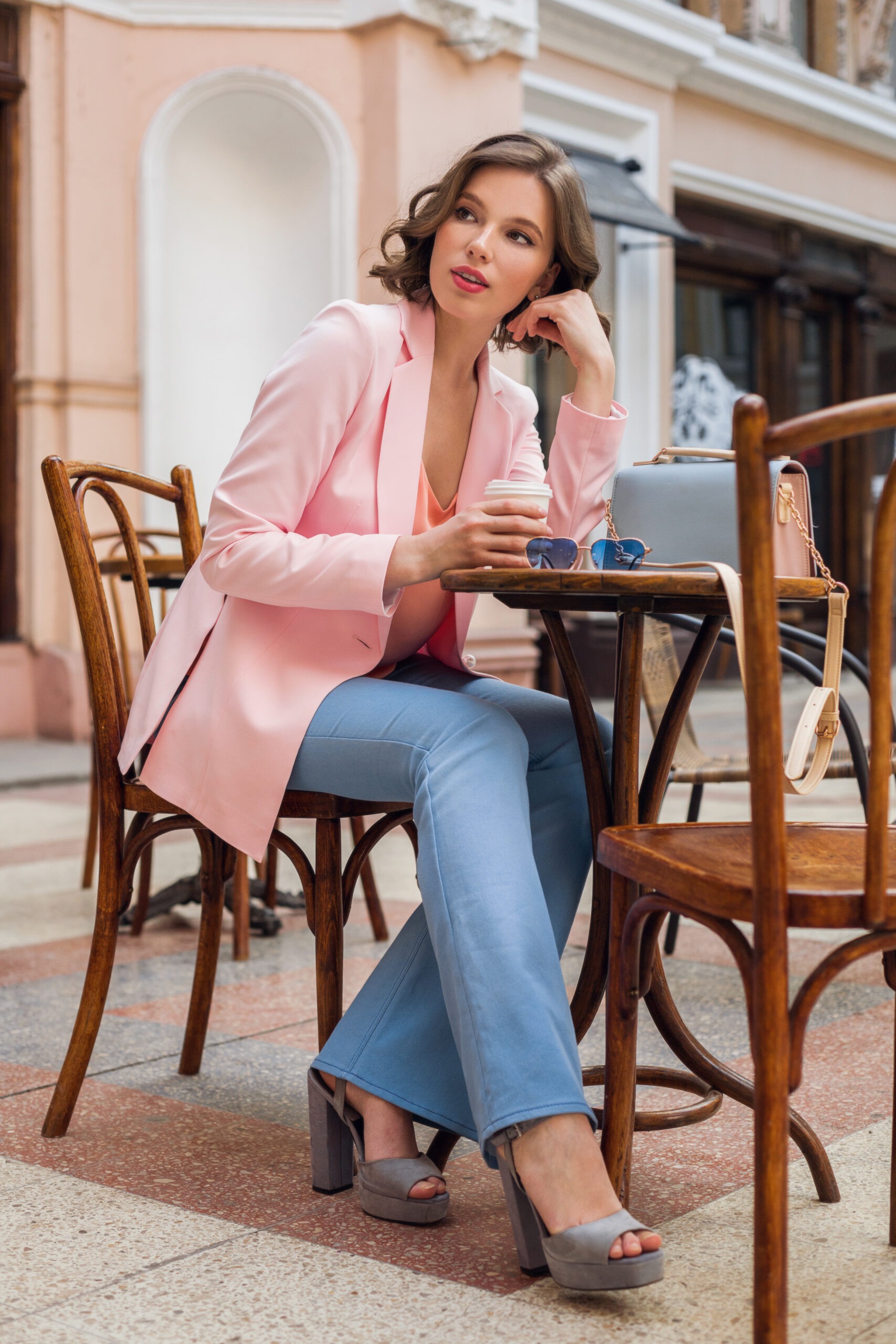
Pink Blazer Outfit Ideas
Introduction
The pink blazer is a fashion favorite that continues to hold its own in closets everywhere. It’s versatile, polished, and adds a pop of color to any outfit—perfect for dressing up or down. Whether you’re heading to the office, going out for coffee, or meeting up with friends for brunch, a pink blazer can be the standout piece that pulls your look together. In this blog, we’re diving into some creative and stylish pink blazer outfit ideas that just about anyone can pull off!
Why Choose a Pink Blazer?
I was never a fan of bright colors but now that I am in my 30s, I am taking full advantage of stepping outside the box. I challenge you to do the same. Experimenting with different colors, patterns, and silhouettes will help you to discover new styles that you may love. A pink blazer isn’t just about making a statement—it’s about feeling confident and put together. Here’s why it’s worth adding to your wardrobe:
- Feminine but powerful: It combines softness with structure.
- Seasonless style: Works in spring, summer, and even fall.
- Outfit versatility: Dress it up for work or down for casual outings.
- Tons of shades: From blush to hot pink, there’s a tone for everyone.
How to Style a Pink Blazer
Pink Blazer Outfit Ideas for Work
You don’t have to limit yourself to navy or black for office wear. A pink blazer can be both professional and playful.
Shop Similar: High Waist Trousers | Belt | Blazer | Top
Shop Similar: Blazer | Blouse | Pencil Skirt | Heeled Sandal
Shop Similar: Pants | Pink Blazer | Bodysuit | Crossbody Bag
Shop Similar: Blouse | Blazer | Jeans | Handbag
Pink Blazer Outfit Ideas for Casual Weekends
Yes, you can totally rock a blazer on the weekend. Here’s how to keep it relaxed yet stylish.
Shop Similar: Blazer | Graphic Tee | Loafers | Jeans
Shop Similar: Bodysuit | Blazer | Pants | Shoes
Shop The Look: Blazer | Handbag | Jeans | Top | Gold Studs | Sneakers | Sunglasses
Brunch or Day Out with Friends
Brunch is the perfect time to wear a pink blazer. It brings a fresh, light feel that fits right in with mimosas and sunny mornings. Not to mention you can wear it for the remainder of the day to run light errands. You’ll receive complements like crazy with these outfit ideas!
Shop Similar: Shorts | Crop Top | Blazer | Sunglasses
Disclosure: Some of the links in this post are ‘affiliate links’. This means if you click on the link and purchase the item, I will receive an affiliate commission.
Shop Similar: Blazer | Lightweight Jeans | Satin Blouse
Pink Blazer Outfit Ideas for Date Nights
If you are looking to add a pop of color for a date night, a pink blazer can do the trick. A soft pink symbolizes femininity, gentleness, and romance. Your date will want to skip dinner altogether once he sees you in these stunning pink blazer outfits!
Shop the Look: Jeans | Crop Top | Blazer | Clutch | Pumps
Shop Similar: Blazer | Jumpsuit | Heels
Valentines Day Pink Blazer Outfit
What Colors Go with a Pink Blazer?
If you’re not sure how to color match, don’t stress. Here are a few tried-and-true pairings:
- White and cream: Crisp and clean
- Black: Timeless and elegant
- Gray: Soft and balanced
- Navy: A great alternative to black for a more relaxed look
- Denim: Always a good idea
- Red or burgundy: Bold and unexpected, especially with deeper pink shades
Outfit Ideas Based on Shades of Pink
Light Pink Blazer
- Great for spring and summer
- Pair with pastel tones or white for a romantic vibe
- Add pearls or rose gold jewelry for a soft finish
Hot Pink Blazer
- Bold and confident
- Style with neutrals to let it shine
- Try it with black skinny jeans and heels for a night out
Blush Pink Blazer
- Soft and sophisticated
- Looks great with monochrome nudes or denim
- Ideal for work and formal settings
Accessories to Pair with a Pink Blazer
When styling your blazer, accessories can make or break the outfit. Keep these in mind:
- Statement earrings: Especially if you’re keeping the outfit simple
- Neutral handbags: White, tan, or black bags help balance the look
- Belts: A belt over the blazer can define your waist and add polish
- Heels or sneakers: Choose based on the vibe—elevated or effortless
FAQs
Can I wear a pink blazer to work?
Absolutely! Choose a structured fit in a soft or muted pink tone and pair it with neutral bottoms. Stick to clean lines and minimal prints for a professional finish.
What kind of tops go under a pink blazer?
You can wear everything from a basic white tee to a silk camisole or a button-down shirt. The key is balance—if your blazer is bold, keep the top simple.
Are pink blazers in style for 2025?
Yes, pink blazers are still trending! They’ve evolved with new silhouettes like oversized fits and cropped styles, and they continue to be a favorite for both fashion-forward and minimalist wardrobes.
Can I wear a pink blazer in the fall?
Definitely. Layer your pink blazer over a turtleneck or knit sweater and add boots for a seasonally appropriate look. Choose deeper pink tones like rose or mauve for a fall feel.
Conclusion
A pink blazer is more than just a pretty piece—it’s a powerful part of your wardrobe. From office meetings to brunch dates and everything in between, this versatile item helps you create outfits that are chic, fresh, and full of personality. Whether you prefer light pastels or bold hues, there’s a pink blazer outfit idea for you. Don’t be afraid to experiment, mix in accessories, and most importantly, wear it in a way that feels true to your style. So next time you’re staring into your closet wondering what to wear, reach for that pink blazer and make it the star of your look.
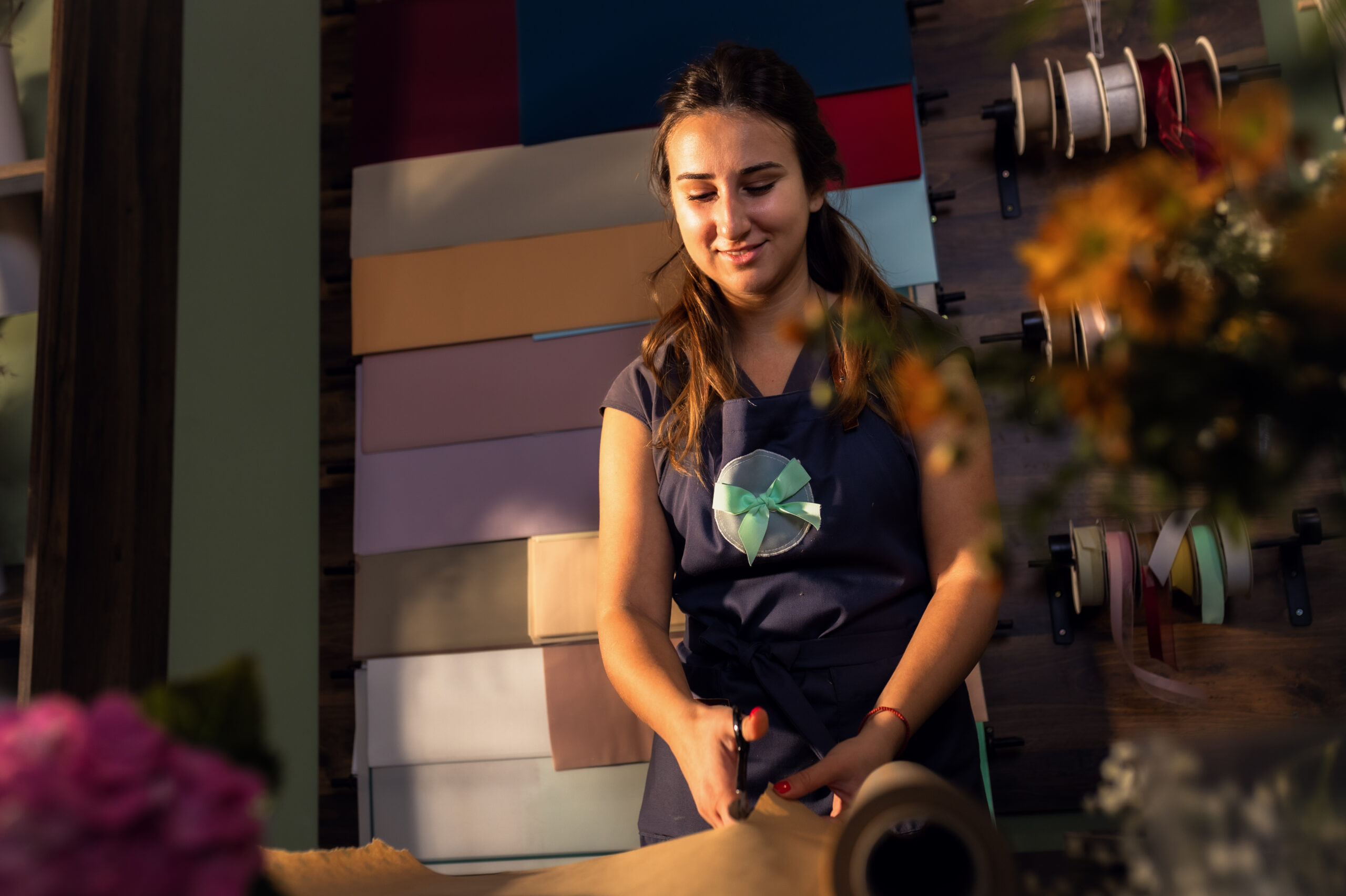
Vegan Fabrics
Introduction
In recent years, the fashion industry has undergone a remarkable transformation as consumers increasingly demand products that align with their ethical values and environmental concerns. At the forefront of this revolution is the meteoric rise of vegan fabrics—materials created without the use of animal products or byproducts. These innovative textiles are changing how we think about fashion, offering sustainable and cruelty-free alternatives that don’t compromise on quality, durability, or style.
What Are Vegan Fabrics and Why Are They Gaining Popularity?
Vegan fabrics encompass a wide range of materials produced without any animal involvement, making them a compassionate choice for the conscientious consumer. Unlike traditional textiles like leather, wool, silk, and fur, vegan fabrics rely on plant-based fibers, recycled materials, or innovative synthetic alternatives that mimic the properties of animal-derived textiles.
The growing popularity of these materials stems from several converging factors:
- Increased awareness of animal welfare issues in traditional textile production
- Growing environmental consciousness among consumers and brands
- Technological advancements enabling better quality alternative fabrics
- Celebrity endorsements and mainstream adoption of vegan fashion
- Rise of sustainable and ethical consumer movements demanding transparent supply chains
As younger generations wield increasing purchasing power, their preference for brands that reflect their values has accelerated the vegan fabric revolution. According to recent market research, the global vegan leather market alone is projected to reach $89.6 billion by 2025, with an annual growth rate of 49.9%.
Common Types of Vegan Fabrics Revolutionizing Fashion
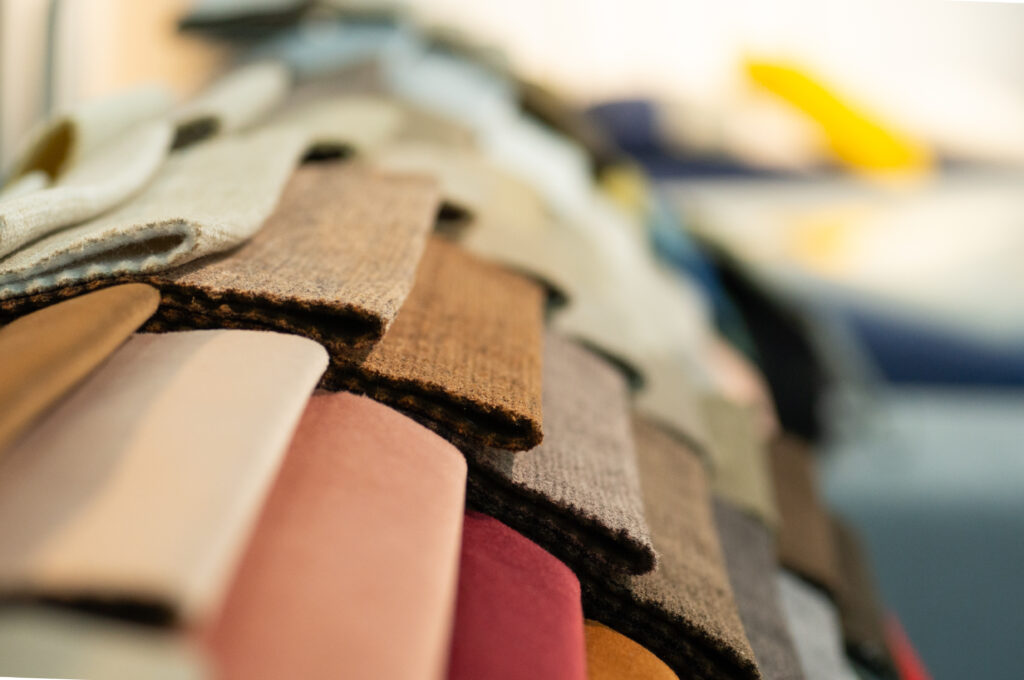
Plant-Based Vegan Leather Alternatives
Pineapple Leather (Piñatex)
One of the most innovative developments in vegan textiles comes from an unexpected source—pineapples. Piñatex, developed by Dr. Carmen Hijosa, is created from pineapple leaf fibers, a byproduct of pineapple harvesting that would otherwise go to waste. This ingenious material:
- Repurposes agricultural waste that would otherwise be burned
- Provides additional income to farming communities
- Creates a durable, flexible material with a natural leather-like texture
- Requires significantly less water and produces less pollution than animal leather
Major brands including Hugo Boss, H&M, and Nike have incorporated Piñatex into their collections, signaling its acceptance in mainstream fashion.
Apple Leather Vegan Fabrics
Another fruit-based innovation, apple leather utilizes the waste from apple juice and compote production. By combining apple waste with polyurethane, manufacturers create a material that closely resembles animal leather in both appearance and performance characteristics. This bio-based vegan leather:
- Reduces industrial food waste
- Decreases reliance on petroleum-based materials
- Creates a water-resistant, durable product
- Features the supple texture consumers expect from traditional leather
Luxury brands like Tommy Hilfiger have embraced apple leather for their sustainable collections, demonstrating its viability as a premium material.
Mushroom Leather (Mycelium)
Perhaps the most promising development in vegan fabrics comes from the fungal kingdom. Mycelium, the root structure of mushrooms, can be grown into customized shapes and textures that remarkably resemble animal leather. Companies like Bolt Threads with their Mylo™ material are revolutionizing luxury fashion by:
- Growing mycelium in controlled environments with minimal resources
- Producing leather alternatives that are biodegradable
- Creating materials that match or exceed animal leather in durability
- Offering customizable textures and finishes based on growth conditions
Stella McCartney, Adidas, and Lululemon have formed partnerships with mycelium leather producers, indicating the material’s significant potential to disrupt the traditional leather market.
Innovative Cellulose-Based Vegan Fabrics
Tencel and Lyocell
These wood-based fabrics represent a significant breakthrough in sustainable textiles. Made from sustainably harvested eucalyptus, beech, and other trees, Tencel and Lyocell offer remarkable benefits:
- Production in a closed-loop system that recycles 99% of water and solvents
- Biodegradability at end of life
- Exceptional breathability and moisture management
- Silky soft texture that rivals traditional silk
The versatility of these fabrics has led to their adoption across fashion categories from activewear to luxury apparel.
Orange Fiber
Italian company Orange Fiber has pioneered a method to transform citrus juice byproducts into a silk-like fabric. This innovative material:
- Diverts thousands of tons of citrus waste from landfills
- Creates a silky, lightweight fabric with natural sheen
- Can be blended with other materials for different applications
- Has been featured in collections by Salvatore Ferragamo and H&M
As the fashion industry seeks alternatives to silk, Orange Fiber represents a compelling sustainable option with minimal environmental impact.
Recycled and Upcycled Fabrics
Recycled PET (rPET)
One of the most widespread vegan fabrics comes from an unexpected source—plastic bottles. Recycled polyethylene terephthalate (rPET) transforms plastic waste into versatile textiles by:
- Diverting plastic from oceans and landfills
- Consuming 30-50% less energy than virgin polyester production
- Creating durable, washable fabrics suitable for numerous applications
- Reducing reliance on petroleum for new synthetic fibers
Brands from Patagonia to Adidas have embraced rPET, with some collections incorporating ocean plastic specifically to raise awareness about marine pollution.
Vegan Fabrics – Econyl
This regenerated nylon, made from fishing nets, fabric scraps, carpet flooring, and industrial plastic, represents a circular approach to fabric production. Econyl offers impressive sustainability credentials:
- Reduces waste in oceans and landfills
- Can be recycled infinitely without quality loss
- Reduces the carbon footprint of nylon by up to 90%
- Performs identically to virgin nylon in durability and elasticity
Swimwear brands particularly value Econyl for its resilience against chlorine, saltwater, and UV radiation, making it ideal for swimsuits that last multiple seasons.
Environmental Benefits of Choosing Vegan Fabrics
Reduced Carbon Footprint
The production of animal-derived materials contributes significantly to greenhouse gas emissions. Livestock farming alone accounts for approximately 14.5% of global greenhouse gas emissions according to the Food and Agriculture Organization of the United Nations. By contrast, most vegan fabrics have substantially lower carbon footprints:
- Organic cotton produces 46% less CO₂e than conventional cotton
- Plant-based leathers typically generate 33-95% fewer carbon emissions than animal leather
- Recycled fabrics can reduce carbon emissions by up to 80% compared to virgin materials
As brands and consumers become more climate-conscious, the carbon advantages of vegan fabrics make them increasingly attractive options for sustainable fashion collections.
Water Conservation
Traditional textile production is notoriously water-intensive. For example:
- Producing one kilogram of cotton requires approximately 20,000 liters of water
- Leather tanning consumes massive quantities of water and contaminates local water supplies
- Wool processing includes multiple water-intensive cleaning and treatment steps
Many vegan fabrics offer dramatic improvements in water efficiency:
- Hemp requires 50% less water than conventional cotton
- Lyocell production recycles 99.5% of process water
- Pineapple and apple leather require minimal additional water beyond what’s used in fruit production
In regions experiencing water stress, shifting to less water-intensive vegan fabrics represents a significant opportunity to reduce fashion’s hydrological footprint.
Reduced Chemical Pollution
Conventional textile production involves numerous toxic chemicals that threaten ecosystems and human health. The leather industry in particular uses chromium, formaldehyde, and other hazardous substances in the tanning process. By contrast, many vegan fabrics:
- Utilize non-toxic dyes and processing chemicals
- Avoid the heavy metals associated with leather tanning
- Employ closed-loop manufacturing systems that prevent chemical release
- Use organic certification standards that prohibit harmful pesticides and additives
As consumers become more aware of the chemical impact of their clothing choices, vegan fabrics with transparent and less toxic production methods gain market advantage.
Challenges and Future Developments in Vegan Fabrics
Current Limitations
Despite their numerous advantages, vegan fabrics still face challenges that the industry is working to overcome:
- Biodegradability concerns: Some synthetic vegan alternatives, particularly those incorporating polyurethane or PVC, don’t biodegrade and may release microplastics during washing.
- Scale and cost issues: Many innovative plant-based materials remain relatively expensive and limited in production capacity compared to conventional fabrics.
- Performance gaps: While improving rapidly, some vegan alternatives don’t yet match all the performance characteristics of their animal-derived counterparts.
- Greenwashing risks: As vegan fabrics gain popularity, misleading marketing claims about sustainability credentials have become more common.
Promising Innovations on the Horizon for Vegan Fabrics
The future of vegan fabrics looks exceptionally bright, with several groundbreaking developments poised to address current limitations:
Bio-Based Synthetic Polymers
Researchers are developing polyesters and nylons derived from plant sugars rather than petroleum, offering biodegradable alternatives to traditional synthetic fabrics. These materials maintain the performance characteristics consumers expect while dramatically reducing environmental impact.
Advanced Mycelium Technologies
Next-generation mycelium materials are being engineered with enhanced durability, water resistance, and specialized properties. Some developers are creating programmable mycelium that can be grown to exact specifications, potentially revolutionizing personalized fashion.
Agricultural Waste Transformation
Beyond pineapple and apples, researchers are exploring dozens of agricultural waste streams—from coffee grounds to banana peels—as potential fabric sources. These approaches align circular economy principles with fashion production by converting waste into valuable materials.
Algae-Based Textiles
Several startups are developing textiles derived from algae, which can be grown with minimal resources and actually absorb carbon dioxide during production. These materials offer exceptional sustainability credentials and novel aesthetic properties for designers.
How to Incorporate Vegan Fabrics into Your Wardrobe
Reading Labels and Identifying Vegan Materials
Becoming a conscious consumer starts with understanding how to identify vegan fabrics when shopping:
- Look for explicit “vegan certified” or “animal-free” labeling
- Check composition tags for plant-based materials like cotton, linen, hemp, or innovative alternatives
- Research brands’ material sourcing policies on their websites
- Use apps like Good On You or Wear The Change that rate brands on animal welfare criteria
- Be wary of generic “eco-friendly” claims without specific material information
Many brands now provide detailed material information and sustainability metrics directly on product pages, making it easier than ever to make informed choices.
Caring for Vegan Fabrics to Maximize Longevity
Proper care significantly extends the lifespan of vegan fabrics, enhancing their sustainability benefits:
- Follow specific care instructions for each material type
- Use cool water washing and natural detergents to preserve fibers
- Air dry when possible to reduce energy consumption and fiber damage
- Store plant-based leathers away from direct sunlight to prevent fading
- Apply appropriate conditioners to maintain the flexibility of vegan leathers
- Repair small damages promptly to prevent further deterioration
By extending the wearable life of vegan garments, consumers multiply the environmental benefits of their purchasing decisions.
Brands Leading the Vegan Fabric Movement
Several pioneering brands have made vegan fabrics central to their identity:
- Stella McCartney: A luxury pioneer in vegan fashion, consistently innovating with mushroom leather, recycled nylon, and plant-based alternatives
- Pangaia: Combines science and sustainability with materials like seaweed fiber, wildflower down alternatives, and grape leather
- Veja: Creates popular sneakers using innovative materials like C.W.L. (Corn Waste Leather) and B-mesh made from recycled plastic bottles
- Matt & Nat: Specializes in vegan leather accessories made from recycled materials with recycled nylon linings
- Reformation: Offers transparent sustainability reporting alongside clothing made from Tencel, organic cotton, and recycled fabrics
These brands demonstrate that vegan fabrics can succeed at all market levels, from affordable basics to luxury statement pieces.
Conclusion: The Future Is Vegan
The rise of vegan fabrics represents more than just a passing trend—it signals a fundamental rethinking of how textiles are produced and consumed. As technological innovation continues to improve the quality, availability, and cost of these materials, we can expect their adoption to accelerate across the fashion industry.
For consumers, the expanding range of vegan fabrics means greater choice without compromise. Today’s vegan textiles offer performance, aesthetics, and durability that rival or exceed their animal-derived counterparts, all while aligning with values of environmental protection and animal welfare.
Fashion brands that embrace these materials gain competitive advantage through reduced environmental risk, positive brand associations, and resilience against increasing regulation of high-impact materials. The most forward-thinking companies are already integrating vegan fabrics into their core product lines rather than treating them as specialty offerings.
As we look toward a more sustainable fashion future, vegan fabrics will undoubtedly play a central role in transforming one of the world’s most resource-intensive industries into a force for positive change. By choosing these innovative materials, we can all contribute to this important transformation—one garment at a time.

Amazon Two-Piece Set
I was super excited when I found this adorable two-piece set for only $19. The 2-piece linen set is from Tankaneo, a brand that focuses on combining fashion with comfort. Two-piece sets are my go-to for quick and easy outfits, especially when I have nothing in mind to wear that day. I found that this outfit paired perfectly with some pointed toe flats that I also found on Amazon for just around $31. This was actually a decent priced shoe being that the style is trending right now, according to Who What Wear. In this post, I will provide an in-depth review of the amazon two-piece linen set from Tankaneo.
In Depth Review
For Reference: I am 5’5 and 162lbs and ordered a size Medium.
Rating: ⭐⭐⭐⭐☆ (4.5/5)
First Impressions of Amazon Two-Piece Set:
The packaging was neat, and right out of the bag, the linen fabric felt light and breathable. It does come with a bit of that typical linen wrinkle, but that’s just the nature of the fabric – nothing a light steam couldn’t fix.
Fit & Comfort:
The fit was just right. The vest is sleeveless and has a cute, structured cut that buttons up nicely without pulling across the chest. The wide-leg pants are the real star here – super comfortable with a flattering flow that doesn’t cling in all the wrong places. It has an elastic waistband in the back, so there’s some flexibility if you’re between sizes.
Amazon Two-Piece Set Style Points:
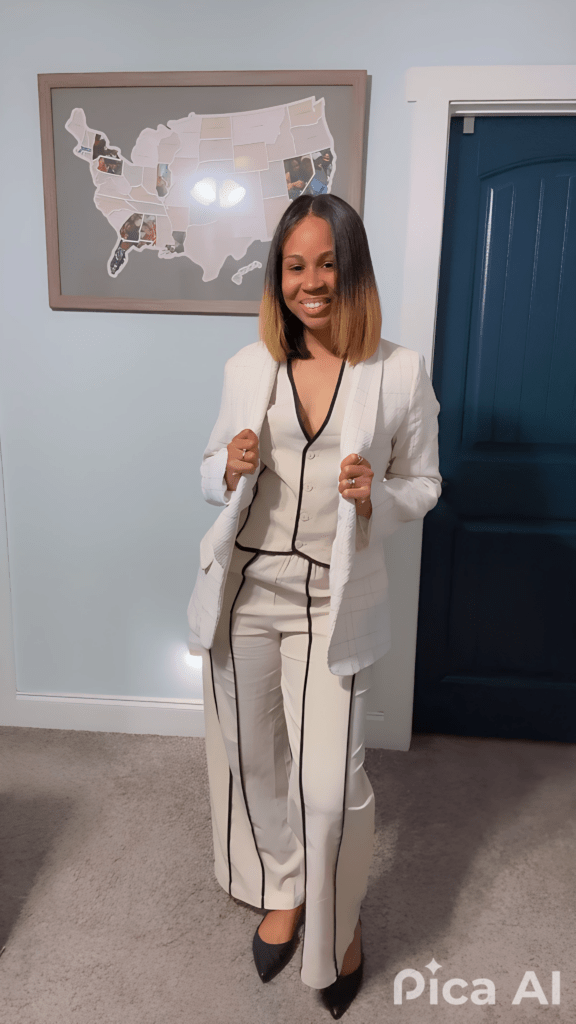
I got the beige set, and it looks way more expensive than it actually is. I wore it to work with a blazer and pointed toe flats. I’ve already worn it to brunch with some gold jewelry and flat sandals – got compliments from three people. You can also totally dress it down with sneakers and a messy bun for an effortlessly cool errand-day look.
Other Ways to Style a Two-Piece Set
Wear it as-is (obvious but classic)
- For casual: Throw on sneakers or slides, add a denim jacket or oversized cardigan, and keep accessories minimal.
- For elevated vibes: Add heels or wedges, statement jewelry, and a sleek clutch or crossbody bag.
Amazon Two-Piece Set Break it up
Top with different bottoms:
- Pair the top with high-waisted jeans, a midi skirt, or tailored trousers.
- Add a belt or tuck it in for shape.
Layer it up
- Blazers: Makes a set look polished for work or events.
- Oversized sweaters: Pull over the top and let the skirt/shorts peek out.
- Button-downs: Wear open over the top or under it for a layered look.
Switch up the shoes
- Sneakers: Casual and comfy.
- Boots: Adds edge, especially with a skirt set.
- Heels: For brunch, date night, or dinner with friends.
- Sandals: Perfect for spring and summer—go strappy or chunky.
Amazon Two-Piece Set Linen Love (but with a Caveat):
As with most linen, it wrinkles easily, so don’t expect it to stay crisp all day. Also, I noticed the fabric is just slightly sheer in direct sunlight – not scandalous, but you’ll probably want nude-colored undergarments just to be safe.
Wash Test:
Washed it on cold and hung it to dry – it held up great. No shrinkage, no fading. Definitely avoid the dryer though.
Final Thoughts:
If you’re looking for a versatile, stylish outfit that feels like pajamas but looks like something out of a lifestyle influencer’s closet, this set is a win. It’s perfect for warm weather, vacations, or even working from home in style. Just be prepared to iron (or embrace the lived-in linen vibe)!
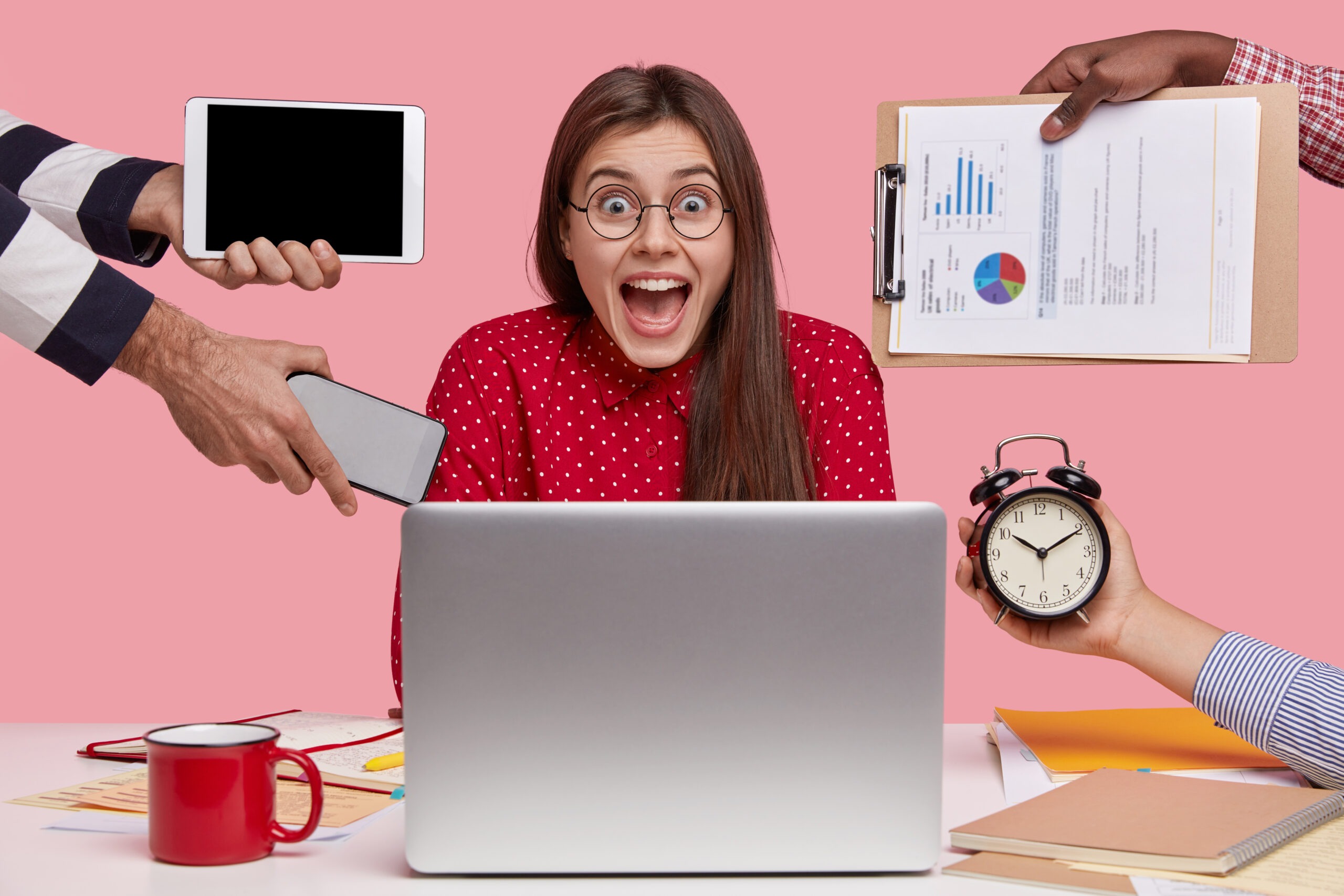
Self-Care Routines for Busy Women
Introduction
I think I would consider myself busy. Let’s take some inventory. So, there’s parenting, work, school (because I decided to go back to college in my 30s), blogging, my social life (lacking at best) and other obligations that are too many to name. With that being said, I feel like I hardly have time to breathe, let alone have a self-care day! When you think of self-care, what is the first thing that comes to your mind? My initial thoughts were spa days, long meditations, yoga, a full day of thrifting (alone)! Oh, thrifting makes me so happy! But guess what? Self-care does not have to be that intricate. Sometimes, just five intentional minutes can make a huge difference in your day. In this blog post, we’ll explore simple yet powerful 5-minute self-care routines for busy women that can be squeezed into the busiest of schedules. These bite-sized practices can help you feel more grounded, energized, and in control, even on your most hectic days.
Why Are Self-Care Routines Important for Busy Women?
Think about this for a minute. When you feel overwhelmed, do you sometimes take it out on someone you love? It’s okay, we all do. The truth is, when we do not prioritize our well-being, it affects the people around us. We’ve all heard the cliché “self-care isn’t selfish.” It’s a cliché for a reason. It is true. I strongly believe that we need that time to unwind, especially being parents all while trying to manage our professional lives. When you prioritize your well-being, you’re not just doing it for yourself. You’re showing up better for your family, friends, career, and everything else on your plate. But why does it feel so hard to make time for self-care?
Common Barriers to Self-Care:
- Guilt: Feeling bad for taking time away from responsibilities.
- Time constraints: Busy schedules that leave no room for “extras.”
- Perfectionism: Believing self-care must be done perfectly or not at all.
Hi there perfectionist! I am talking to you. Self-care doesn’t require a full afternoon. It just needs intention.
Disclosure: Some of the links in this post are ‘affiliate links’. This means if you click on the link and purchase the item, I will receive an affiliate commission.
Morning Boost: Start Your Day with Intention
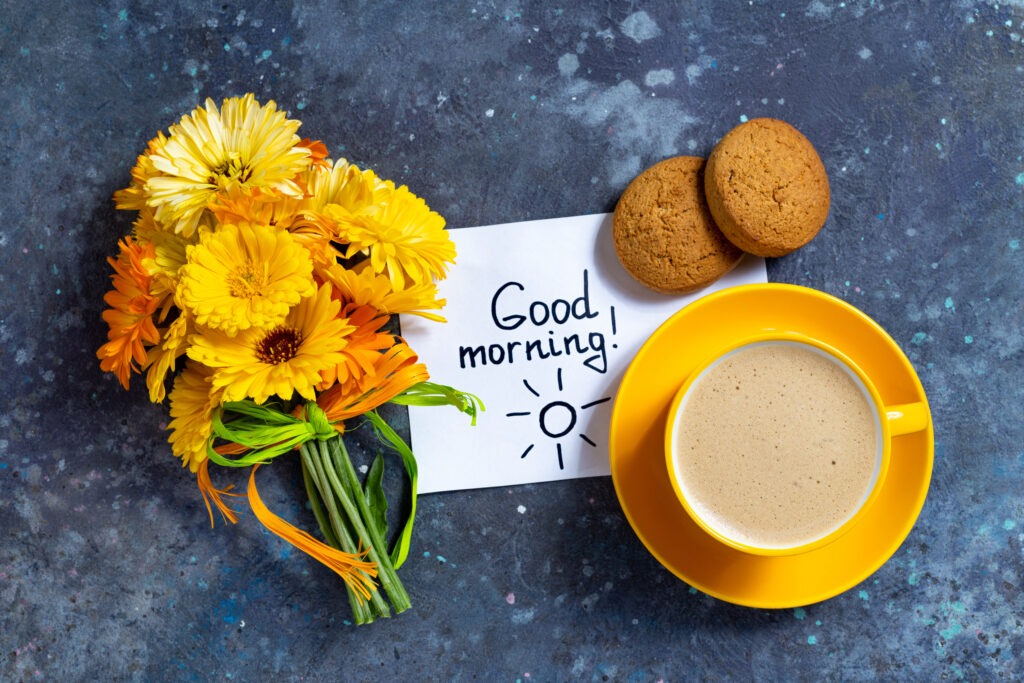
What can you do right after waking up?
How you begin your day sets the tone for everything that follows. Starting with even one mindful minute can shift your mindset.
Simple Self-Care Morning Routine Ideas:
- Stretch while still in bed: Wake up your body gently.
- Say an affirmation: “Today, I choose calm and clarity.”
- Write down 3 things you’re grateful for: Start with positivity.
- Drink a full glass of water: Hydrate before anything else.
These micro-habits energize your body and mind—no caffeine required (though you can still enjoy your morning coffee!).
Self-Care Routines for Busy Women – Midday Mindfulness
Around midday, energy dips and stress levels rise. This is a perfect time to take a few moments to reset.
Quick Mental Reset Techniques:
- Breathing exercise (box breathing): Inhale for 4 seconds, hold for 4, exhale for 4, hold for 4. Repeat.
- Close your eyes for one full minute: Helps reduce sensory overload.
- Step outside for fresh air: Even a walk to the mailbox helps.
Pro tip: Step outside without your phone so you can be free of any screentime. Studies show that just a few moments away from your screen can improve focus and lower stress levels.
Beauty Rituals That Fit into a Busy Schedule
Beauty and grooming routines aren’t just about appearance—they are form of self-care.
Speedy Self-Care Beauty Routines for Busy Women:
- Apply a hydrating face mask or serum: Refreshes tired skin.
- Massage your hands with lotion: Soothing and practical.
- Comb your hair mindfully: Turn a basic act into a mini ritual.
You don’t need a full routine—just small, intentional touches that make you feel like you’re taking care of yourself.
Emotional Check-In: Make Space for Your Feelings
When was the last time you checked in with yourself?
It’s easy to ignore emotions when life is busy. But giving yourself five minutes to process your feelings can prevent burnout and improve your emotional well-being.
Emotional Self-Care Routines for Busy Women:
- Journal a few quick thoughts: No rules—just let it out.
- Name your emotion: “I feel overwhelmed right now.”
- Talk to yourself like a friend: Offer kindness, not criticism.
Acknowledging your emotions helps you to understand your triggers and when you know your triggers, you can work through them.
Wind Down Before Bed
Product Recommendation
Choose the Appropriate Response
What’s the last thing you do before calling it a night?
How can you create a calming bedtime habit?
Ending your day with intention is just as important as how you start it. Your nighttime ritual doesn’t have to be long or complicated.
5-Minute Bedtime Wind-Down Ideas:
- Put your phone on ‘Do Not Disturb’: Reduce mental noise.
- Light a candle or use essential oils: Signal your brain that it’s time to relax.
- Listen to calming music or a short meditation: Let go of the day.
Even a short bedtime ritual tells your body it’s safe to rest—and helps improve the quality of your sleep.
Conclusion
Self-care doesn’t have to mean hours at the gym or booking a massage every week (although that does sound lovely). It’s about showing up for yourself—even in the smallest ways—every single day. These 5-minute self-care habits are designed for busy women who need quick, nourishing practices to help them feel more grounded, refreshed, and ready to take on whatever life throws their way.
You deserve to feel cared for, too. Start with just five minutes today. Let me know in the comments if you gained any insight from this post!
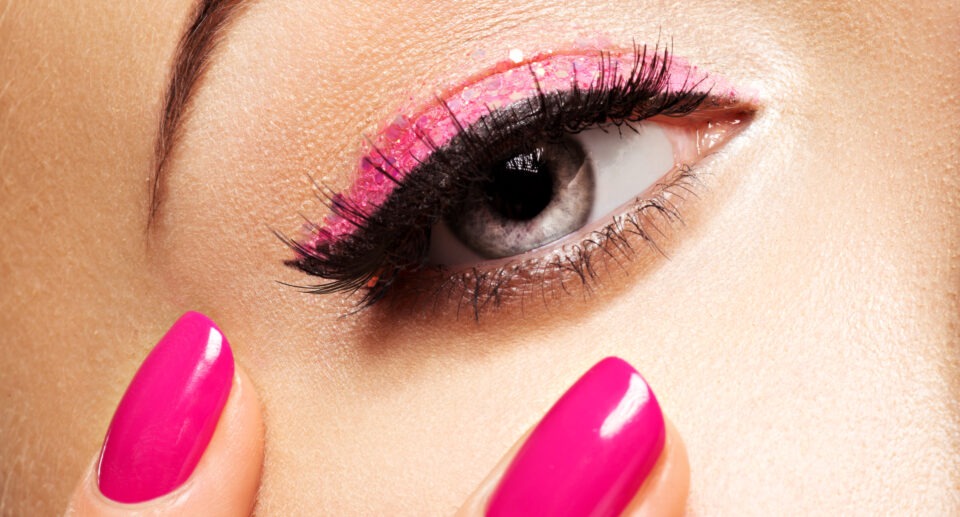
How to Apply Nail Polish
Hi fabulous reader! So, I decided to put this DIY nail polish tutorial together to help others with their manicure game. I have been trying to save some money this year and decided that I am no longer going to the nail salon and spending tons of money to get my nails to look pretty. Looking “put together” does not have to be expensive! As long as your manicure looks clean, you are good to go! I honestly have never been good at polishing my nails, but I found this cool little hack that limits the mess and makes your nails look super clean when finished! Let’s dive into this easy step by step guide on how to apply nail polish without all the extra mess!
Preparing Your Nails
So, first things first. You need to prep your nails.
Clean and Remove Old Polish
Start by using a non-acetone nail polish remover to eliminate any leftover polish. Even if there’s no visible polish, wipe your nails down to remove natural oils that can prevent polish from adhering properly.
Trim, File, and Shape
Use nail clippers to trim nails to your desired length. Then, gently file in one direction to avoid splitting and shape according to your preference.
How to Apply Nail Polish – Push Back Cuticles
Soak your hands in warm water for a few minutes. Gently push back your cuticles with a cuticle pusher. Avoid cutting them, as this can lead to infections or irritation.
Buff the Nail Surface
Use a nail buffer to lightly smooth out ridges and create an even surface. This helps polish adhere better and appear smoother.
This is where magic happens!
Add Liquid Peel Off Cuticle Guard
A liquid peel-off cuticle guard is like a little safety net for your skin when you’re doing your nails—it goes on as a liquid and dries into a barrier around your nails. It is only about $7 on Amazon! Go grab it here. When you’re done painting, you just peel it off and all the messy edges come off with it, leaving your manicure clean and sharp.
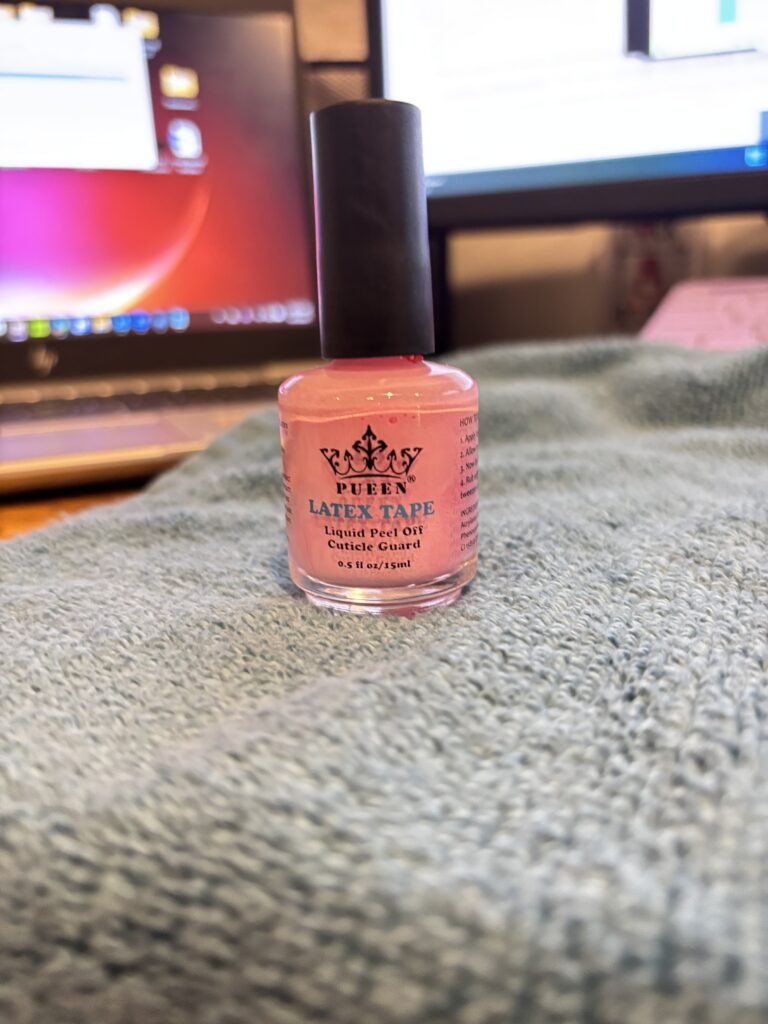
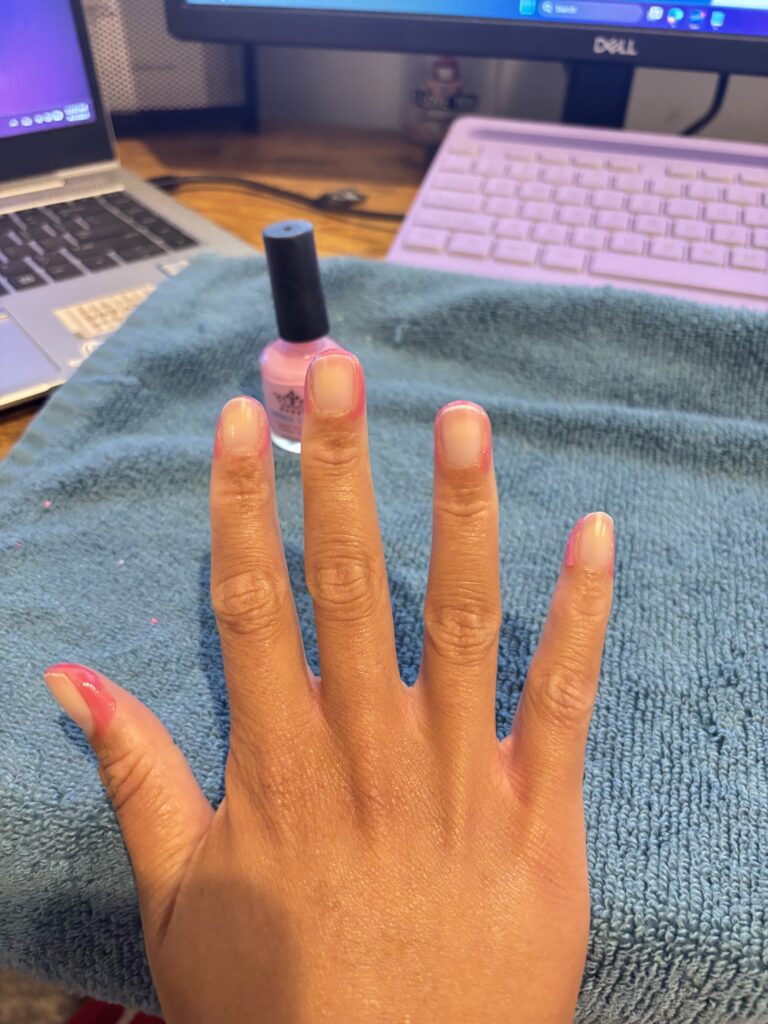
When doing this step, it is important to keep the application very light. If you apply too much, the liquid will get on your actual nail bed and strip away the polish from there. Go very light! Ok, next!
How to Apply Nail Polish – Base Coat
My first instinct has always been to skip this step because I thought it was too much work but it has its benefits. A base coat:
- Prevents staining, especially with dark colors
- Improves adhesion for your polish
- Creates a smooth foundation for color application
Apply a thin layer so that it can dry quicker. Let it dry completely before moving on.
Apply Two Coats of Color
Now for the fun part! Applying your nail polish. Shake the bottle before you begin. Start with a thin application. Focus on the center of your fingernail then gently swipe the polish toward the sides. Allow the first coat to dry.
Disclosure: Some of the links in this post are ‘affiliate links’. This means if you click on the link and purchase the item, I will receive an affiliate commission.
As you can see below, I used my portable heater to dry my nails then I looked on Google and realized that this was not a good idea. Please don’t judge me, I was trying to be thrifty. Lol. Use a fan or just blow your nails dry. Let the first coat dry first before moving on to the second coat.
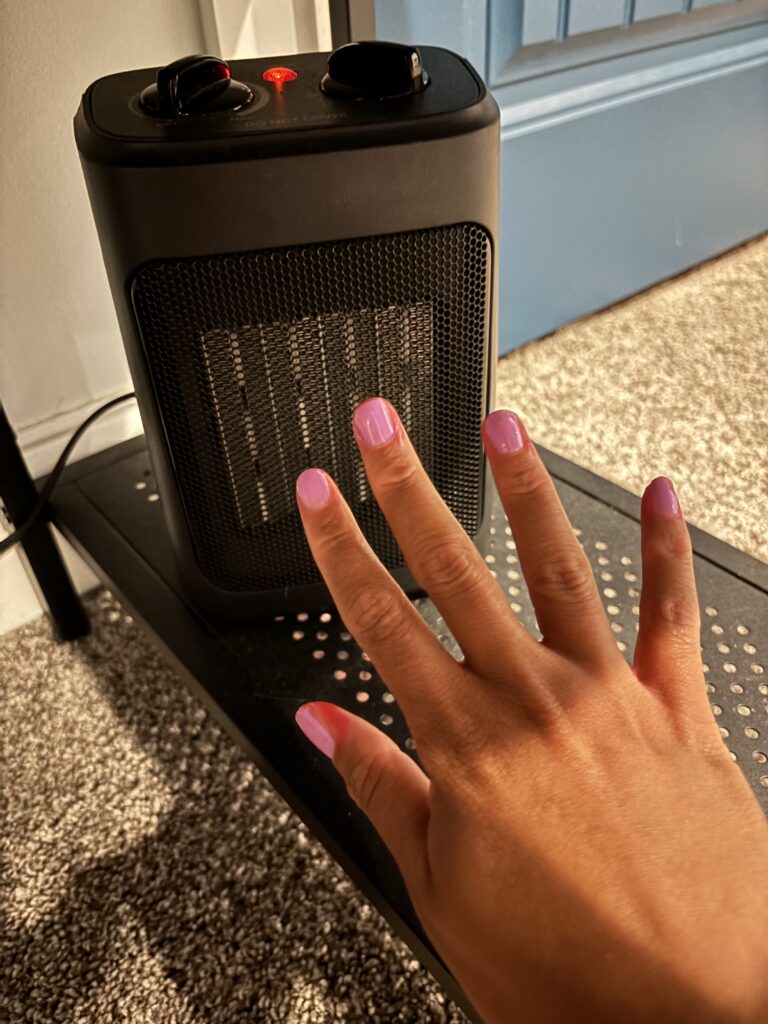
Pro tip: Wait 2–3 minutes between coats to prevent bubbling and smudging. Two coats of color are usually ideal for full opacity.
How to Apply Nail Polish – Finish with a Protective Top Coat
A top coat locks in your color, adds shine, and prevents chips.
- For a glossy look, choose a high-shine formula.
- For a matte finish, pick a matte top coat
- Reapply every two to three days to extend the life of your manicure.
Don’t forget to cap the edge of each nail by running the brush across the tip—this seals the color and reduces chipping.
Remove Liquid Peel Off Cuticle Guard and Clean up Mistakes
The cuticle guard comes with a little tool that you can use to remove the liquid gel. The gel will turn clear pink when it’s dry. For final touches, clean up the edges of your polish. Clean up using:
- An angled brush dipped in acetone
- A cotton swab for larger smudges
- A corrector pen for quick fixes on-the-go
Precision matters, especially for maintaining a clean, professional look
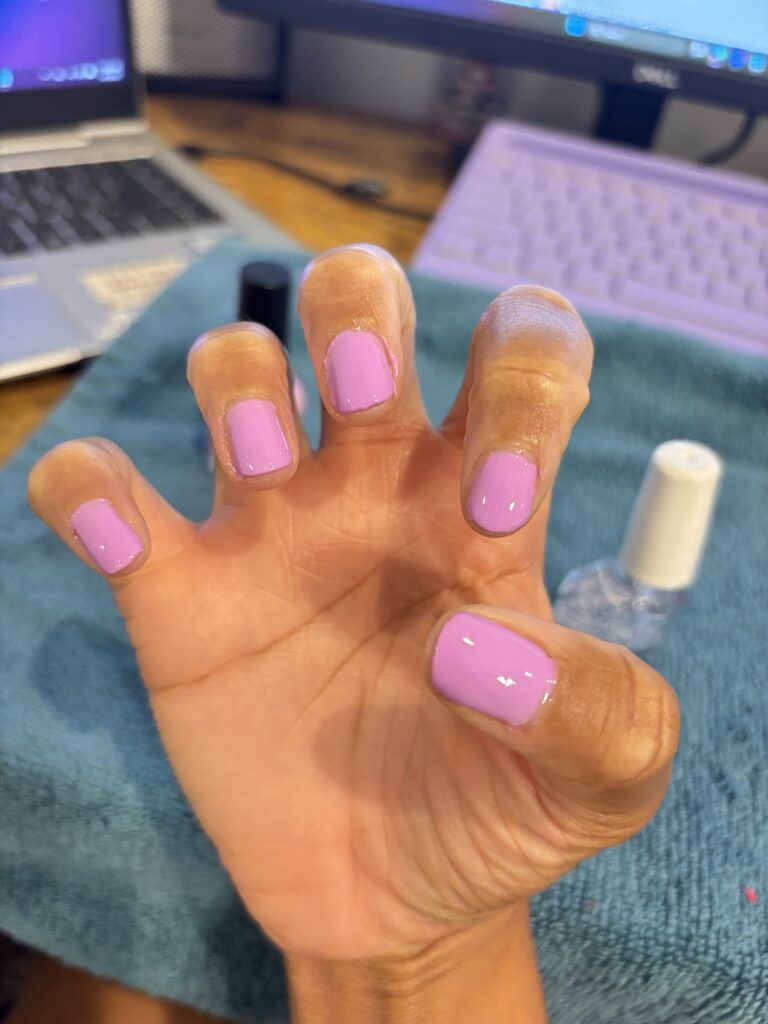
How to Maintain Your Manicure for Long-Lasting Wear
Keep your nails looking fresh by:
- Moisturizing your cuticles daily with oil or cream
- Wearing gloves while cleaning or doing dishes
- Avoiding excessive water exposure
- Reapplying your top coat every few days
With proper care, manicure can last up to 7–10 days without chips.
Common Mistakes to Avoid When Applying Nail Polish
Avoiding these pitfalls can dramatically improve your results:
- Skipping base or top coat
- Applying thick layers of polish
- Not allowing polish to dry between coats
- Shaking the bottle too vigorously (causes bubbles)
- Using expired polish that’s too thick or separated
Take your time—patience is key to a flawless application.
Pro Tips for How to Apply Nail Polish
- Store nail polish upright in a cool, dry place to preserve consistency.
- Warm polish in your hands before use if it’s too thick.
- Use a latex barrier around nails to catch stray strokes during application.
- Invest in salon-quality tools—they make a noticeable difference.
Other Products Used
Conclusion
I hope you enjoyed this post about how to properly apply nail polish without the mess. It seems simple but with my years of experience, I realized that applying nail polish properly is both an art and a science. Be gentle with your application and remember that preparation is key to achieving long-lasting results. Set out some time dedicated time throughout your day to do this as it can take some time and patience when you are first getting started. Invest in affordable products to start. Do not overthink the process and most importantly have fun with it! Let me know in the comments if you gained any insight from this post. I would love to hear from you!
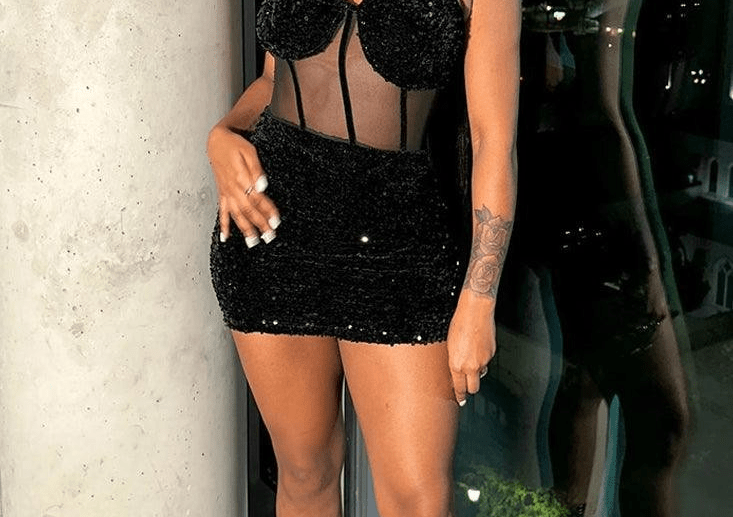
Outfit Ideas Clubbing
Stepping into your 30s doesn’t mean your nights out have to lose their spark—it means you’ve mastered the art of confident, refined style. When it comes to clubbing outfit ideas for women in their 30s, the sweet spot lies between elevated elegance and nightlife-ready allure. Whether you’re heading out with your girlfriends or on a date night to a chic lounge, your outfit should feel modern, flattering, and age-appropriate without sacrificing style. Here’s your go-to guide for dressing to impress at the club!
Elegant and Chic Clubbing Outfits for Women in Their 30s
1. Sleek Bodycon Dresses with a Grown-Up Twist
The bodycon dress remains a timeless piece, but in your 30s, it’s about polish over flash. Opt for versions with long sleeves, midi lengths, or high necklines—details that offer elegance while still highlighting your figure. Rich tones like emerald, green, burgundy, navy, or deep plum elevate the look. Style with pointed-toe pumps or heeled mules and a structured clutch for a sophisticated finish.
Shop: Velvet Long Sleeve Fitted Maxi Dress | Black Sequins One Shoulder Dress | Mesh Layered Lining Dress | Cecily Teddy Velvet Corset Maxi Dess
2. Sophisticated Matching Sets
Matching two-piece sets are super stylish. Think silky wide-leg trousers with a matching cami, or a blazer and shorts in luxe materials such as velvet or satin. These looks let you easily mix and match pieces for multiple nights out. Accessorize with layered necklaces or gold hoops to keep the style elegant.

3. Jumpsuits: One-Piece Wonders
A tailored jumpsuit is a power move for nights out. Opt for designs with plunging necklines, open backs, or belted waists to highlight your figure. Neutral shades like black, cream, or metallics make a big impact without trying too hard. A leather clutch and drop earrings polish off the look perfectly.
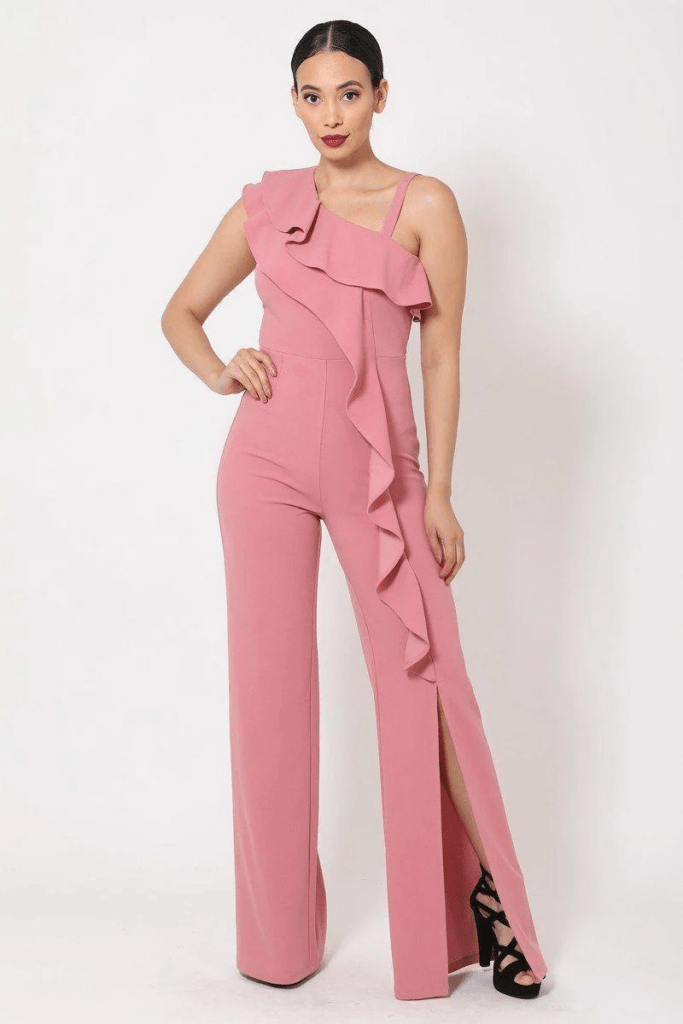
Shop: One Shoulder Ruffle Jump Suit
4. Elevated Leather Pieces
Faux leather skirts, high-waisted leather pants, or even a leather blazer can bring chic edginess to your clubbing style. Pair a leather midi skirt with a silky blouse, or wear leather trousers with a fitted bodysuit for sleek, mature glamour. This look balances cool and classy, especially when paired with heeled ankle boots or slingback heels.
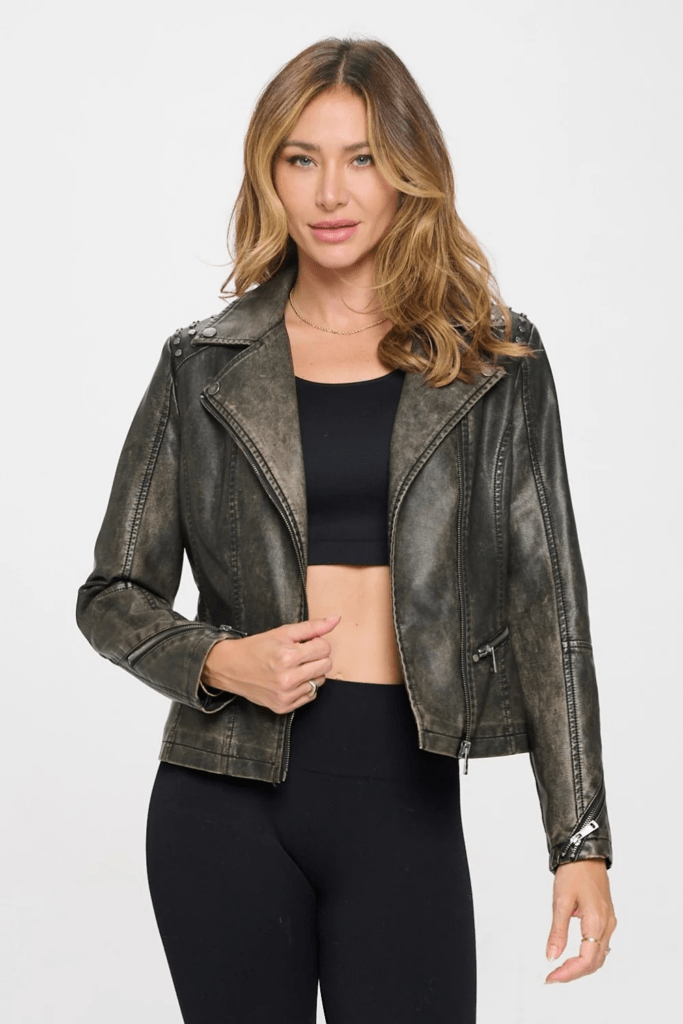
Shop: Coalitional LA Studded Classic Moto Faux Leather Jacket
5. Subtle Sheer and Mesh Accents
When dressing up for a night out in your 30s, sheer doesn’t mean overly revealing—it means strategic layering. Try a mesh top over a lace bralette, or a dress with sheer sleeves or panels that show a tasteful hint of skin. These details are playful but polished, making you look effortlessly stylish and self-assured.
What to Wear Based on Club Vibes
Upscale Lounge or Rooftop Bars

Shop: Pink Sequin Blazer
Go for a midi dress with a structured blazer, or a satin cami and high-waist trousers. Keep your palette neutral or jewel-toned, and wear pointed heels or slingbacks.
Trendy Cocktail Clubs Outfit Idea
Try a printed mini wrap dress, a statement jumpsuit, or a co-ord set in silk or satin. Add bold earrings and a textured clutch.
Dance-Heavy Nightclubs
Comfort meets style: think form-fitting bodysuits, high-rise shorts or skirts, and block heels. Opt for stretchy materials that allow movement without losing structure.
Top Footwear Choices for Women in Their 30s
- Block heels – Stylish, stable, and perfect for dancing
- Pointed-toe stilettos – Elegant and elongating
- Heeled ankle boots – Add edge and support
- Mules or kitten heels – For fashion-forward minimalism

Shop: Nude Heels
Avoid overly casual footwear like flip-flops or worn-out sneakers unless the venue allows it.
Accessories That Elevate the Look
- Statement Accessories
- Minimalist gold or silver jewelry adds an expensive touch.
- Choose sleek leather crossbody bags or structured clutches.
- Go bold with a red lip, cat-eye liner, or glossy waves.
- Subtle Details
- A wristwatch, delicate chain bracelet, or designer belt can be subtle but powerful.
- Spritz on a signature fragrance that lingers long after you’ve left the room.
Seasonal Clubbing Outfit Ideas for Women in Their 30s
Spring/Summer
- Flowy wrap dresses, linen co-ords, or cami tops with wide-leg trousers
- Lightweight blazers or kimonos for layering
- Go for nude tones, pastels, or bold prints
Fall/Winter
- Long-sleeved midi dresses, leather leggings, or tailored jumpsuits
- Add faux fur jackets, wool capes, or oversized blazers
- Boots with heels or chic ankle booties complete the cozy-cool vibe
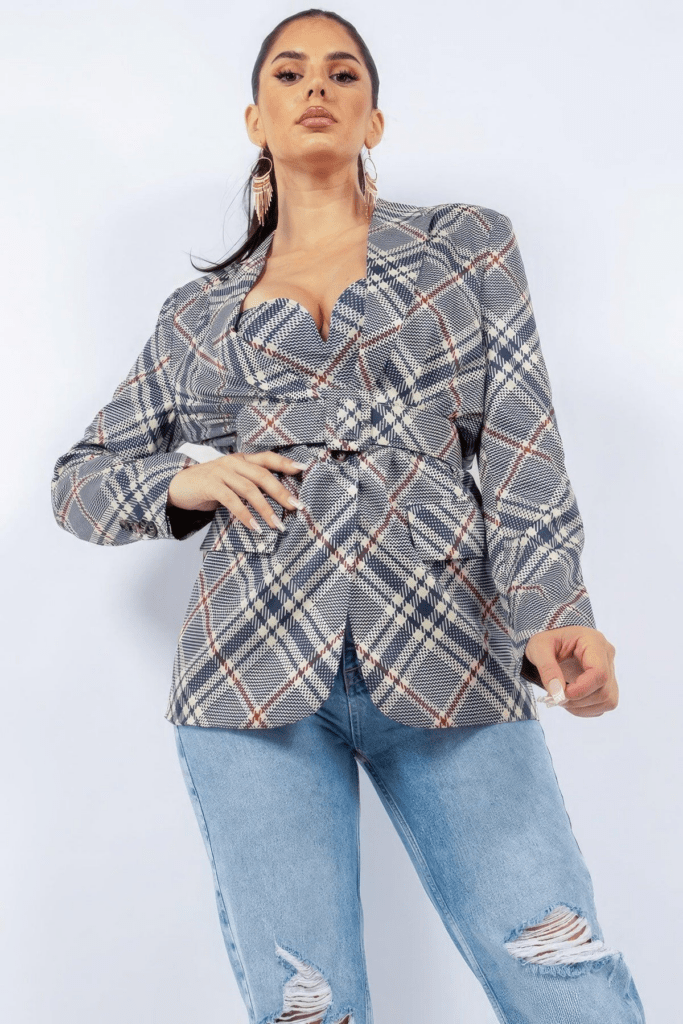
Color Palettes That Pop for 30-Something Women
- Neutrals with depth: taupe, charcoal, navy
- Earth tones: olive green, rust, terracotta
- Bold classics: red, sapphire blue, gold
- Metallic accents: add drama with shimmer in small doses
Final Clubbing Style Tips for Women in Their 30s
- Comfort is queen: Choose outfits you can dance and move in confidently.
- Less is luxe: Don’t over-accessorize. A few intentional pieces go a long way.
- Invest in fit: Tailoring makes all the difference in how you feel and look.
- Exude confidence: The most powerful outfit addition is self-assurance.
Your 30s are the perfect time to refine your personal style, invest in high-quality wardrobe staples, and embrace your elegance. Whether you’re keeping it classic or going bold, your clubbing outfits can—and should—be a celebration of your unique energy and maturity.

Delusional Optimism
You are probably reading the title of this post wondering why on earth would someone want to live a life of delusion? The thing is, we’ve all been told to “stay grounded,” “be realistic,” or “don’t get your hopes up.” But what if the key to joy, resilience, and success lies not in practicality—but in a bold, borderline delusional belief in the best possible outcome? This concept, known as Delusional Optimism, is based on the idea that a little healthy detachment from reality might be exactly what we need to thrive. In this article, we’ll explore what delusional optimism really means, why it can be a surprisingly powerful mindset, and how you can use it to inject more joy, courage, and creativity into your daily life.
What is Delusional Optimism?
Delusional optimism is the act of maintaining a positive outlook, even when reality seems to suggest otherwise. Don’t get me wrong, it’s not about ignoring your problems or pretending everything is perfect. Instead, it’s about choosing to believe in possibility, even when logic says you shouldn’t.
Is It Really Delusional?
In a sense, yes. Delusional optimism can involve believing in your dreams or outcomes that most would call unrealistic. But here’s the twist: those “unrealistic” beliefs often motivate people to take action, persevere longer, and reach goals that seemed impossible. Ever heard of manifestation? It is the idea that you can cosmically attract success with positive self-talk and visualization. Delusion is like the visualization aspect of manifestation. According to Dr. David Hamilton, in his article on visualization, your brain is not able to distinguish real from imaginary. If you imagine yourself crossing a finish line and continue to do so for years, you are ultimately tricking your brain into believing that it has already happened. Success becomes second nature once you start living the life that you have already manifested.
The Surprising Benefits of Delusional Optimism
Many of history’s greatest visionaries were delusional optimists. Think about it: would the Wright brothers have built a flying machine if they listened to “realists”? Would Oprah Winfrey have become a media mogul if she had accepted her early failures as final?
1. Increased Resilience
Believing things will work out gives you the emotional strength to keep going, even when things get tough. If you see yourself acting with strength, rather than weakness, you will begin to believe that you are strong enough to get through whatever barrier you are facing.
2. More Creativity
A delusionally optimistic mindset frees you from the mental box of what’s “possible,” allowing for wild ideas and innovation.
3. Greater Joy
Constantly expecting doom and gloom drains your energy. Optimism—even if a little exaggerated—keeps your spirits lifted.
4. Attracting Opportunities
Optimistic people tend to be more open, approachable, and willing to take risks—which often leads to more opportunities. If you want to take on a new task or project, you may feel like you are ill-prepared in real life, but with delusional optimism, there are no limitations. Having this mindset will give you the courage that you need to take on new and exciting opportunities.
Delusional Optimism vs. Toxic Positivity
You might be wondering: isn’t this just toxic positivity in disguise?
Not at all. Delusional optimism isn’t about denying pain or pretending everything is okay. It’s about holding onto hope even in the mess. It says, “Yes, things are hard—but I still believe in good outcomes.”
How to Be a Dreamer Without Losing Touch
You can be a dreamer without being disconnected. Here’s how:
1. Anchor Your Optimism in Purpose
Delusional optimism is most effective when it’s tied to a meaningful goal. Want to start a business even though you’ve failed before? Believe in it anyway—but do it with a plan.
2. Surround Yourself With Encouragers
Being around people who cheer for you—even when your goals sound crazy—helps keep your optimism alive.
3. Limit Exposure to Negative Influences
Too much time with cynics can kill your spark. Curate your social feed and conversations to protect your mindset.
4. Take Bold but Strategic Risks
Delusional optimism is about belief and action. Don’t just hope—move. Take the leap, even if you’re scared.
Delusional Optimism in Everyday Life
You don’t need to launch a tech company or become an astronaut to benefit from delusional optimism. You can use it in your day-to-day life:
- Dating after heartbreak? Believe in love again.
- Starting over in your career? Trust you’ll find something better.
- Trying something new at 30, 40, or 60? Think, Why not me?
Believing in more for your life, even when it seems unlikely, opens doors your logical mind might close.
FAQs About Delusional Optimism
Is delusional optimism the same as being unrealistic?
Not exactly. It might seem unrealistic to others, but delusional optimism is more about radical hope than ignorance. It’s a refusal to let current circumstances define your future.
Can delusional optimism lead to disappointment?
Of course—but so can pessimism. The key difference? Optimism gets you moving, trying, learning. Even if you “fail,” you’re further ahead than if you never tried.
How can I balance optimism with realism?
Think of optimism as the fuel and realism as the steering wheel. Let hope drive you, but use logic to navigate.
Famous Examples of Delusional Optimists
Here are just a few people who likely would’ve been told to “be realistic”:
- Walt Disney – Fired from a newspaper for “lack of imagination.”
- J.K. Rowling – Rejected by 12 publishers before Harry Potter.
- Steve Jobs – Pushed ideas that sounded absurd until they weren’t.
All of them had what we now call delusional optimism—and the world is better for it.
Conclusion
In a world that constantly warns us to be cautious, careful, and realistic, delusional optimism is an act of boldness. It’s deciding to believe in your future, in your gifts, and in something bigger—even when there’s no guarantee.
Sure, it might look silly to others. But some of the most beautiful lives are built by people who dared to believe in something that didn’t yet exist. So go ahead—dream too big. Hope too hard. Be a little delusional. It just might change everything.
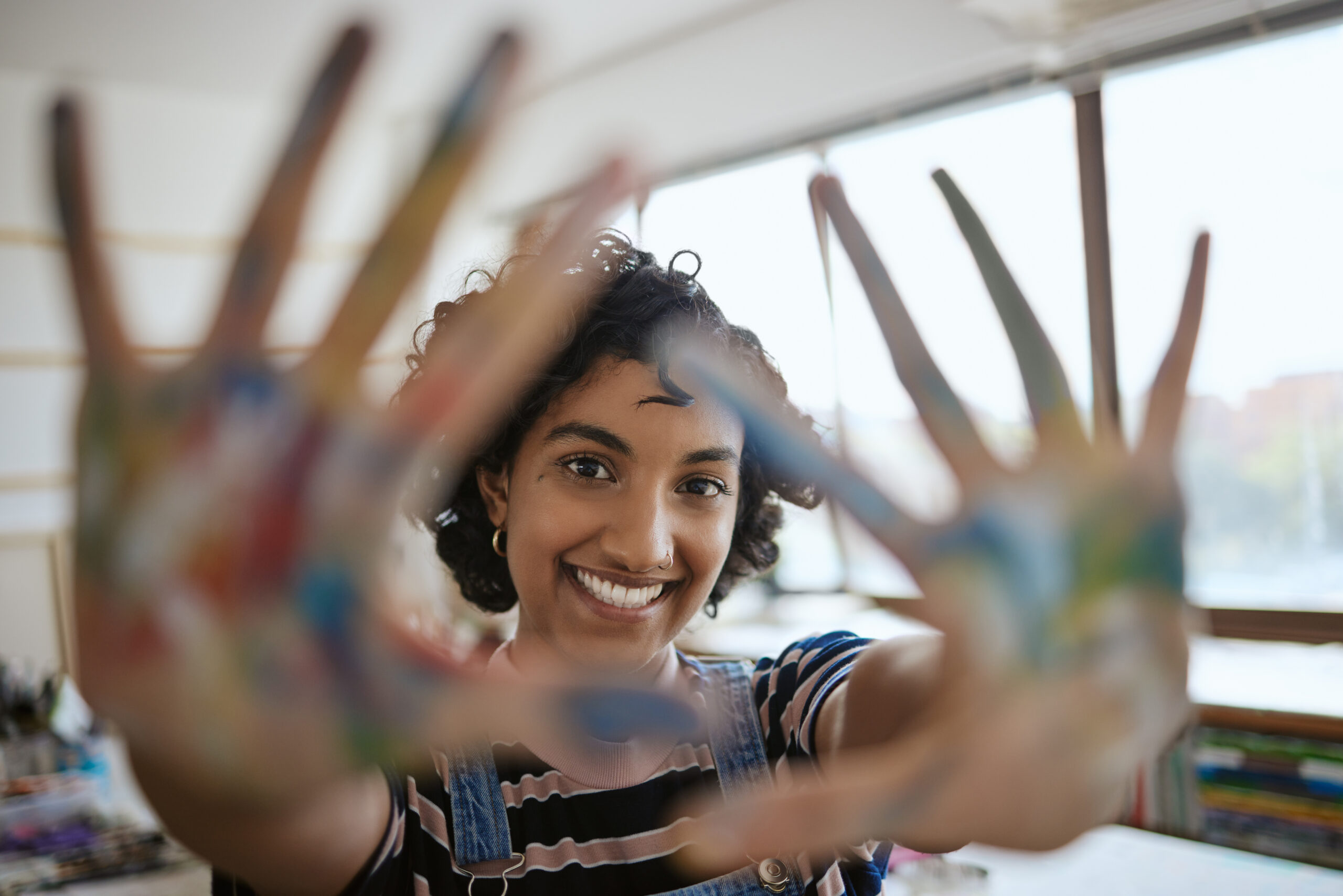
Hobbies for Women in Their 30s
Your 30s can be a beautiful, transformative decade. It’s a time when you’re juggling responsibilities—career, relationships, finances, maybe even a family—but also figuring out who you truly are. In your 30s, you are not only focused on all the responsibilities of adulting, but you are also constantly looking for new ways to reinvent yourself. Finding an activity that excites you can boost your confidence, reduce stress, and make life more enjoyable. Hobbies give you a sense of accomplishment and helps you to create a well-rounded and fulfilling life. Whether you want something creative, active, or purely relaxing, there’s a perfect hobby out there for you. Let’s dive into the best hobbies for women in their 30s, how to get started, and why they might just change your life.
The Benefits of Having Hobbies in Your 30s
Between the hustle, self-care often takes a backseat, and before you know it, life starts feeling… monotonous. Here are some of the reasons you need to take up a hobby that you enjoy in your 30s:
You Get to Do Something for You
Many of us have kids now that we are in our 30s and it can feel like our entire lives revolve around them and their activities. We are constantly thinking about school pickups, doctor appointments, sporting events, etc.. We are perfectionists and want to be the perfect parents, but we end up forgetting about ourselves in the process. Having a hobby can help you to do something that is just for you and no one else. It also helps you to take a breather when you are feeling overwhelmed with parenting.
Helps to Expand Your Social Circle
The truth is, many of us do not have the same number of friends that we had when we were in High School and College. You have such a great social life in your 20s and before you know it, all of that is gone. Finding a hobby that you like can help you to build back up your social circle as you engage in activities with likeminded people. It is also a great way to build discipline around making friends because if you sign up for a hobby like a book club, you will feel more obligated to show up.
Stress Relief
The dreaded “S” word! Studies show that it can become more difficult to cope with stress as you get older. One of the best ways to manage stress is by getting involved in community activities. Having a hobby can help you do just that! Also, engaging in activities you love helps to reduce your cortisol levels.
Help you to Develop New Skills
Having a hobby in your 30s can cultivate a wide array of skills. For example, team sports and group activities can help you to develop communication and leadership skills. Blog writing and journaling can help to improve your organization skills. Playing music helps to improve coordination and patience!
Boosts Creativity
Creativity can transform your life in many ways. Creativity is all about seeing the world differently and finding unique ways to solve everyday problems. Hobbies are a great way to allow your mind to wander freely by creating a space for you to think outside the box.
Creative Hobbies for Women in Their 30s

Painting or Drawing
Painting or drawing is a great way to unwind and express your emotions without words. What I love about it is that you don’t need any special talent to get started, all you need are a few tools and some practice!
How to get started:
- Buy a beginner’s sketchbook or watercolor set.
- Follow online tutorials on YouTube or Skillshare.
- Try different styles—realism, abstract, or digital art.
- Join a local art class to stay motivated.
Writing (Journaling, Blogging, or Fiction)
I started this blog so I can get my ideas out into the world. You can do the same! Writing isn’t just for authors—it’s an incredible way to process emotions, tell stories, or share expertise. Plus, if you love it enough, you can turn it into a side hustle!
Get started by doing the following:
- Choose a medium—journal, blog, poetry, or short stories.
- Set a daily or weekly writing goal.
- Join writing communities like Scribophile or Medium.
- Experiment with different writing prompts.
DIY Crafts & Upcycling
If you enjoy hands-on projects, DIY crafts and upcycling old items can be both fun and eco-friendly.
How to get started:
- Pick a project—jewelry making, home decor, or clothing alterations.
- Watch DIY tutorials on Pinterest or YouTube.
- Visit thrift stores for unique pieces to transform.
- Sell your crafts on Etsy if you’re feeling entrepreneurial!
Pottery
Pottery is a hands-on art form where you shape and mold clay into beautiful, functional pieces. The best thing about this hobby is that you get to keep a lasting reminder of your efforts and accomplishments. Start by doing the following:
- Buy air-dry clay or a beginner pottery kit
- Watch basic hand-building tutorials on YouTube (like pinch pots or coils)
- Try sculpting with simple tools like a butter knife or toothpick
- Join a local pottery studio or take a beginner class when ready
Disclosure: Some of the links in this post are ‘affiliate links’. This means if you click on the link and purchase the item, I will receive an affiliate commission.
Scrapbooking
Scrapbooking is a creative way to preserve memories through photos, decorations, and journaling.
How to get started:
- Gather printed photos, washi tape, stickers, and colorful paper
- Buy a blank scrapbook or binder
- Choose a theme for your first page (like a trip or celebration)
- Watch layout inspiration videos or explore Pinterest for ideas
Origami
Origami is the Japanese art of paper folding to create intricate shapes and figures. On the plus side, origami strengthens hand-eye coordination, dexterity and fine motor skills.
Begin by doing the following:
- Buy square origami paper (or cut standard paper into squares)
- Start with beginner folds like cranes, boats, or flowers
- Follow step-by-step YouTube videos or printable guides
- Practice regularly to build muscle memory and technique
Candle Making
Buy a DIY candle-making kit with wax, wicks, and scents. Melt the wax, add fragrance, and pour it into a mold or jar.
Active Hobbies for Women in Their 30s
Yoga or Pilates
Yoga and Pilates aren’t just trendy; they’re fantastic for flexibility, strength, and mental clarity.
How to get started:
- Find beginner-friendly classes online or at a local studio.
- Invest in a good yoga mat and comfortable workout gear.
- Start with short 10-15 minute sessions and build from there.
- Join a community for accountability and motivation.
Hiking
Nature is the ultimate stress reliever. If you love fresh air, hiking is a perfect weekend hobby.
Get started by:
- Research beginner-friendly trails in your area.
- Invest in comfortable shoes and a small backpack.
- Start with easy hikes and gradually try more challenging trails.
- Join local hiking groups to make new friends.
Cycling
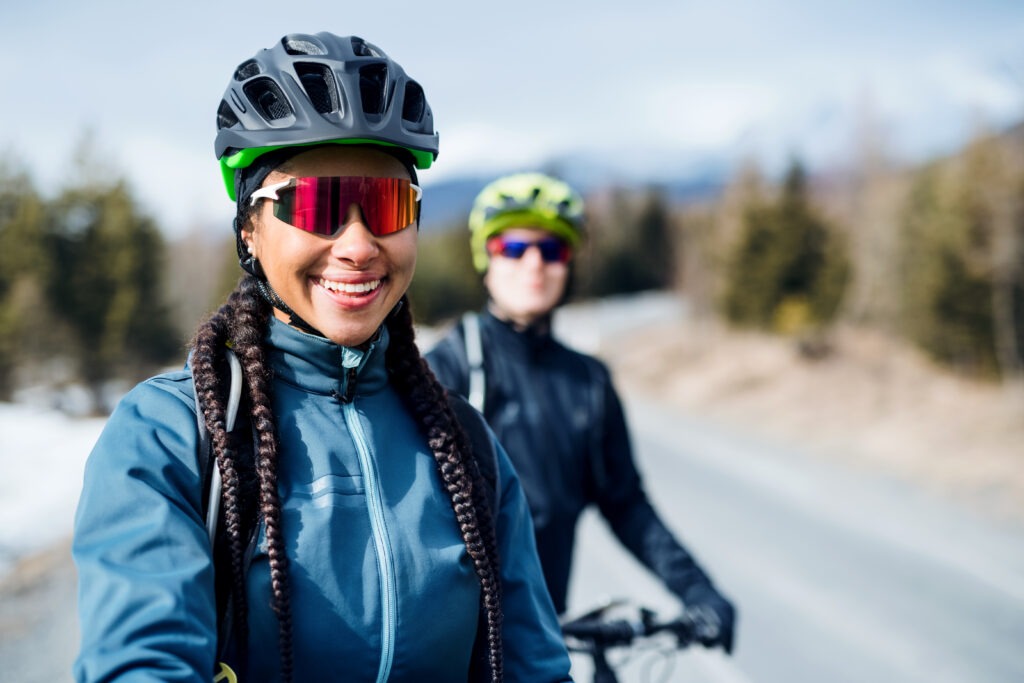
Cycling can be fun even though your legs will be on fire for the first few days.
How to get started:
- Use any bike you have and ride around your neighborhood.
- Go to a bike trail in your area to get some practice.
- Join a local cycling group for motivation.
Camping
A great way to get outdoors and something fun that you can do with your family. To get started:
- Rent or borrow basic gear like a tent and sleeping bag.
- Start with a weekend camping trip at a nearby site.
- Visit Rei.com for expert tips on what to you need to bring and wear for your first camping adventure.
Dancing
Dancing is not only a great workout but also an incredible confidence booster. Whether it’s salsa, hip-hop, or ballet, there’s a style for everyone.
How to get started:
- Try free dance tutorials on YouTube.
- Join a dance class (virtual or in-person).
- Dance in front of the mirror—because why not?
- Make it social by inviting friends to a dance night.
Relaxing Hobbies for Women in Their 30s
Gardening
There’s something magical about watching something grow. Gardening is calming, rewarding, and great for your mental health.
To get started:
- Start small—herbs, succulents, or indoor plants.
- Learn about plant care (water, sunlight, soil needs).
- Visit a nursery for beginner-friendly plants.
- Join gardening communities online for tips.
Knitting
Knitting is relaxing, creative, and leaves you with cozy, handmade treasures.
How to get started:
- Pick up a beginner knitting kit with basic needles and yarn.
- Watch step-by-step tutorials on YouTube to learn simple stitches like the knit and purl.
- Start with an easy project like a scarf or dishcloth to build your skills and confidence.
Reading
A good book is like a mini-vacation for the mind. Whether you love romance, thrillers, or self-improvement books, there’s always something new to discover.
How to start reading:
- Set a reading goal (one book a month, perhaps?).
- Join a book club for motivation.
- Explore audiobooks if you’re always on the go.
- Make a cozy reading nook in your home.
Yoga and Meditation
Use apps like Headspace or Insight Timer to guide short meditation sessions. Start with 5 minutes daily.
Puzzle Solving (Crosswords, Sudoku, etc.)
Get a puzzle book or download a free app to practice. Start with easy puzzles and work your way up to more difficult ones.
Photography
Photography is a fun hobby that you can do in your 30s. It lets you capture the beauty of everyday moments while exploring your creativity.
How to get started:
- Start with your smartphone or a basic digital camera to practice composition and lighting.
- Learn the basics through free online tutorials or YouTube videos.
- Go on short photo walks in your neighborhood to build confidence and find your style.
Food & Drink Hobbies for Women in Their 30s
Baking
Begin with simple recipes like cookies or banana bread. Gather basic ingredients and baking tools.
Coffee Brewing
Experiment with different brewing methods like French press or pour-over. Learn about coffee beans and grind sizes.
Fermenting (Kombucha, Kimchi, etc.)
Get starter kits or use simple fermentation recipes with minimal ingredients.
Wine or Beer Tasting
Start with online tasting guides or attend local tastings. Keep a journal of what you like.
Cooking International Cuisines
Pick a country and try an easy dish from that cuisine. Watch tutorials and experiment with flavors.
Unique & Fun Hobbies for Women in Their 30s
Learning a New Language
Always wanted to speak French, Spanish, or Japanese? Now’s the time!
How to get started:
- Use language apps like Duolingo or Babbel.
- Watch movies or listen to music in that language.
- Practice speaking with native speakers through online exchanges.
- Set realistic goals—don’t expect fluency overnight!
Cooking or Baking
Cooking isn’t just a necessity—it can be an enjoyable and creative outlet. What I like about this hobby is that you are killing 2 birds with one stone by preparing dinner for your family and having fun at the same time! To start:
- Experiment with new recipes once a week.
- Follow food bloggers or cooking channels.
- Try themed nights—Italian, Thai, or Mexican cuisine.
- Share your creations with family and friends.
Birdwatching
This hobby is like Pokémon! “Gotta catch em all!” Also, once you start to take note of all the birds around you, you will eventually become more perceptive of your environment. You start noticing other things like sounds of nature that you might have once overlooked.
Start by doing the following:
- Buy some binoculars.
- Get a beginner’s field guide or use an app like Merlin Bird ID.
- Visit parks and start observing birds.
Tattoo Designing
This is such a cool hobby! Imagine designing a tattoo for a friend and they get to keep a piece of you for life. Sounds creepy? Lol. To get started do the following:
- Use a sketchpad or digital app like Procreate
- Study tattoo styles (traditional, minimalist, linework, etc.)
- Practice sketching simple icons, lettering, and flash sheets
- Share your designs on Instagram or get feedback from artists
Graphic Design
Graphic designers create visuals for web, social media, or print using digital tools. Another hobby that you can potentially turn into a side hustle.
How to get started:
- Use free tools like Canva or try Adobe Express
- Watch beginner tutorials on design principles and layouts
- Try creating simple projects like Instagram posts or flyers
- Gradually learn tools like Adobe Illustrator or Photoshop
Playing an Instrument
Pick an instrument like a ukulele or keyboard. Follow online beginner lessons and practice daily.
FAQs About Hobbies for Women in Their 30s
1. What if I don’t have time for a hobby?
Start small—just 10-15 minutes a day can make a difference.
2. Can hobbies really reduce stress?
Absolutely! Doing something you enjoy releases endorphins, reducing stress and improving mood.
3. Are there any affordable hobbies?
Yes! Many hobbies like journaling, hiking, and YouTube dance workouts are free or low-cost.
4. What’s a good hobby for introverts?
Reading, painting, writing, or gardening are fantastic solo activities.
5. Can I turn my hobby into a side hustle?
Definitely! Many hobbies, like writing, crafting, or baking, can become profitable over time.
Conclusion
Your 30s are the perfect time to explore new passions and invest in yourself. Whether you’re looking for relaxation, creativity, or a new adventure, there’s a hobby that fits your lifestyle. So, what’s stopping you? Pick one (or a few!) from this list of hobbies for women in their 30s, get started, and watch how it transforms your everyday life.
Life’s too short for all work and no play—so go ahead and have some fun!
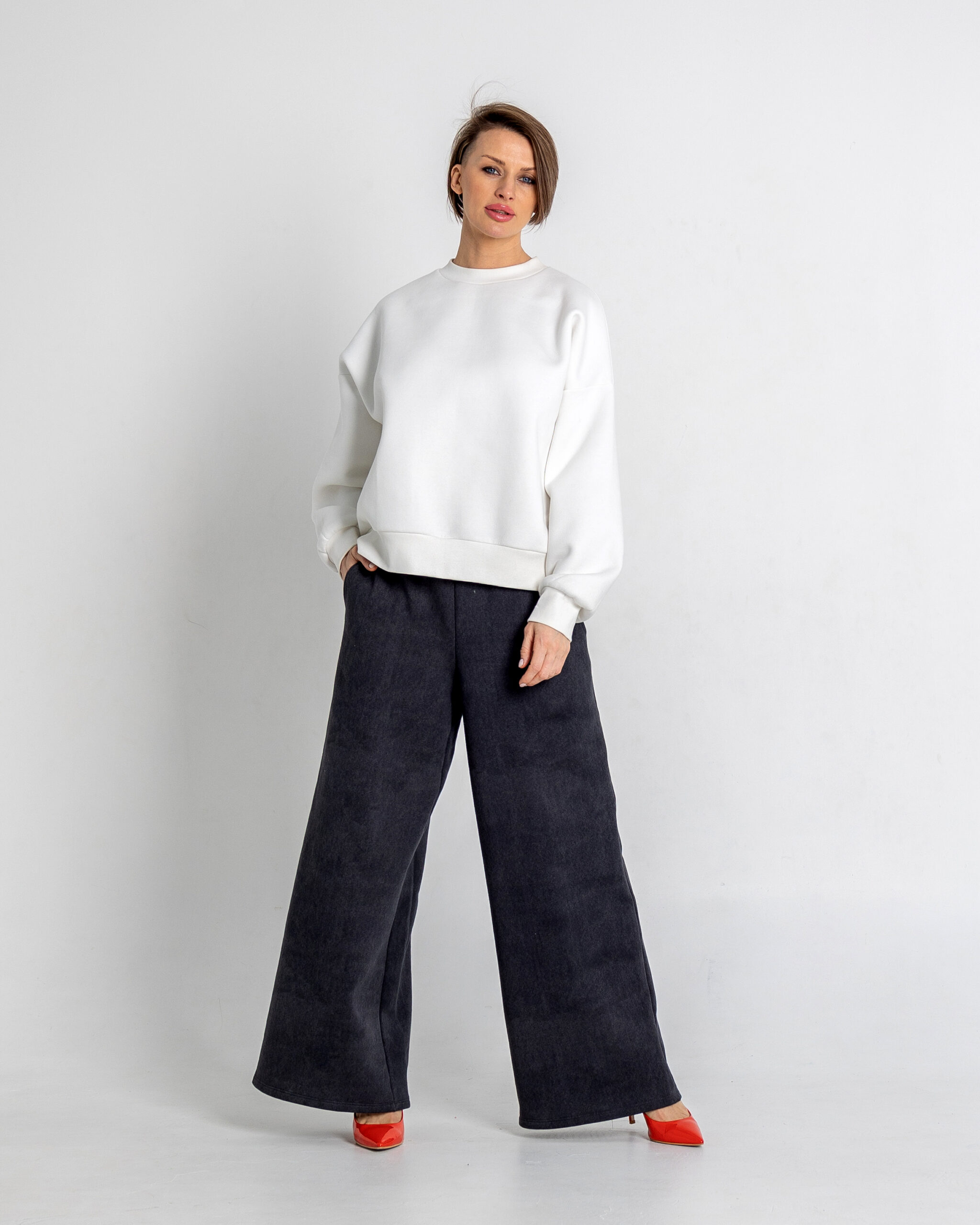
How to Style Wide Leg Jeans
As with many fashion trends, wide leg jeans are returning to prominence after originating in the early 20th century. This style was first seen in 1920 worn in the form of pajama pants by members of high society like the influential Coco Chanel. The trend then became popular all over the world as women started wearing wide leg pants as beach pajamas. What began as casual loungewear has evolved into one of today’s most sought-after denim trends! Don’t you just love seeing parts of the past coming back in style and the new twists that fashion influencers are placing on them? I sure do! Whether you have been wearing wide leg jeans for a while, or just dipping your toes in the trend, this guide is sure to provide you with some valuable insight. Through in-depth research and personal expertise, I have developed a styling guide to help you master the art of how to style wide leg jeans like a pro! Let’s dive in!
Choosing the Right Fit and Fabric
The first step is usually the hardest. Finding jeans that are comfortable and fit your body type. In my opinion, many of the cute fashion trends you see where women are wearing an oversized look just doesn’t work for everyone. The cropped wide leg jean is also not very flattering in my opinion. I find that cropped jeans look great on tall slim women with long legs which if we are being honest is not the majority of women. Aim for one or two pairs of wide leg jeans to start. One with a length that skims the floor and another that hits the top of your shoe. One of them you can wear with heels and the other with flats. Instead of super baggy jeans, get some that are fitted but not too tight. Just enough where you have some room to move around but still a bit snug to make your hips stand out! When it comes to the rise, stick to either mid or high rise. Avoid low rise unless you are adamant about wearing them and they look good on you. They are not my cup of tea especially because I have a little bit of a tummy now that I am in my 30s. Lol. Again, if you like it, have fun with it. I just think that it doesn’t work for most body types. In the example below, both styles look great, however, I would go with the jeans on the left. These are Sidefeel jeans from amazon. The ones on the right are from TEMU but they may not work for everyone’s body type.


How to Wear Wide Leg Jeans – Choosing the Right Shoes
When it comes to styling wide-leg jeans, balance is key! And although I love chunky shoes and UGG boots, I think they should be left in the closet when wearing wide leg jeans. Also, those cute loafers that you love wearing and they look so professional and chic? Leave those in the closet as well! Avoid rounded shoes and small delicate shoes like ballet flats as those do not look very flattering with wide leg jeans. It is all about proportions and you shouldn’t wear shoes that are too small or too bulky. Opt for shoes that are feminine and cutesy. For example:
- Pointed-Toe Shoes – The pointed shape extends your leg line, making them appear longer and leaner, which goes well with the weight of wide-leg jeans.
- Heels – Whether block heels, stilettos, or wedges, heels add height and prevent the jeans from overwhelming your frame, especially if they’re extra wide or long.
- Streamlined Sneakers – Sleek, low-profile sneakers (e.g., Adidas Stan Smiths or classic Converse) keep the look polished without adding bulk.
- Cowboy Boots – The structured design and slight heel of cowboy boots add shape and height while allowing the jeans to drape naturally over the boot.
Best Tops to Wear with Wide Leg Jeans
The most important thing when choosing tops is to make sure that they are not too oversized. As much as I love seeing models wear those oversized jackets with baggy wide leg jeans, I am not a model. I prefer to be realistic when it comes to fashion. If you are anything like me and prefer to be on the safe side stick to the following:
- Fitted crop tops – Fitted crop tops create a balanced silhouette by contrasting the volume of wide leg jeans with a more fitted top.
- Bodysuits – Bodysuits give a sleek, tucked-in look without bunching.
- Tucked-in button-down shirts – If you are going for a business casual look, button downs are a great option as long as they are tucked in.
- Lightweight sweaters or turtlenecks – Sweaters and sweaters are great for cooler weather.
- Fitted tank tops – Perfect for warmer weather while keeping proportions balance.
- Wrap tops – The waist definition works particularly well with high-waisted wide leg jeans
Pro Tip: If you go oversized on top (like a chunky sweater or boxy blazer), do a French tuck or opt for a cropped cut to keep your shape visible. Wear a belt to break the look and to add extra definition to your waist.
How to Style Wide Leg Jeans for Different Occasions
Layering Wide Leg Jeans

Notice how the pointed toe shoes add height and length to the legs. The tucked-in button-down, paired with a belt, enhances the outfit’s structure for a more polished and intentional look. For cooler months, layer with a stylish sweater. These simple styling tricks help create a balanced and chic silhouette, especially when layering for warmth.
Disclosure: Some of the links in this post are ‘affiliate links’. This means if you click on the link and purchase the item, I will receive an affiliate commission.
How to Style Wide Leg Jeans for a Chic and Polished Look
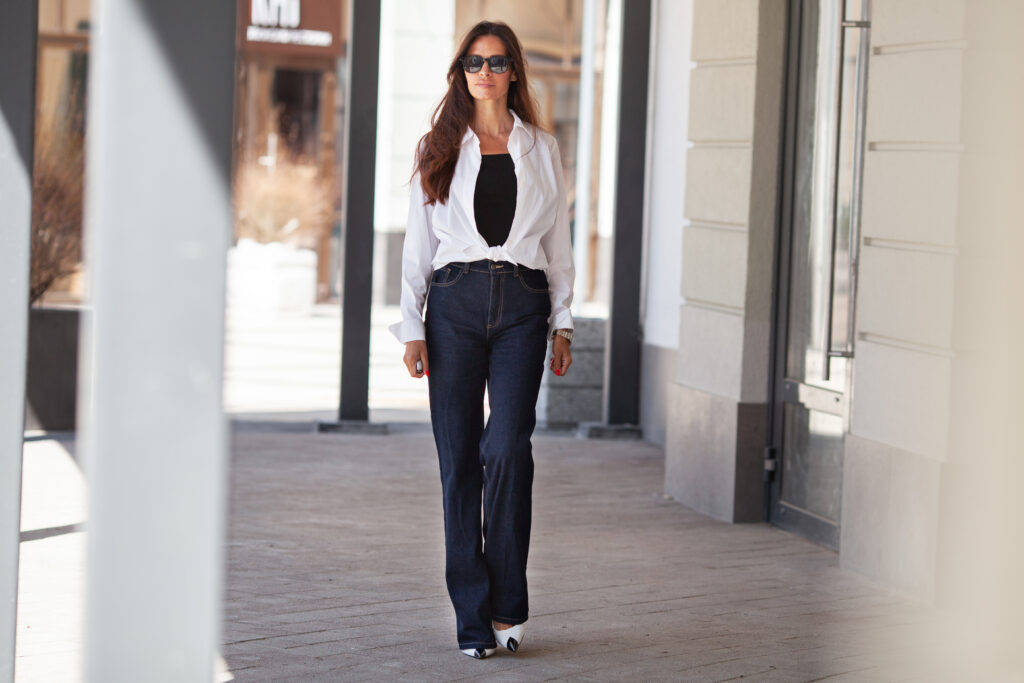
This is a perfect business casual look! The dark blue jeans acts as a solid neutral base which allows the black and white to stand out! The accessories are minimal and I especially love the pointed toe shoes with the black tip. This makes the legs look more elongated. The white button down is tied at the front for a more formal look and the sleeves are tucked and slightly messy to add a little bit of interest and spontaneity.
Street Style & Trendy Vibes
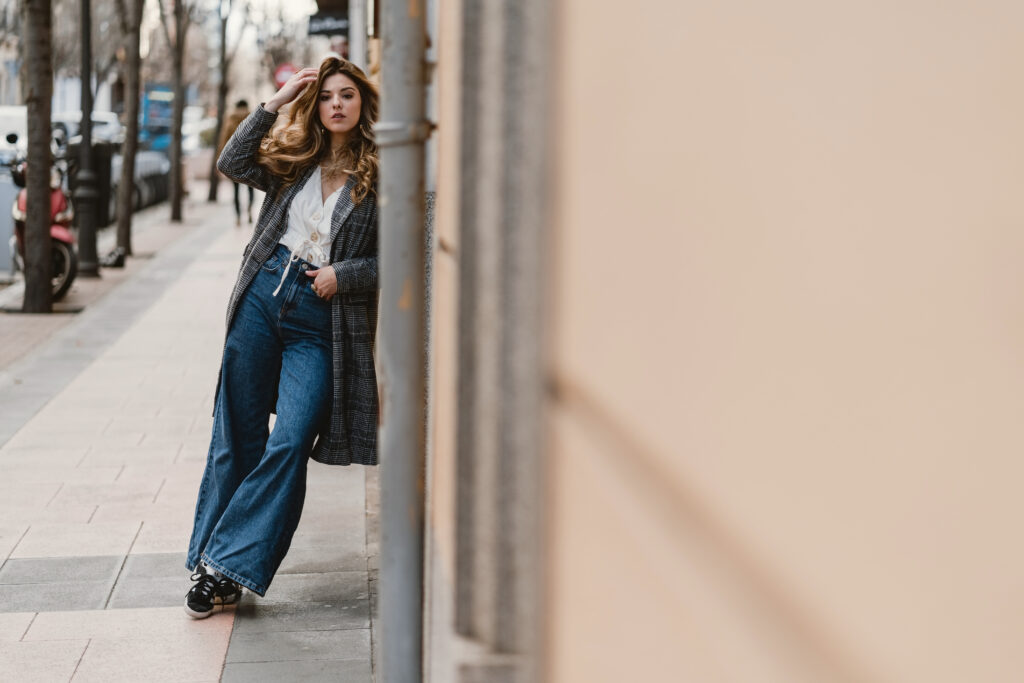
The jeans in this example have a unique street style design. I love the way the coat’s plaid pattern adds a touch of personality and charm to the full look.
How to Style Wide Leg Jeans for Work
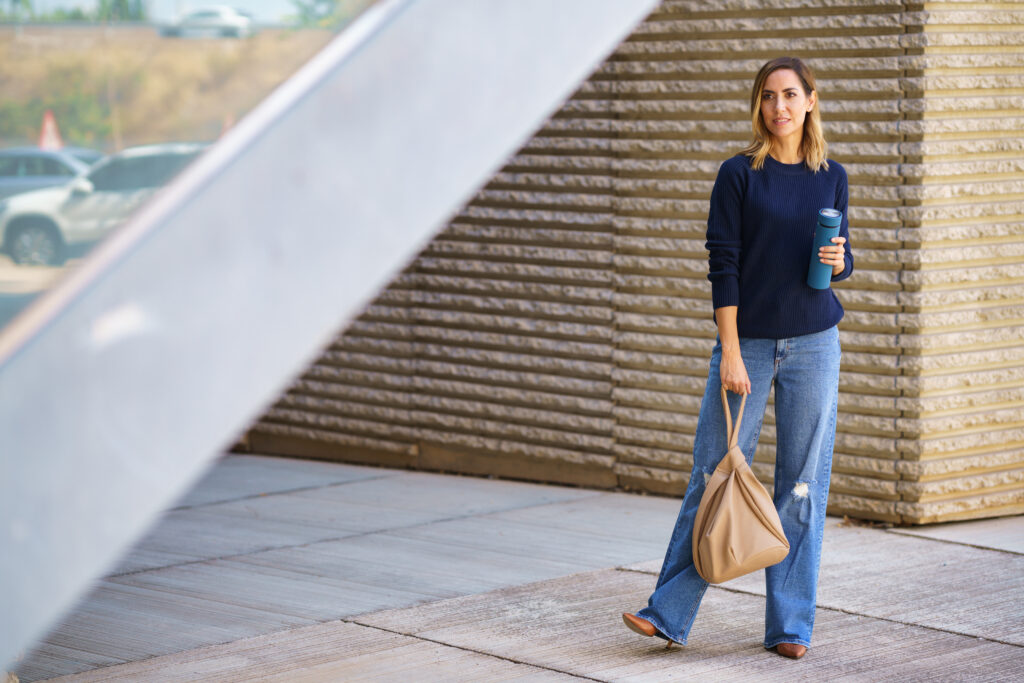
This is a cute look for work if you have a job that is a little more relaxed. Notice how the sweater is tucked in to create a nice balance. I also think that navy blue pairs great with brown to create a neutral and earthy tone. The look is both classy and timeless.
Comfortable Wide Leg Jean Outfit Idea

If you prioritize comfort and enjoy a more relaxed look, this outfit is definitely one to try. The jeans have a longer fit, but the square-toe shoes with a block heel prevent them from dragging while adding a stylish and balanced look. Remember how we talked about the tuck in and the belt? This is a great example of how you can have a little bit of heaviness on the top but just be sure to break up the look with a belt and tuck.
A Cute Oversized Look, if You Dare!
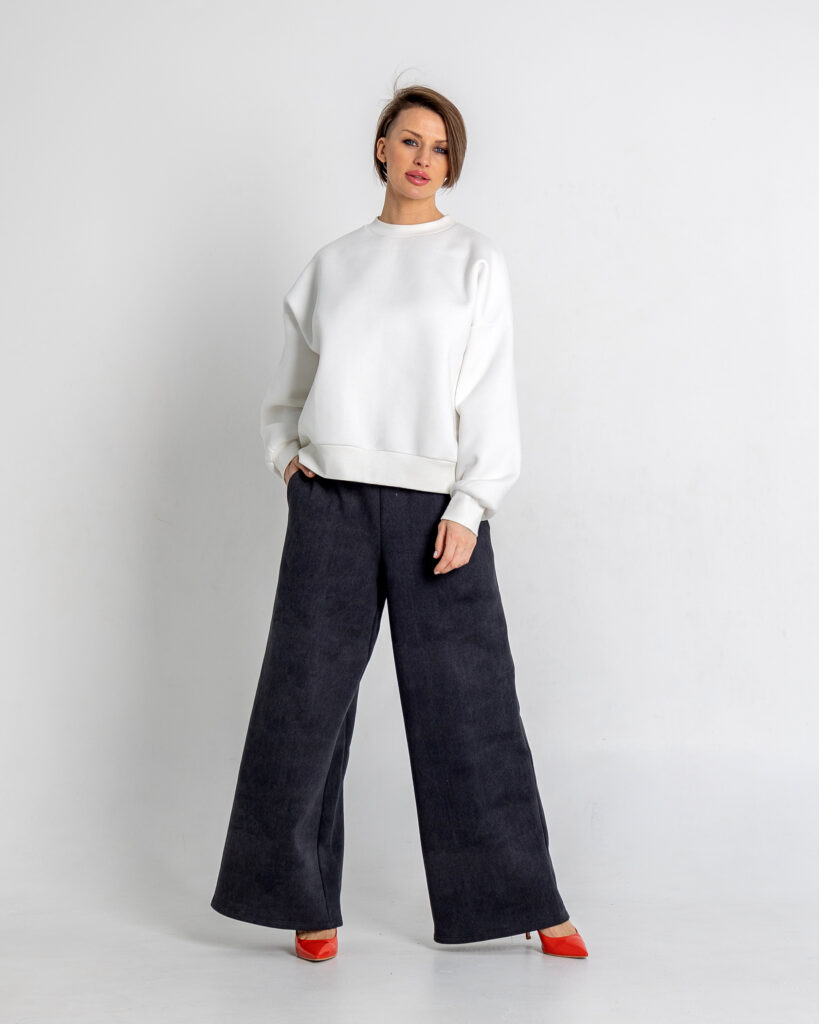
I would not try this look but if you are more experimental with fashion, I say go for it especially since red is trending right now. I love the way the red pointy toe heel adds a bold, confident touch to the outfit. 10/10 I would definitely recommend! Just not for myself. Lol
Common Styling Mistakes to Avoid – Styling Wide Leg Jeans
- Wearing Baggy or Untailored Tops Without Definition – A loose, untucked shirt or oversized hoodie can make you look shapeless especially you are not naturally thin. Balance is key!
- Letting your Jeans Drag on the Ground – Too-long jeans can look messy and even ruin the fabric. Take care of your beautiful jeans! You can get them hemmed if they are too long or wear heels if needed.
- Over-Accessorizing – Wide-leg jeans are already a heavier look so wearing lots of accessories can create a “costumey” look. Keep accessories minimal and chic to avoid overwhelming the look.
- Wearing the Wrong Outerwear Length – Super long or oversized coats that don’t have structure can swallow up your shape. Instead, opt for cropped, fitted, or belted outerwear.
- Skipping the Waist Emphasis – Whether through a tuck, a cropped top, or a belt, defining your waist is crucial to keeping the look flattering and put-together.
Final Thoughts on How to Style Wide Leg Jeans
Wide leg pants have made a comeback from the early 20th century and is now one of the most popular trends in women jeans. When learning how to style wide-leg jeans, pay attention to proportions. Have fun with the style but be sure to keep accessories to a minimum and stick to more basic styles to begin with. Not every trend out there will work for your body type, so it is important to be patient as you learn what styles work best for you. As usual, I hope you enjoyed this blog post as much as I enjoyed writing it. Let me know which styles you liked best and if you gained any value from this post! Happy styling!
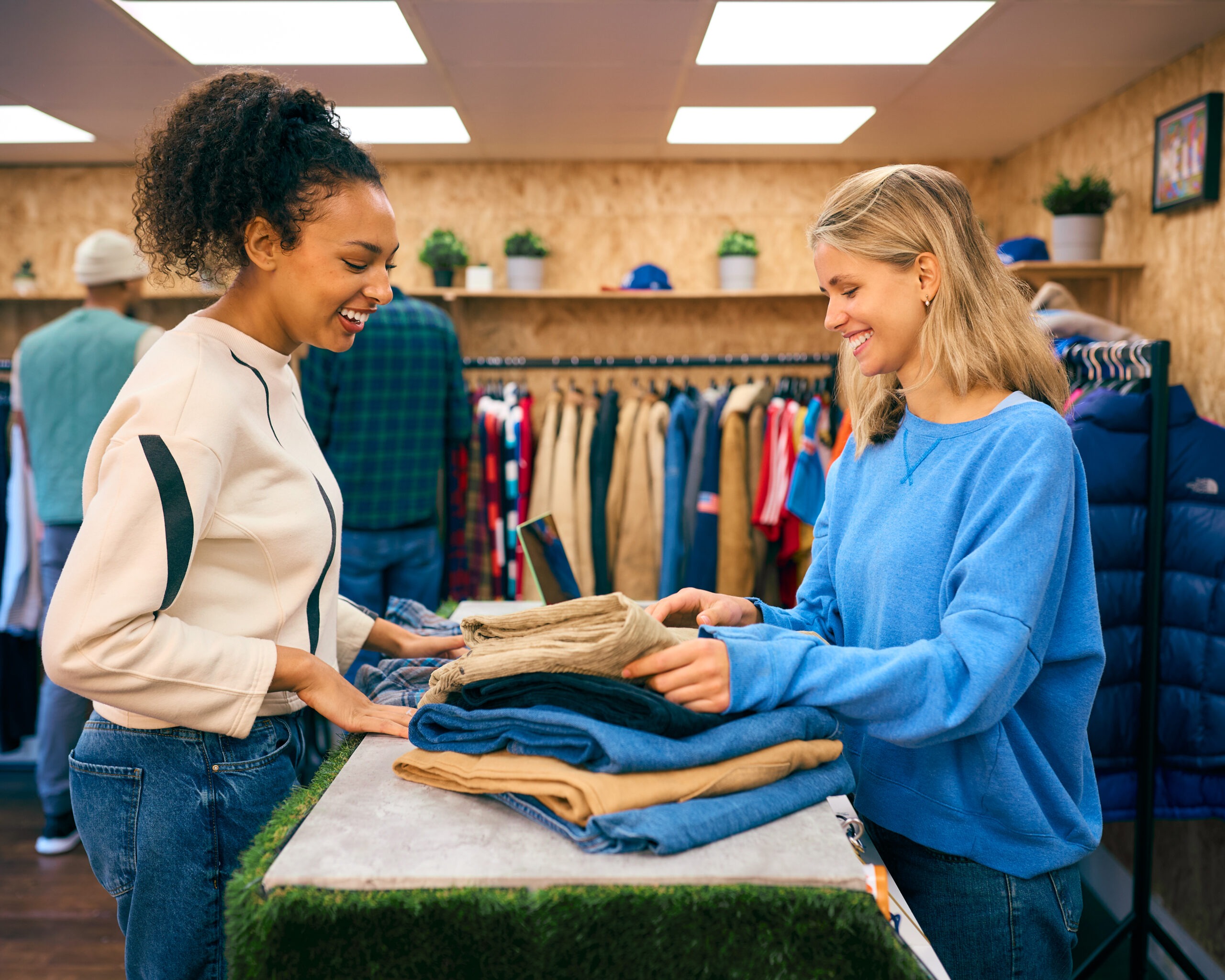
Brands to Look for while Thrifting
We all love shopping, but the price tags on some items can be very discouraging. With that being said, thrifting is a great option for those who enjoy shopping without having to spend an enormous amount of cash for quality clothing. Many people are now switching from buying retail and thrifting either online or at their local thrift stores. Thrifting is not only budget-friendly, but also a fun activity to do all while creating a diverse closet. It’s a fun way to experiment with different styles without feeling bummed out about buying a ton of clothes that just do not fit right or that isn’t your style. But I can tell you firsthand that not all used items are worth buying. Knowing which brands to look for can change your thrifting from just browsing to finding real treasures! This guide will help you spot valuable brands in different types of items, so your next thrift store trip gets you things that will last.
Top Clothing Brands
The best finds at thrift stores are often designer pieces at much lower prices. You can build an entire capsule wardrobe on a budget if you know what type of clothing to look for. Before heading out to the thrift store, make a plan. Create a collage of different brands and their logos so that you have some sort of visual to work with. You can use Canva or other free tools to create a board and print it out to take to the store. Keep on the lookout for the following brands:
High-End Brands
- Burberry: Burberry is known for their raincoats and checkered pattern, and they last for years.
- Ralph Lauren: This brand is known for making classic American styles that stay in fashion.
- Max Mara: Their well-made wool coats are worth grabbing when found at thrift store prices.
- Diane von Furstenberg: Her famous wrap dresses are both comfy and always in style.
- Vintage Gucci, Chanel, or Louis Vuitton: Real pieces from these brands can be valuable, but make sure they’re not fake.
Good Mid-Range Brands to Look for While Thrifting
- Pendleton: Their wool products, especially blankets and jackets, are very strong and look better as they age.
- Nation LTD – They create relaxed, minimalist, casual clothing which are really sought after these days.
- Levi’s: Old jeans from this famous brand can be worth more than new ones, especially those made before the 1980s with red tags.
- M.M Lafleur: They are famous for high-quality business casual clothing.
- Patagonia: Their outdoor clothes are made to last in rough weather, and the company will repair them for life.
- Arc’teryx – Another great option for outdoor apparel. Arc’teryx is one of the most respected names in outdoor apparel.
- Eileen Fisher: Known for good quality, earth-friendly basics in natural fabrics that keep their shape and color over time.
- Brooks Brothers: Their business clothes and casual pieces are well-tailored with good fabrics.
- Alo: Their clothing is comfortable, functional, and should be easy to mix and match with other clothing pieces.
- Free People – You can usually find quality jumpsuits, jackets, and coats from this brand at thrift stores.
Older Fashion Brands to Look for While Thrifting
While today’s cheap fashion often falls apart quickly, older pieces from these brands were usually made better:
- Peruvian Connection (founded in 1970s) – They create durable luxury clothing made to standout.
- Vintage Gap (1990s and earlier): Their older jeans and basics were much better quality than what they sell now.
- J.Crew from the 2000s and earlier: Look for their sweaters, wool coats, and jackets from before they started making lower quality items.
- Eddie Bauer (vintage): Their older outdoor clothes were built to really last.
Home Goods and Kitchen Finds
Cast Iron and Cookware
Some of the best kitchen items come from thrift stores:
- Le Creuset: These coated cast iron pots are family heirlooms and often show up in thrift stores at big discounts.
- All-Clad: Chef-quality stainless steel cookware that lasts for generations.
- Vintage Pyrex: Especially patterns from the 1950s-1970s, which many people collect.
- Lodge Cast Iron: These nearly unbreakable pans get better with age and can be fixed up no matter how bad they look.
- Staub: Like Le Creuset, these French-made pots work great and look beautiful.
Quality Home Items to Look for While Thrifting
- Fiestaware: These colorful, strong dishes have many fans and old pieces can be quite valuable.
- Waterford Crystal: High-quality crystal glasses that look stunning in any home.
- Mikasa and Noritake: These nice china brands offer pretty patterns that make everyday meals special.
- Vintage Scandinavian designs: Look for items from brands like Marimekko, Arabia, or Iittala.
Furniture Brands That Last a Long Time
Finding good furniture at thrift prices can save you thousands while giving you pieces that last longer than new ones:
Mid-Century Modern Favorites
- Herman Miller: Makers of the famous Eames chair and other well-known designs that keep their value.
- Knoll: Their classic furniture pieces are some of the best modern designs.
- Eames: Any real Eames piece is worth buying, even if it needs fixing up.
- Danish Modern makers: Look for names like Hans Wegner, Finn Juhl, or simply “Made in Denmark” stamps.
Traditional Furniture Brands to Look for While Thrifting
- Ethan Allen: Especially their older solid wood pieces, which are very well-made.
- Stickley: Known for mission-style furniture that shows great craftsmanship.
- Henredon: High-end traditional furniture that keeps both its value and style.
- Lane: Their cedar chests and mid-century pieces are often sought after.
Electronics and Media Worth Getting
- Vintage Audio Equipment: Brands like Marantz, Pioneer, Technics, and McIntosh often sound better than new equipment.
- Videogames and Consoles: Old gaming items can be valuable collector’s items.
- Film Cameras: Brands like Leica, Hasselblad, Rolleiflex, and vintage Canon or Nikon models still work well and keep their value.
- Vinyl Records: Besides the music itself, first pressings from certain companies can be valuable.
How to Check if Your Finds are Real
Finding a designer label doesn’t mean it’s real. Here’s how to avoid fakes:
- Learn brand details: Each luxury brand has special stitching patterns, hardware, and label designs.
- Check material quality: Real luxury items use good materials with even stitching and feel solid.
- Look at hardware: Zippers, buttons, and clasps on real items are usually heavy and well-made.
- Check serial numbers: Many luxury brands have systems you can check online.
- Trust your gut: If something seems off or the price is too good to be true, be careful.
FAQs About Brands to Look for While Thrifting
Q: How can I find the best thrift stores for good brands? Thrift stores in wealthy areas usually get better quality donations. Also, many cities have vintage or consignment shops that pre-select better brands, though prices will be higher than regular thrift stores.
Q: Is it worth buying damaged items from good brands? It depends on the damage. Simple fixes like replacing buttons, fixing hems, or cleaning can make items like new for much less than buying new. But big damage to furniture or very worn clothing might not be worth fixing.
Q: How often should I visit thrift stores to find the best items? Regular visits work best. Many thrift stores put out new items daily, and the best things usually sell quickly. Learning when a store restocks can help you find better items.
Q: Are there certain days that are better for thrifting? Many thrift stores have discount days (often mid-week) when certain colored tags or types of items are on sale. But selection might be better right after weekend donations or on days when new stock is put out.
Conclusion
Knowing which brands offer lasting quality makes your thrifting trips more likely to find items that save you money and might even grow in value. Besides helping the environment by reusing items, thrifting lets you own well-made pieces that might otherwise cost too much. Next time you go to a thrift store, look carefully, thinking beyond current trends to find truly valuable items. Remember that patience helps—the perfect item might not be there every time, but when it is, you’ll know it’s worth buying. Happy hunting!
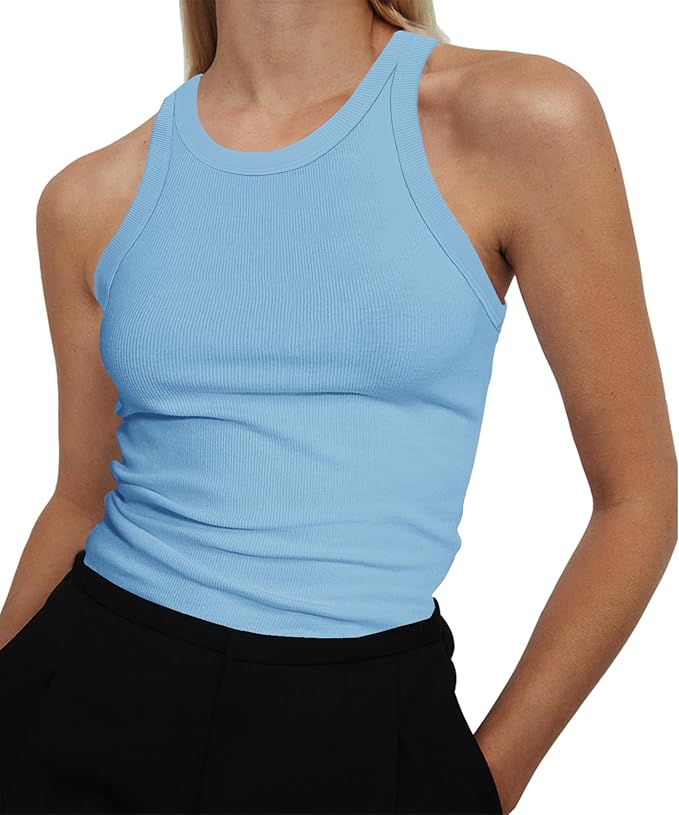
Types of Tank Tops
Tank tops: the unsung heroes of every closet. Whether you’re throwing one on to beat the summer heat, layering it under a blazer for that Zoom meeting, or pairing it with your favorite joggers for a grocery run, tank tops just get the job done. They are great, versatile pieces that everyone should keep on hand. Tank tops can be stylish and comfortable as long as you find one that caters to your preferences and body type. If you’ve ever stood in front of your closet wondering, “Which tank top works best for this outfit?” worry not. I’ve got you covered. In this article, we will be diving into the different types of tank tops and just how versatile they can be.
1. Basic Tank Top

These tank tops are simple, clean and versatile. These are your classic, go-to tanks with wide shoulder straps and a standard neckline. It plays well with everything—jeans, skirts, under cardigans, you name it.
Perfect for: Everyday wear, casual layering
2. Racerback Tank Top
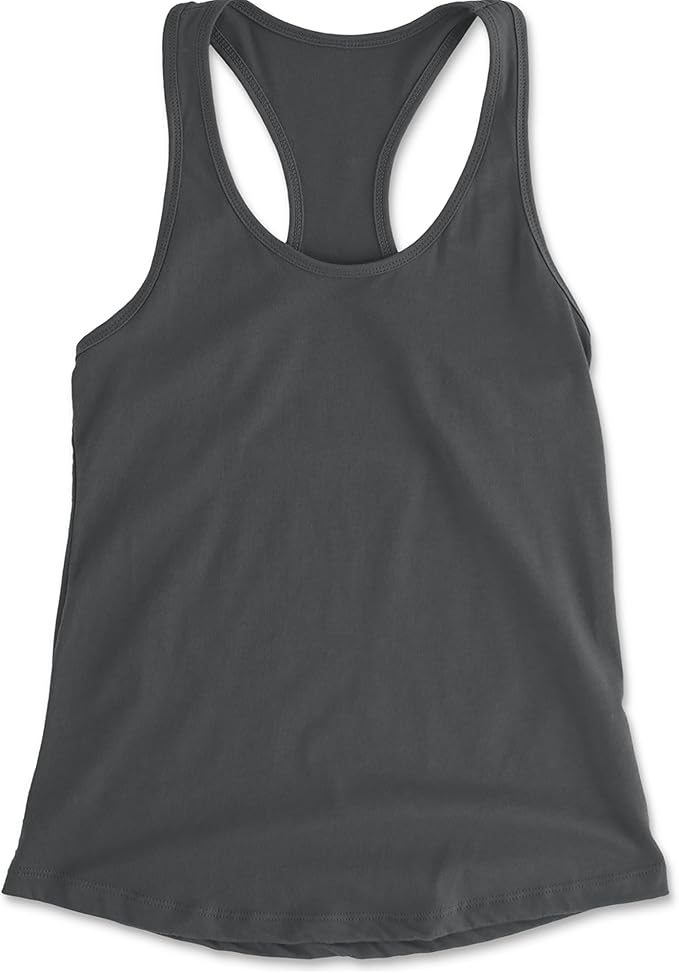
When you think of a racerback tank top think of the letter “T.” Unlike standard tank tops they have a T shaped strap located on the back behind the shoulder blades. It is soft, lightweight, and form fitting. It’s good for physical activity as it gives you freedom to move better.
Good for: Workouts, outdoor adventures, or layering under low-back tops
3. Spaghetti Strap Tank Top
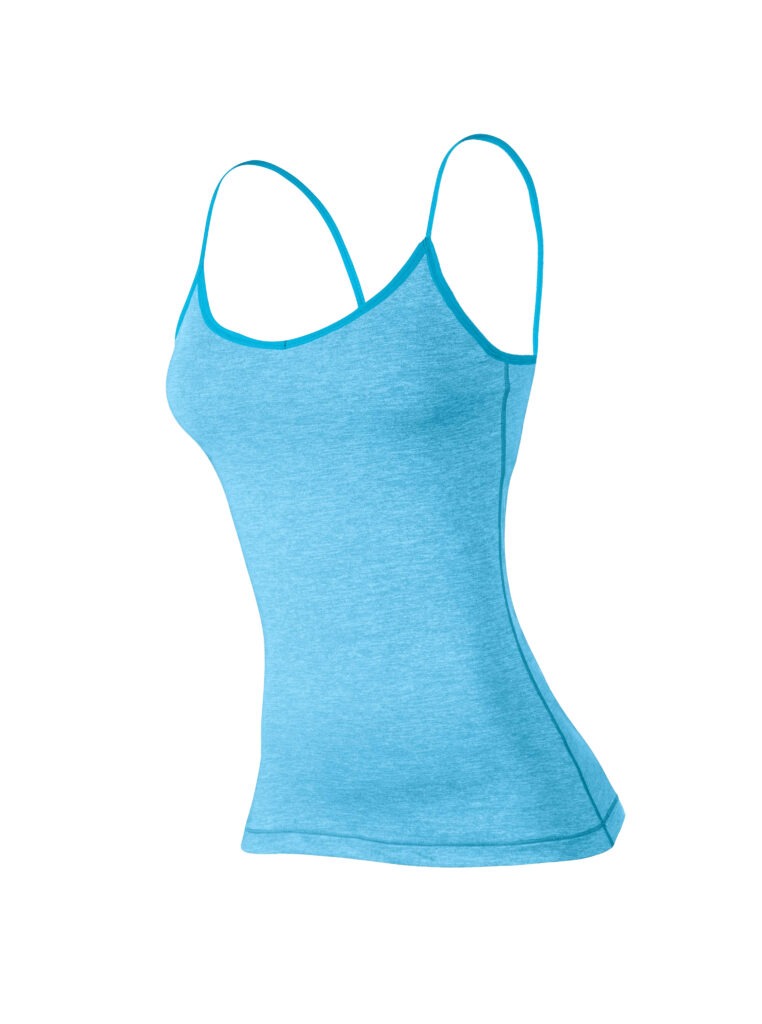
When you think of this tank top, think of spaghetti, literally. Lol. The straps are very delicate. I like to think that they whisper rather than shout. It’s a flirty top and great for warmer days or a night out.
Perfect for: Date nights, beach days, or layering with kimonos
4. Muscle Tank Top
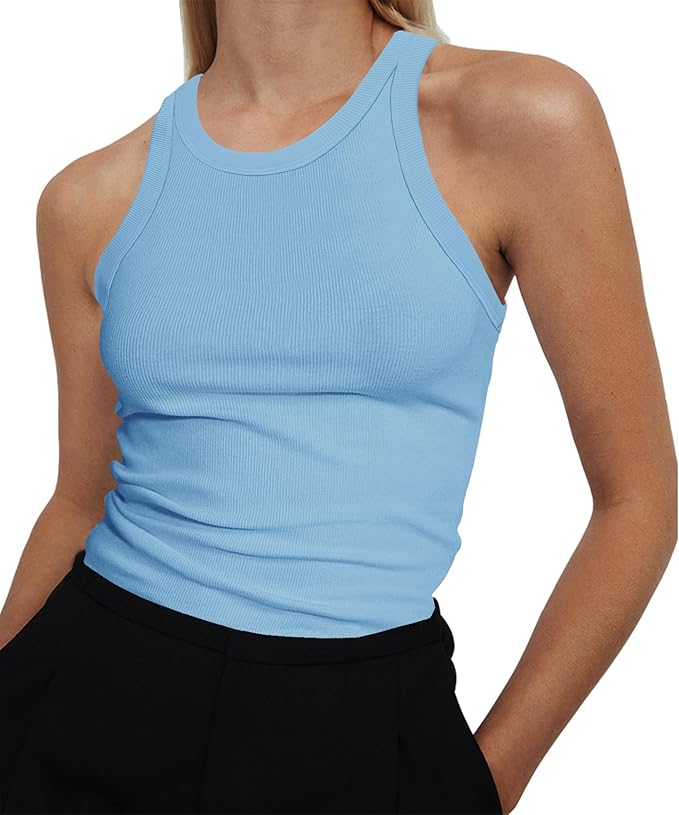
These types of tank tops are designed to highlight the upper body especially chest, shoulders and arms. They have large armholes and a boxier fit. Think gym vibes but make it street chic.
Ideal for: Workout sessions, casual hangouts, concert nights
5. Types of Tank Tops – Cropped
Cropped tank tops intentionally expose the midriff area unlike regular tank tops.
Great for: High-waisted jeans, skirts, festivals, or sunny brunches
6. Halter Neck Tank Top
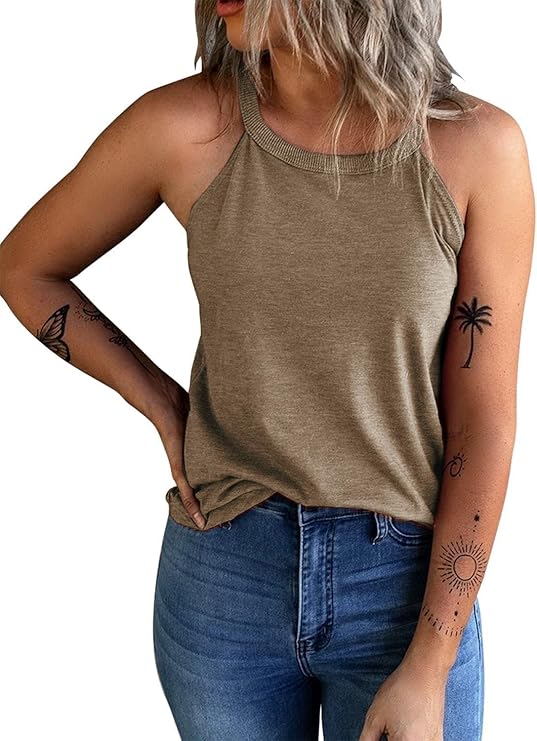
Tied or fastened around the neck, halter tanks highlight the shoulders and collarbone like no other.
Perfect for: Dressy occasions, summer parties, rooftop cocktails
7. Built-in Bra Tank (Shelf Bra Tank)
These tanks come with a built-in bra, saving you from the ol’ bra strap peekaboo.
Works for: Low-impact workouts, lounging, casual errands
8. Asymmetrical Tank Top
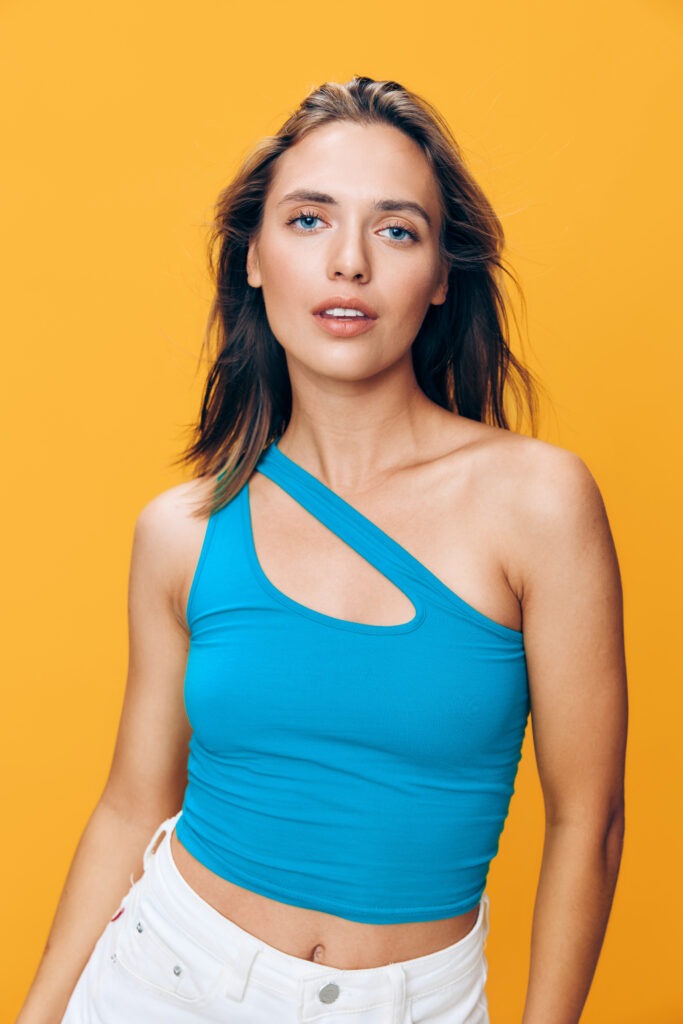
These tank tops have one strap and a diagonal cut. Asymmetrical tanks break all the rules, in the best way.
Best for: Statement outfits, fashion-forward looks, nights out
9. High Neck Tank Top
High neck tanks are sleek, sophisticated, and modern .
Perfect for: Office layering, chic daywear, minimalistic outfits
10. Swing Tank Top
Loose, flowy, and breezy—the swing tank is like wearing air. It’s forgiving in all the right places.
Ideal for: Hot days, relaxed fits, layering over swimsuits
11. Double Strap or Multi-strap Tank Top
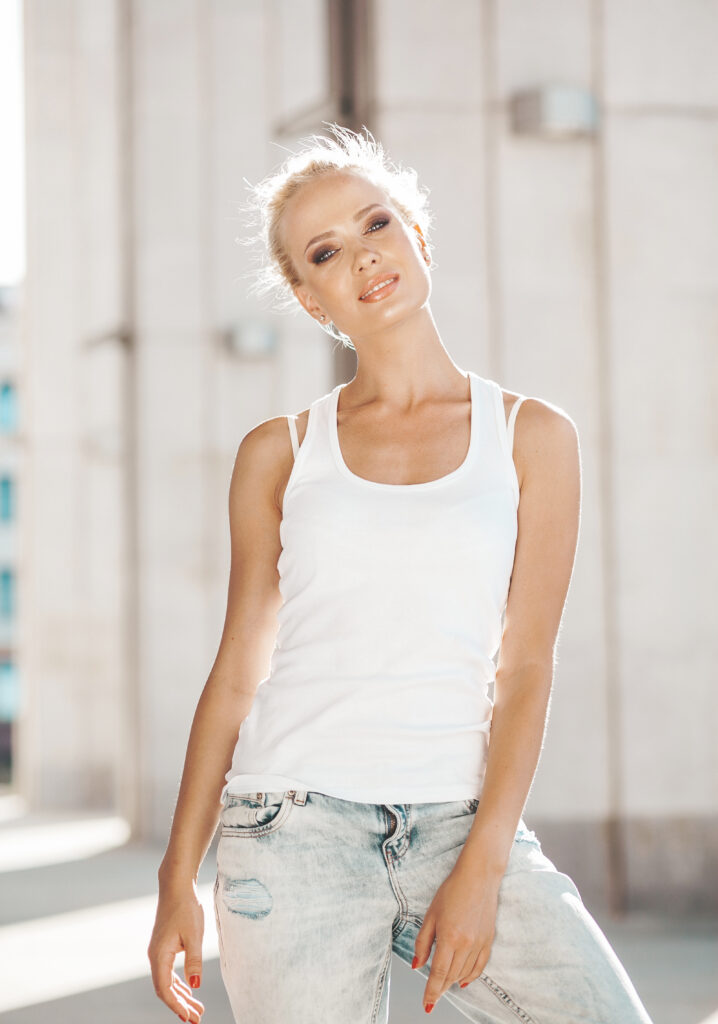
Double the straps, double the fun. These tanks add an extra flair with multiple strap designs.
Perfect for: Eye-catching looks, unique layering pieces
How to Choose the Right Types of Tank Tops for You?
Here’s a quick cheat sheet:
1. Think About the Occasion
- Gym day? Go racerback or muscle.
- Office chic? Opt for high neck or basic tank under a blazer.
- Date night? Asymmetrical or halter is your BFF.
2. Consider Your Comfort Level
- Don’t love showing your arms? Go for a high neck or wide-strap tank.
- Want support? Built-in bra tanks are a dream.
3. Match Your Aesthetic
- Minimalist? Solid-colored basics or high necks.
- Bold & trendy? Cropped, asymmetrical, or multi-strap.
- Boho? Swing tanks, spaghetti straps, and soft patterns.
FAQs About Types of Tank Tops
- Can tank tops be worn in winter?
Heck yes! Just layer them under sweaters, blazers, or flannels. Bonus: they add warmth without bulk.
- Are tank tops considered casual?
Usually, yes. But throw on a structured blazer or a statement necklace, and suddenly you’re boardroom ready.
- What material is best for tank tops?
Cotton is breathable and comfy. Spandex blends are great for workouts. Rayon and modal bring a softer, flowy vibe.
- How do I avoid visible bra straps?
Try strapless bras, racerback bras, or tanks with built-in support. Or hey, embrace the straps—fashion rules are made to be broken.
Conclusion
Tank tops may look simple, but they have layers (pun intended). Whether you’re dressing up, cooling down, or just trying to feel good in your own skin, there’s a tank out there for you. From spaghetti straps to high necks and everything in between, the tank top universe is bursting with style potential. Remember to pick out a tank top that matches your aesthetic and is right for the occasion. Save this quick guide for later and remember, caring is sharing. Share this article with a friend who is in the market for some versatile tank tops as well!
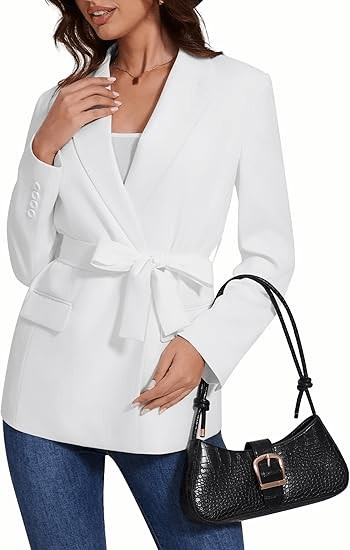
How to Style a White Blazer
A white blazer has this magical way of pulling any outfit together—even the most laid-back look feels instantly elevated. It’s incredibly versatile and a must-have if you’re aiming for something chic, flattering, and feminine. Most importantly, with all the fresh trends popping up right now, the white blazer is seriously stealing the spotlight. I’m totally here for it! The best part? You can 100% wear one without giving up your love for comfort. Whether you’re running errands, heading to brunch, hopping on a Zoom call, or just want to add a little polish to your everyday style, this closet staple is way more versatile (and wearable!) than you think. Here’s your go-to guide for how to style a white blazer while keeping it cozy, chic, and true to you.
Types of Blazers
Classic (Single-Breasted) Blazer
This type of blazer has one column of buttons and a narrow overlap fabric like the one below. It is different from a double-breasted blazer which has two columns of buttons. These can work for both casual and professional looks.
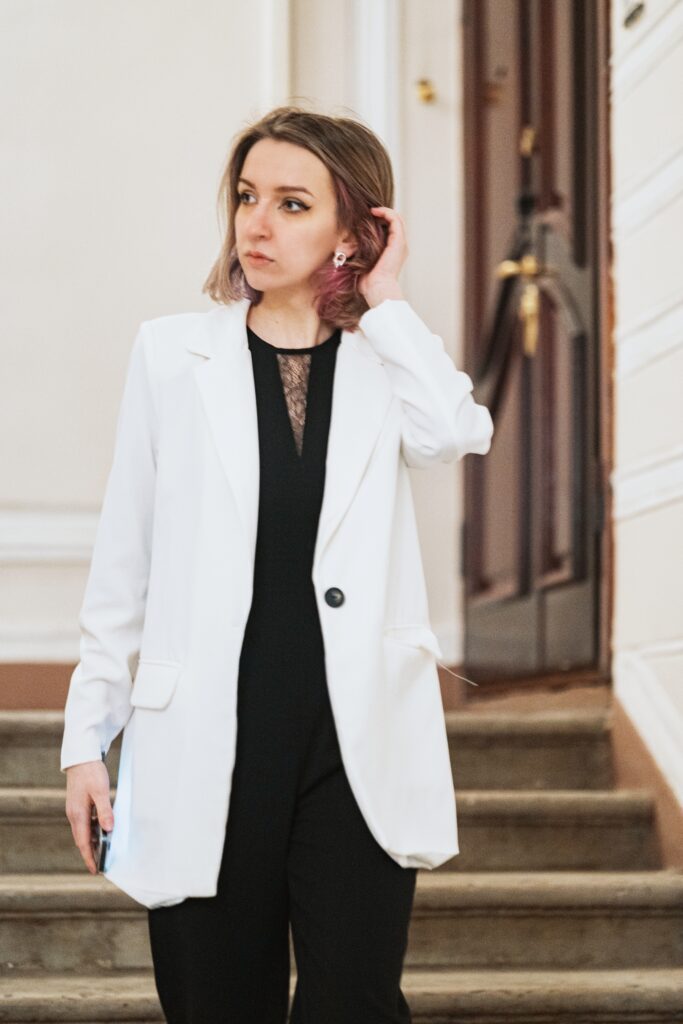
Double-Breasted Blazer
A double-breasted blazer has two columns of buttons and an overlapping front closure. The first column of buttons is functional, while the other is ornamental. This style is considered to be more formal than the single-breasted blazer.
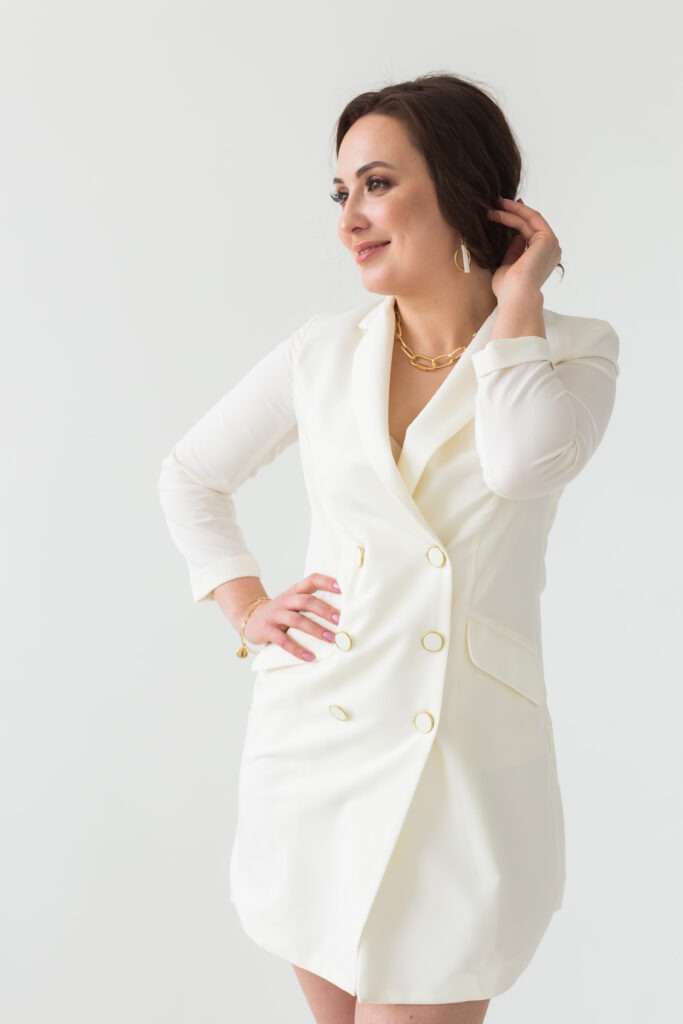
Oversized Blazer
This type of blazer is best for a laid-back street look. Fun fact, in the 1980’s, oversized blazers were a symbol of power and authority in the workplace! This trending piece can work equally as well for formal occasions and more casual ones. My favorite thing about oversized blazers is that you can find them at your local thrift stores in the menswear section. Be sure to go up a size to get that trendy, loose fit.
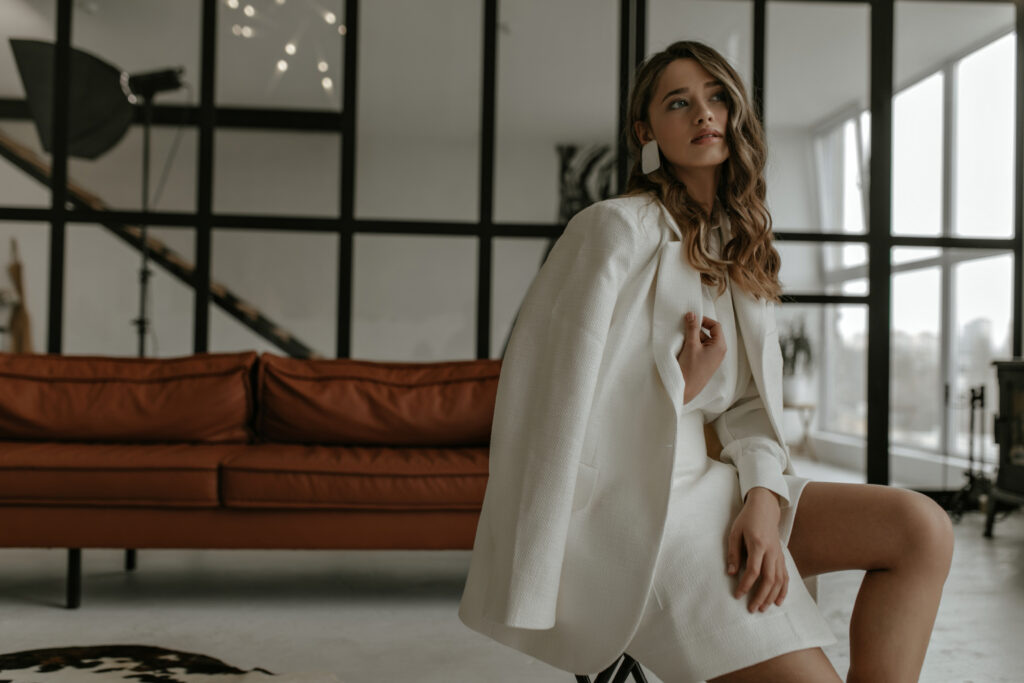
Cropped Blazer
The cropped blazer is a shorter version of the traditional blazer, typically ending above the waist or at the natural waistline. It is designed to accentuate your waist and elongate your frame.

Boyfriend Blazer
This blazer is a type of cut that is made to look oversized and fit loosely. The bottom hem is longer and hits the upper thigh. It is supposed to look like you just threw on your boyfriend’s blazer. Many people refer to it as a “borrowed from the boys” type of blazer.
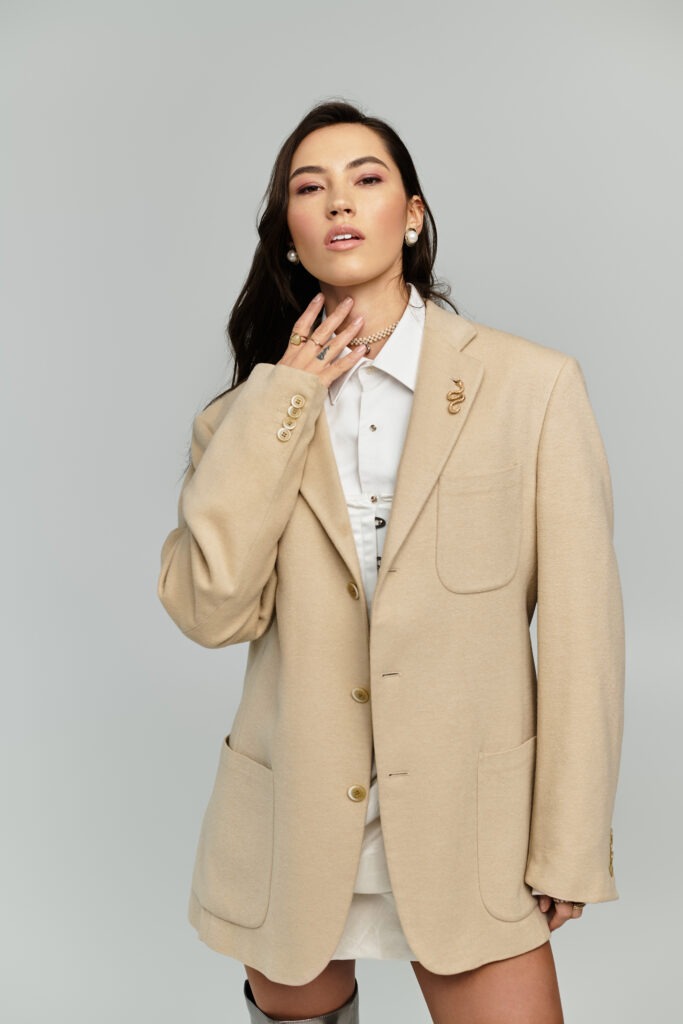
Tuxedo Blazer
This is a more sleek, tailored look and features satin lapels and a slightly more dramatic cut. It is best suited for cocktail parties, date nights, or elevated looks.
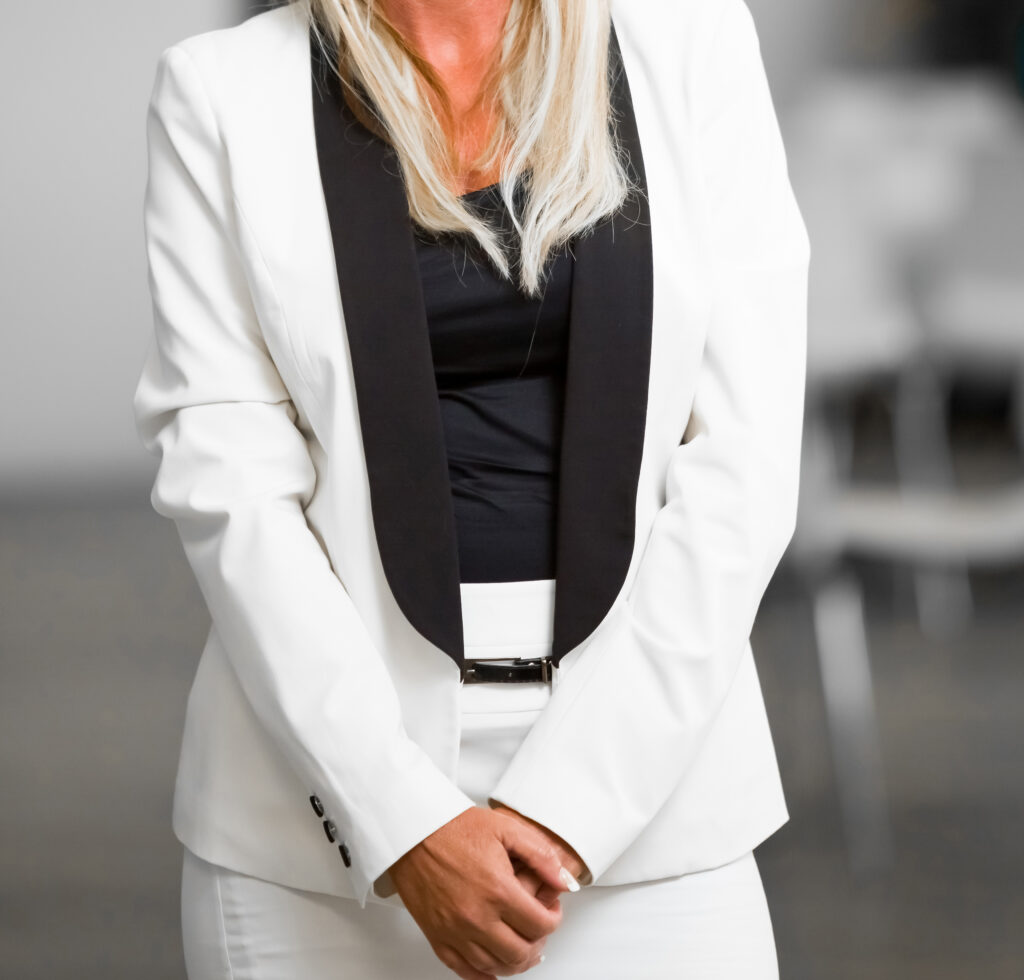
Peplum Blazer
This type of blazer creates curves for highlighting the waist. It is feminine and flattering, especially on hourglass or pear-shaped bodies.

Belted Blazer
This type of blazer comes with a built-in or removable belt to clinch the waist. It is perfect for a sleek wear-to-work look.

Knit or Sweater Blazer
Cozy and comfortable without losing structure. It is made from soft, stretchy knit fabrics and combines the polish of a blazer with the feel of a cardigan. It is perfect for layering and travel.
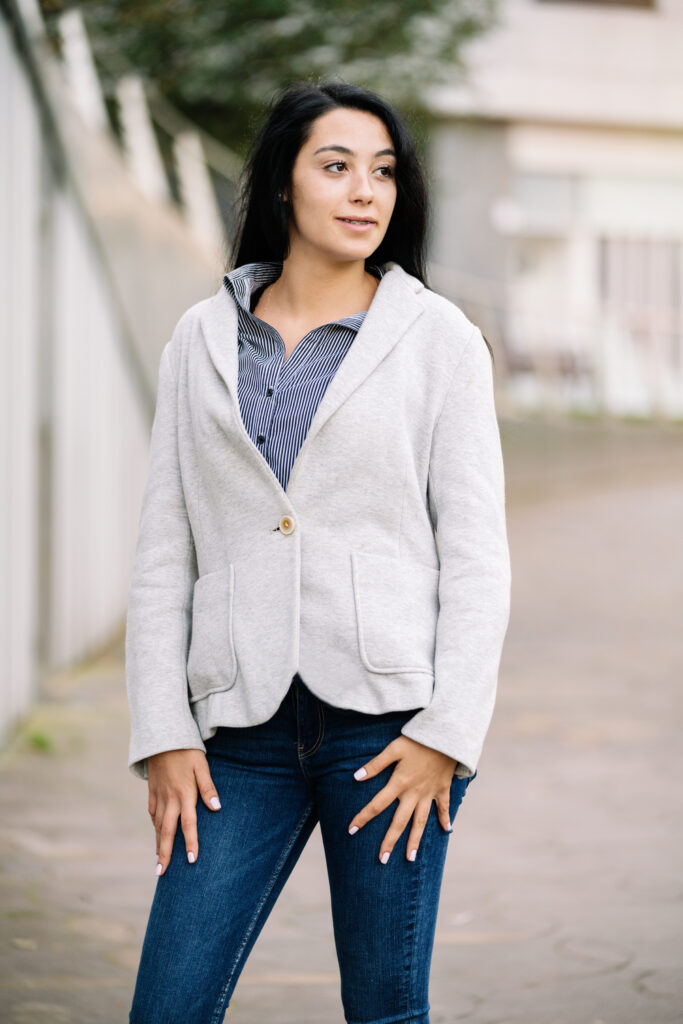
Rules for Wearing a White Blazer
The magic starts with a blazer that fits you just right. Oversized? Great. Cropped? Even better. Tailored? Yes please—as long as it moves with you. No one’s got time for fashion that fights back. I would say though, pay attention to the shoulder pads when looking for a blazer. They should not stick out too much as as they would on a hanger. Remember that one of the most important things about rules in fashion is that they are meant to be broken! Find a blazer that matches your vibe and makes you feel confident.
Comfy Fit Tips:
- Choose soft, breathable fabrics like linen, cotton, or stretch blends.
- Oversized blazers give that effortless, cool-girl vibe (and feel like a cozy hug).
- Look for unlined or lightly structured styles for maximum flexibility.
How to Style a White Blazer – Outfit Combos
The Casual Cool Combo
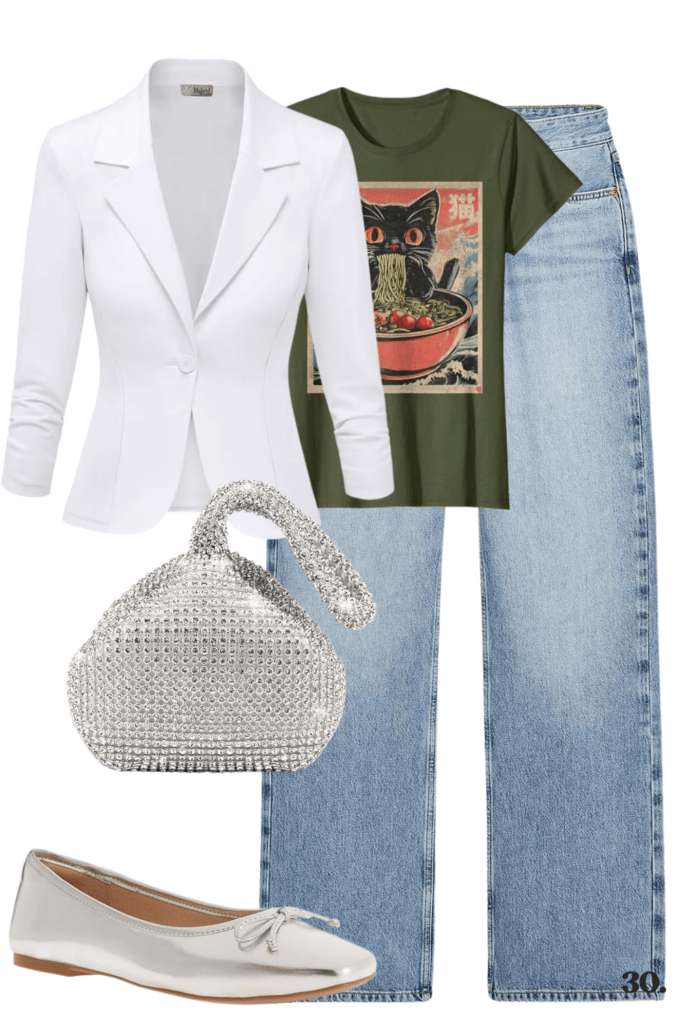
Shop the look: Blazer | Clutch | Graphic Tee | Ballet Flats | Jeans
Need a quick way to look instantly pulled together with zero effort? This is your uniform.
Try pairing with:
- A basic tee or tank (graphic or plain, your call)
- High-rise jeans or mom jeans
- White sneakers, ballet flats, or low-heeled mules
Top it off with loose waves or a messy bun, and boom—you’re a Pinterest board.
How to Style a White Blazer – The Zoom-Call Chic Look
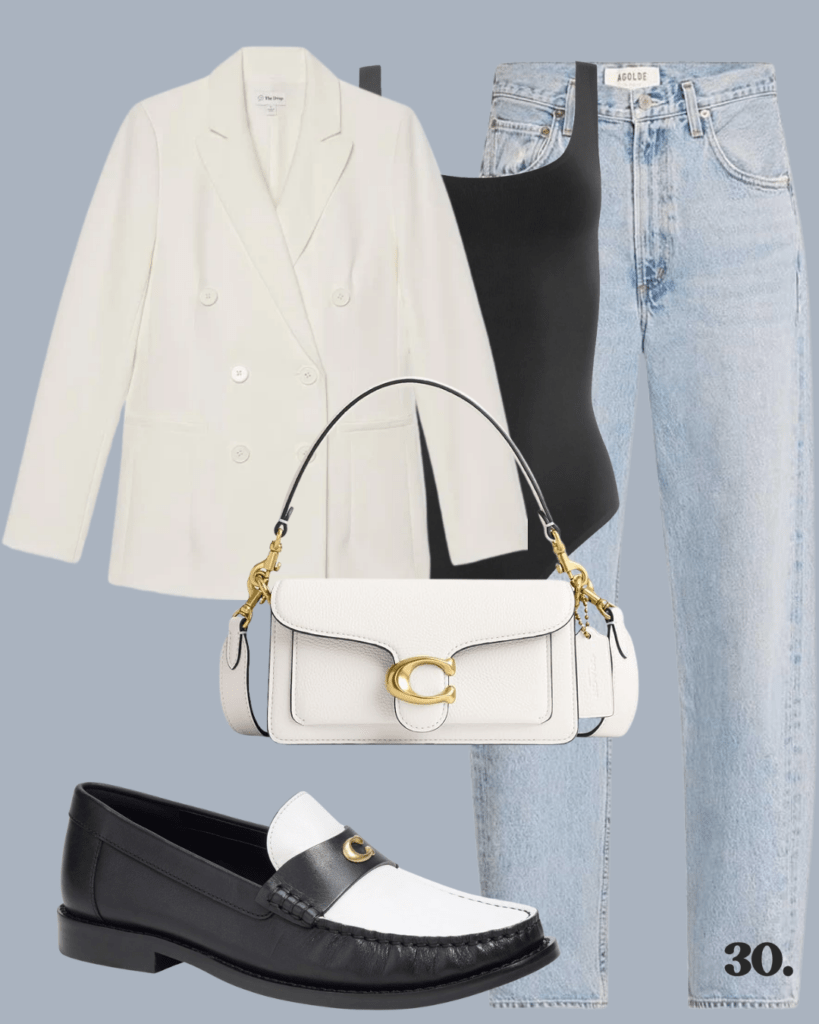
Shop the look: Blazer | Bodysuit | Coach Bag | Coach Shoes | Jeans
Whether you work from home or just want to elevate your “desk to dinner” style, a white blazer makes you look like you’ve got your life together (even if you’re wearing leggings underneath). A double-breasted suit blazer has a more professional look to it.
Style it with:
- A soft knit tank or bodysuit
- Comfortable jeans
- Delicate jewelry and a swipe of lip balm or gloss
Comfy on the bottom, business on the top. It’s the mullet of outfits—but make it fashion.
How to Style a White Blazer for a Weekend Errand Run
Running errands doesn’t mean running from style. A white blazer adds just enough polish to make your grocery run feel like a runway moment.
Pull it together with:
- A fitted crop top or ribbed tank
- Biker shorts or joggers
- Chunky sneakers or sporty slides
Toss your hair in a pony, grab your tote bag, and let the compliments roll in.
The Brunch-to-Bar Outfit
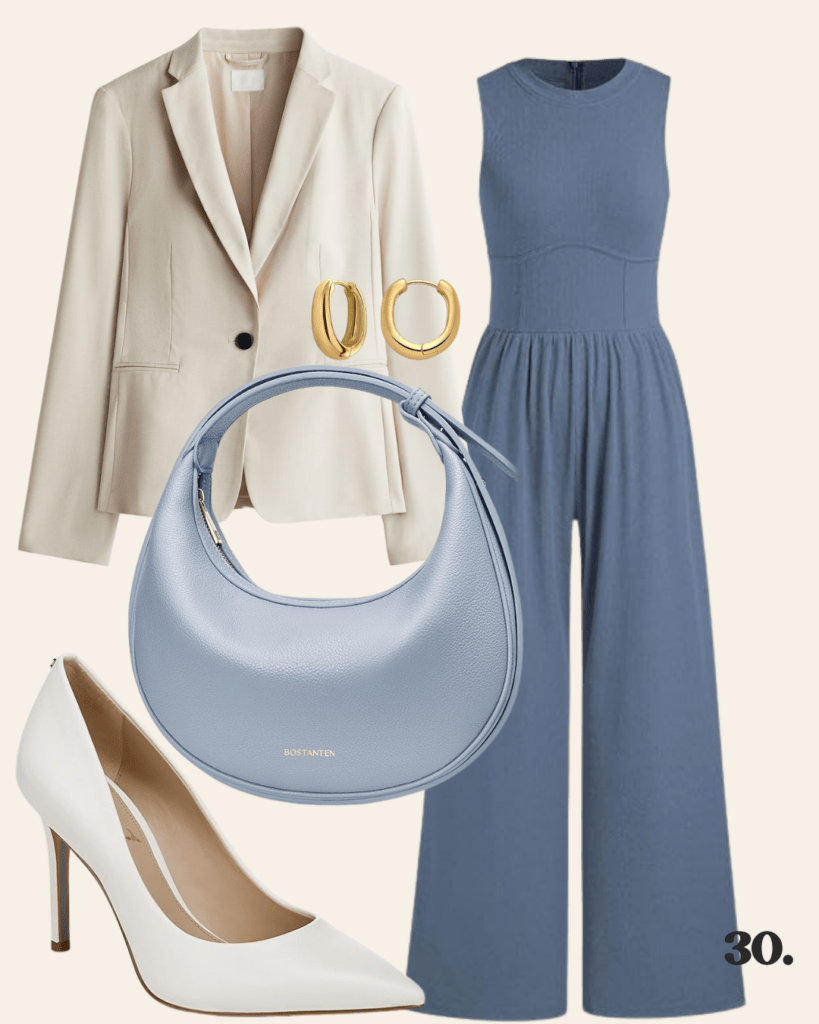
Shop the look: Blazer | Earrings | Heels | Jumpsuit | Shoulder Bag
Want to dress it up without breaking out the stilettos? Your white blazer has you covered.
Go for:
- A jumpsuit dress or midi skirt and cami combo
- Layered gold jewelry
- Block heels or sleek ankle boots
It’s the kind of outfit that looks expensive—but feels like pajamas.
Pinterest Inspired White Blazer Outfit Idea
Cute Classy Look
Shop Similar: Blazer | Tube Top | Jeans | Strappy Open Toe Heel
Accessories That Elevate (Without Overdoing It)
The white blazer is a blank canvas. Your accessories can totally shift the vibe from casual to glam without adding discomfort.
Try these:
- Statement earrings or dainty layered necklaces
- A structured mini bag or crossbody
- Hair clips, claw clips, or a silk scarf for a pop of color
- A neutral belt to cinch the waist for more shape (optional but fab)
FAQs: How to Style a White Blazer for Comfort-Loving Women
Q: Can I wear a white blazer year-round?
Definitely. Go for linen or cotton in spring/summer, and heavier textures like wool or boucle in fall/winter.
Q: Is it okay to wear a white blazer with sneakers?
Yes, yes, and YES. It’s a go-to for comfy style that still looks polished.
Q: What if I want a pop of color—can I still wear a white blazer?
Absolutely! Bright tops, bold prints, or colorful accessories look amazing under a white blazer.
Q: Does a white blazer work with dresses?
It pairs beautifully with everything from floral sundresses to little black dresses. Just toss it over your shoulders for an effortless vibe.
Final Thoughts on How to Style a White Blazer
So, how to style a white blazer if comfort is non-negotiable? Easy—pick pieces that move with you, layer smart, and add just enough flair to feel like you. It’s all about balance. You don’t have to wear stilettos or squeeze into rigid pants to look stylish. A white blazer lets you float between relaxed and refined with total ease.
You already know how to feel good in your clothes. Now, you’ve got the tools to look good too—without sacrificing comfort for even a second. Now go rock that blazer like the effortless queen you are.
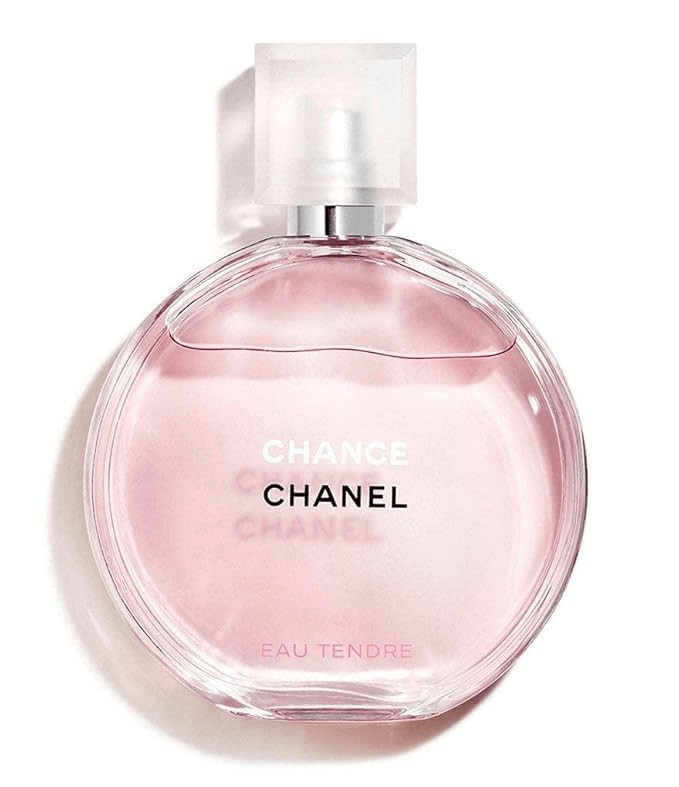
Best Spring Fragrances
Spring is a time of renewal, and what better way to refresh your daily routine than with a new fragrance? As the weather warms up and nature blooms, switching to a lighter, more refreshing scent can elevate your mood and style. For women who prioritize comfort, finding the perfect balance between floral, fruity, and musky notes is essential. This guide explores the best spring fragrances that offer long-lasting comfort and effortless sophistication.
Why Choose a Spring Fragrance?
Spring scents are designed to complement the season’s mild temperatures and blossoming landscapes. Unlike the heavy, spicy notes of winter, spring fragrances lean towards:
- Fresh and Citrusy Notes – Lemon, bergamot, and grapefruit provide an energizing start to your day.
- Floral and Green Accords – Jasmine, rose, peony, and violet add a crisp, airy touch.
- Soft Musk and Woody Undertones – Sandalwood, vanilla, and white musk create a soothing, grounded base.
By choosing a fragrance that blends these elements, you can achieve a scent that’s both refreshing and comfortable for daily wear.
5 Best Spring Fragrances for Women in 2025
Chanel Chance Eau Tendre

- Why it’s great for spring? This delicate and airy fragrance blends citrus, jasmine, and white musk for a soft, romantic touch.
- Best for: Casual everyday wear and special occasions.
- Key Notes: Grapefruit, jasmine, musk, and white flowers.
Dior Miss Dior Blooming Bouquet
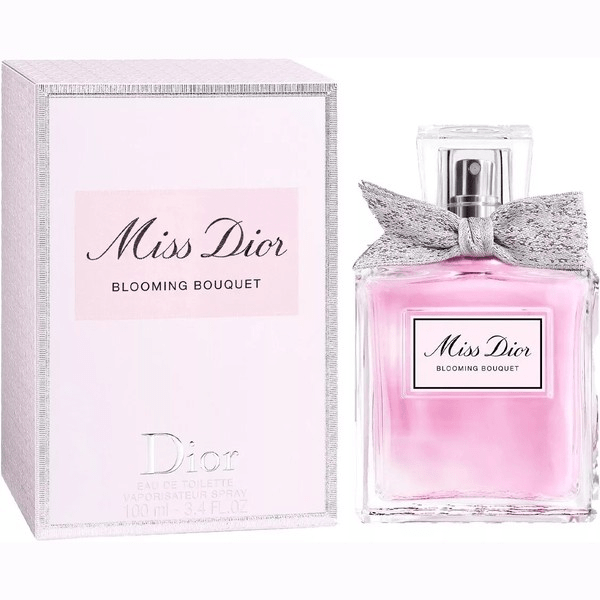
- Why it’s great for spring? A feminine floral scent with peony, rose, and bergamot that feels fresh and uplifting.
- Best for: Springtime brunches and daytime outings.
- Key Notes: Peony, rose, bergamot, and musk.
Jo Malone London Peony & Blush Suede

- Why it’s great for spring? A luxurious and comforting floral fragrance with a hint of fruity sweetness.
- Best for: Women who enjoy a soft yet sophisticated scent.
- Key Notes: Peony, red apple, suede, and jasmine.
Gucci Bloom
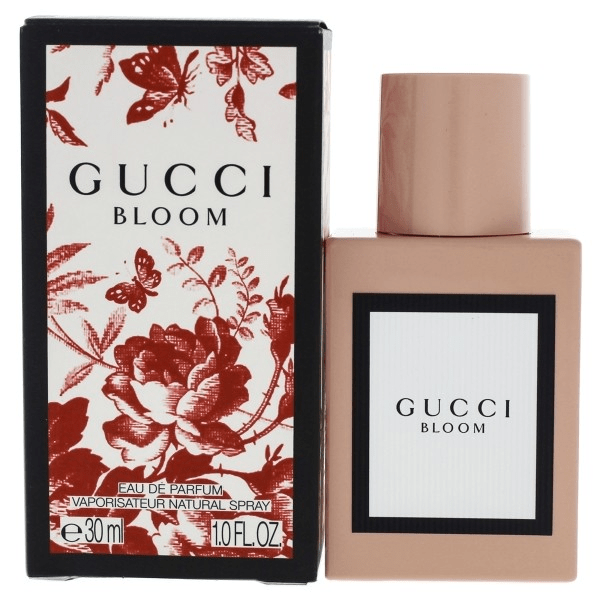
- Why it’s great for spring? A rich yet fresh floral bouquet featuring tuberose and jasmine that embodies the essence of spring.
- Best for: Elegant evenings and garden parties.
- Key Notes: Jasmine, tuberose, rangoon creeper, and sandalwood.
Marc Jacobs Daisy Eau So Fresh
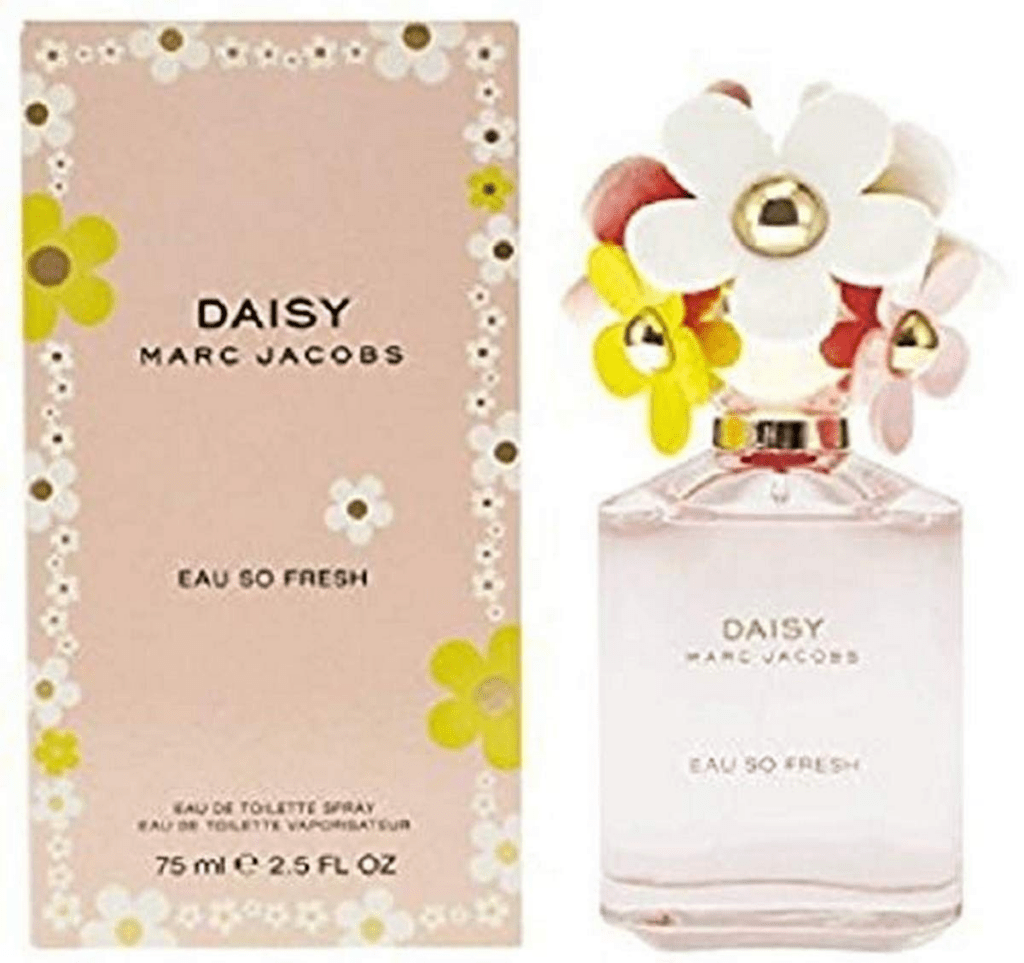
- Why it’s great for spring? A light and playful fragrance with fruity and floral elements that evoke a sense of joy and freedom.
- Best for: Women who love a youthful, fresh scent.
- Key Notes: Raspberry, grapefruit, violet, and musk.
How to Choose the Best Spring Fragrance for You
When selecting a spring fragrance, consider these factors:
1. Longevity & Projection
- Do you prefer a scent that lingers all day or one that stays close to the skin?
- Eau de Parfum lasts longer, while Eau de Toilette is lighter and fresher.
2. Occasion & Setting
- Light citrus scents work well for casual wear.
- Floral-woody blends are ideal for office environments.
- Musk-infused fragrances add depth for evening events.
3. Comfort Factor
- If you prioritize comfort, go for smooth, airy scents with minimal sharpness.
- Fragrances with vanilla, musk, and sandalwood are known for their calming properties.
FAQs About the Best Spring Fragrances
1. What type of fragrance is best for spring?
Fresh, floral, and citrus-based fragrances work best for spring. Look for blends featuring bergamot, peony, jasmine, and light woods for an airy yet comforting aroma.
2. Can I wear my winter fragrance in spring?
While you can, winter scents are typically heavier and may feel overwhelming in warmer weather. Opt for something fresher with lighter notes.
3. How do I make my fragrance last longer?
- Apply on pulse points (wrists, neck, behind ears).
- Moisturize your skin before application.
- Avoid rubbing your wrists together as it breaks down the scent molecules.
4. How many sprays should I use for a spring fragrance?
Two to four sprays should be enough, depending on the fragrance’s strength. Light fragrances can be reapplied during the day if needed.
5. Is it necessary to switch fragrances for different seasons?
It’s not mandatory, but changing your scent with the seasons enhances your overall experience and keeps your fragrance collection dynamic.
Conclusion
Spring is the perfect time to refresh your fragrance collection with scents that embody warmth, freshness, and comfort. Whether you prefer citrusy bursts, floral undertones, or musky finishes, the best spring fragrances offer a harmonious blend that suits any occasion. Choose a scent that aligns with your personal style and enjoy the confidence and elegance it brings to your everyday life.

How to Wear a Crossbody Bag
We all love a good crossbody bag! They are a staple accessory for both men and women, offering convenience, functionality, and style. However, many people struggle with finding the best way to wear one without discomfort. Whether you’re heading to work, traveling, or simply running errands, knowing how to wear a crossbody bag properly can make all the difference.
In this guide, we’ll cover everything you need to know about how to wear a crossbody bag while keeping comfort a top priority. From choosing the right fit to styling tips, this article will help you make the most out of your favorite accessory.
Why Choose a Crossbody Bag?
Before diving into how to wear a crossbody bag, let’s look at why it’s such a great choice:
- Hands-Free Convenience – A crossbody bag keeps your essentials within reach without the need to carry anything in your hands.
- Even Weight Distribution – Unlike a shoulder bag that can strain one side of your body, a crossbody bag distributes weight more evenly.
- Security and Safety – The bag stays close to your body, making it harder for pickpockets to access.
- Versatile and Stylish – Crossbody bags come in different sizes, materials, and designs, making them perfect for casual outings, work, or travel.
How to Wear a Crossbody Bag Comfortably
1. Adjust the Strap for the Perfect Fit
One of the most important factors in wearing a crossbody bag is adjusting the strap to the right length.
- If the bag hangs too low, it may swing too much and become uncomfortable.
- If it’s too high, it may feel restrictive.
- Ideally, the bag should rest at or just above your hip for optimal comfort and accessibility.
2. Find the Right Side for You
Some people prefer wearing their crossbody bag on the right side, while others find the left side more comfortable. Try both and see which works best for your daily activities.
- Right-handed individuals often wear the bag on their left side for easier access.
- Left-handed individuals may prefer wearing the bag on their right side.
3. Choose the Right Bag Size
A bulky or oversized crossbody bag can be uncomfortable, especially if you carry too much inside. Stick to a bag size that fits your essentials without feeling heavy.
- Small bags are perfect for carrying a phone, wallet, and keys.
- Medium bags work well for work or travel, holding extra items like a tablet or a water bottle.
- Large bags can be useful but may cause strain if overpacked.
Styling Tips: How to Wear a Crossbody Bag with Different Outfits
1. Casual Everyday Look
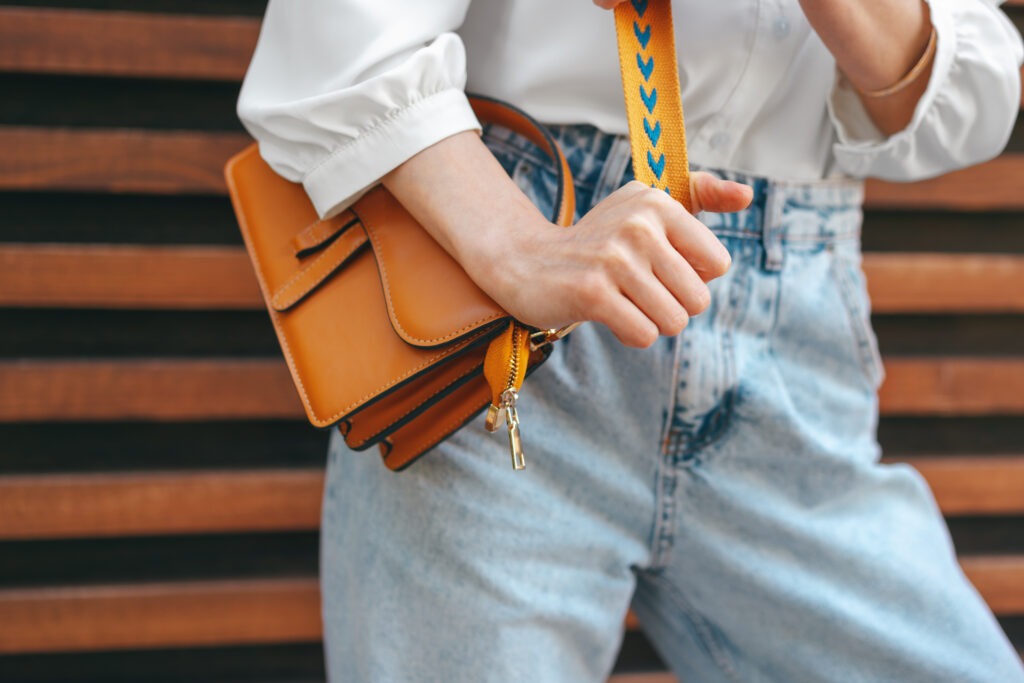
For a relaxed, everyday look, a small or medium-sized crossbody bag pairs well with jeans, a t-shirt, and sneakers. Opt for neutral colors like black, brown, or gray for versatility.
2. Work and Professional Wear
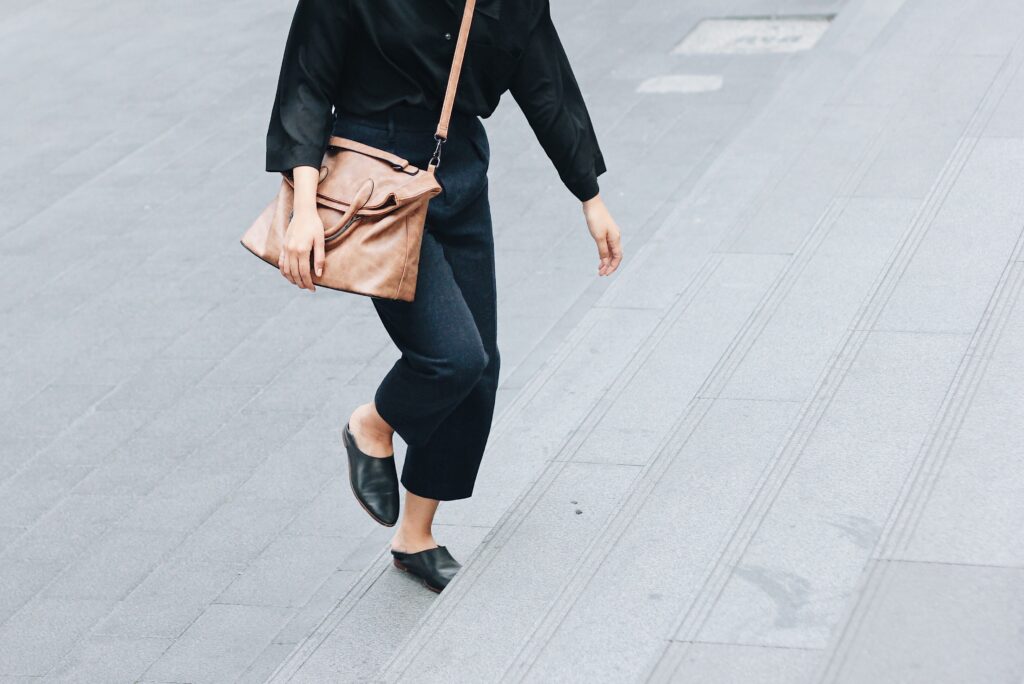
A structured crossbody bag in leather or faux leather adds a polished touch to business casual outfits. Pair it with a blazer, dress pants, or a knee-length dress for a sleek appearance.
3. Travel and Outdoor Adventures

If you’re traveling or exploring, choose a lightweight crossbody bag with multiple compartments for easy organization. Wear it across your chest for added security and accessibility.
4. Evening and Special Occasions
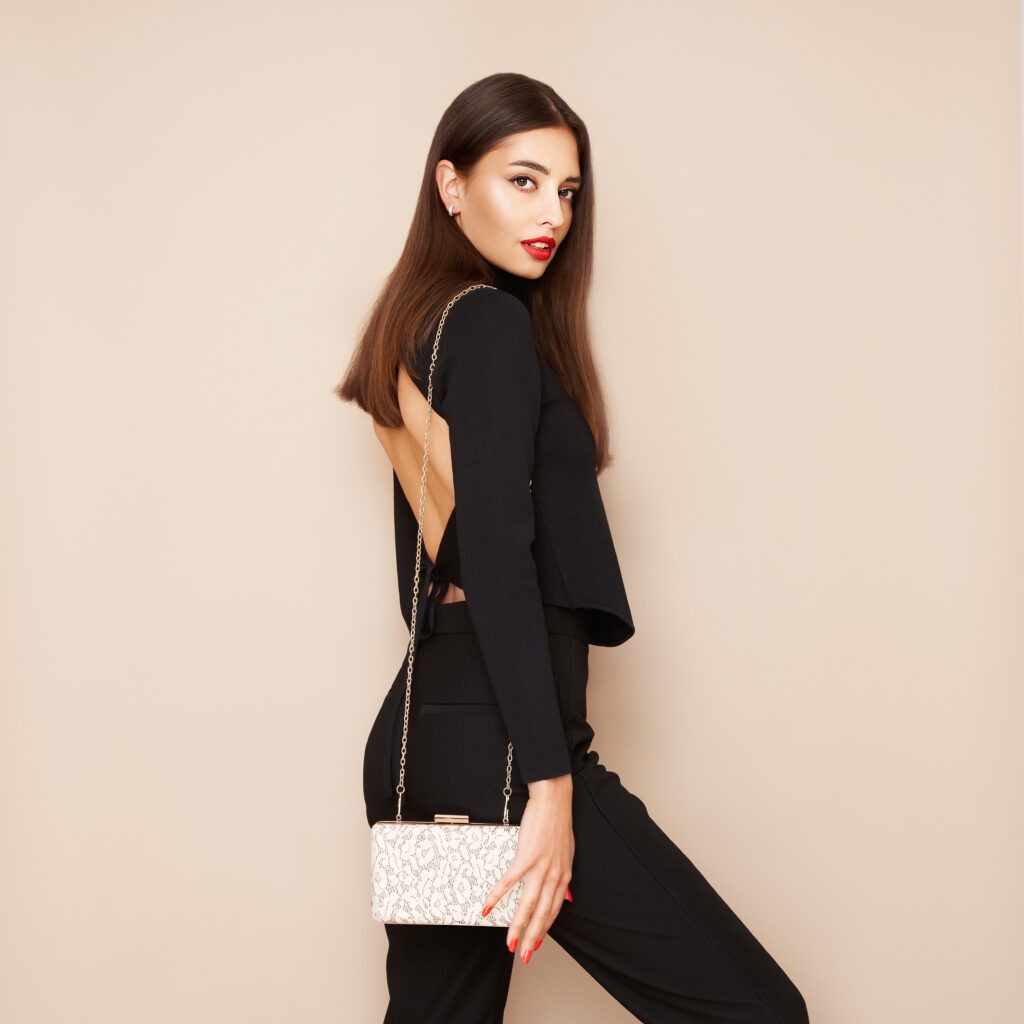
For a dressier occasion, opt for a sleek, compact crossbody bag with elegant detailing. A chain-strap crossbody bag pairs beautifully with dresses and heels.
How to Prevent Shoulder or Back Pain When Wearing a Crossbody Bag
Wearing a crossbody bag for long periods can sometimes cause discomfort. Here are some tips to prevent shoulder and back pain:
- Distribute Weight Evenly – Avoid carrying unnecessary items that add weight to your bag.
- Use a Padded Strap – If your bag’s strap is thin, consider adding a padded cover for extra comfort.
- Switch Shoulders Periodically – Alternating shoulders can help reduce strain.
- Maintain Good Posture – Avoid slouching or leaning to one side when wearing your bag.
Frequently Asked Questions (FAQs)
1. Can you wear a crossbody bag over a coat or jacket?
Yes! When wearing a thick coat, adjust the strap so the bag rests comfortably without feeling too tight. A slightly longer strap works best over bulky outerwear.
2. How do I keep my crossbody bag from sliding?
If your bag constantly slides around, try adjusting the strap tighter or choosing a bag with a textured strap for better grip. Wearing it slightly diagonally across your chest can also help keep it in place.
3. What is the best material for a crossbody bag?
It depends on your needs:
- Leather – Durable and stylish, perfect for professional settings.
- Nylon or Canvas – Lightweight and great for casual outings or travel.
- Faux Leather – Affordable and trendy without sacrificing elegance.
4. Can men wear crossbody bags?
Absolutely! Crossbody bags are a functional and stylish option for men. They offer convenience while maintaining a modern, masculine look.
5. Is a crossbody bag safe for travel?
Yes, a crossbody bag is one of the safest travel bag options because it stays close to your body. For extra security, choose one with anti-theft features like RFID-blocking compartments or lockable zippers.
Conclusion
Learning how to wear a crossbody bag the right way can make a huge difference in your comfort and overall style. Whether you’re running errands, heading to work, or traveling, the key is to find the right fit, strap length, and style for your needs. By following these tips, you can enjoy the convenience and fashion of a crossbody bag without any discomfort.
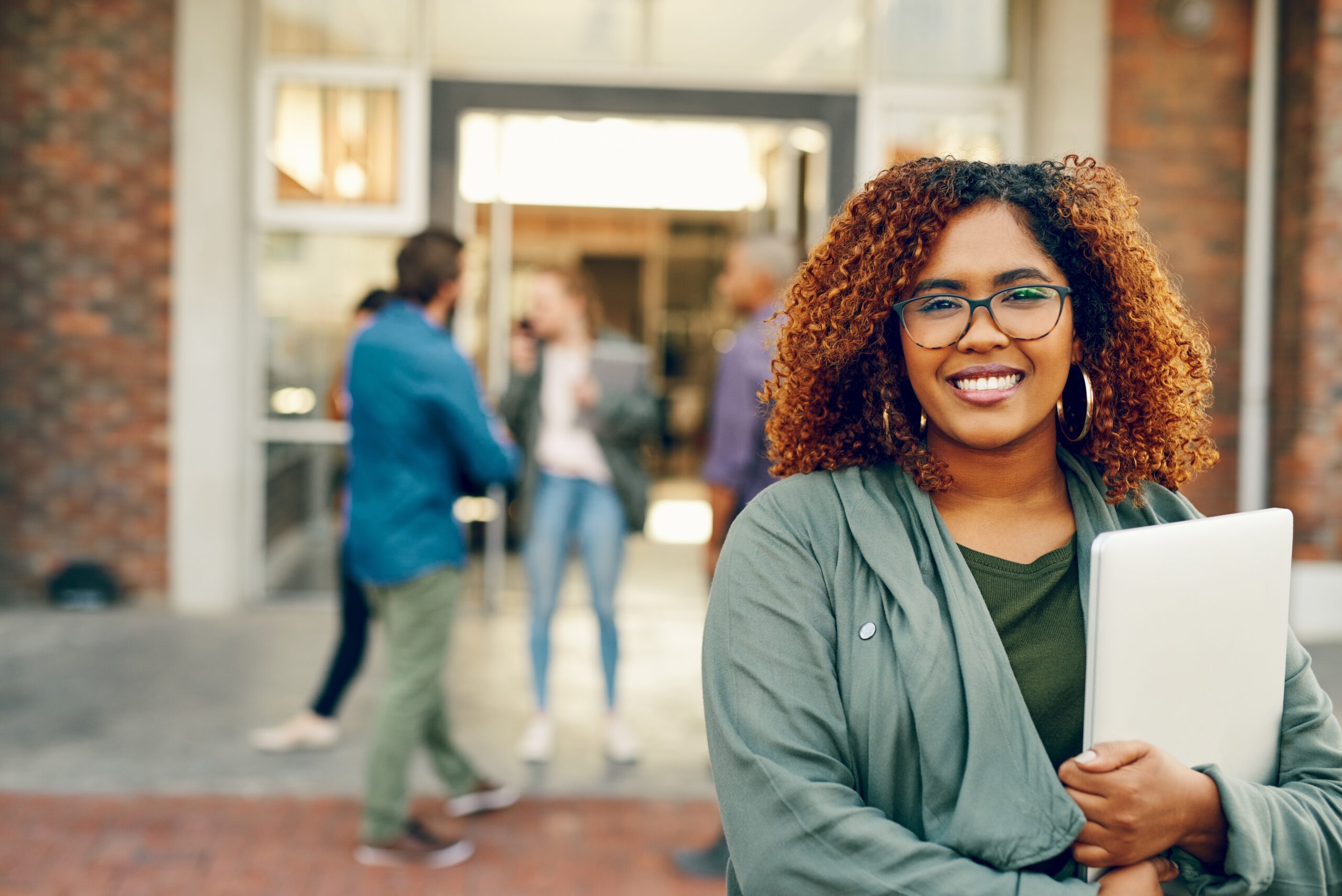
Going to College in Your 30s
So, you’re thinking about going to college in your 30s? Short answer. Go for it! Whether you are contemplating a career switch, aiming for that long-overdue degree, or simply looking to challenge yourself, going back to school can open up a wide array of doors for you. To be honest, stepping back into the classroom can feel both exciting and intimidating especially if you decide to attend college in person. But this can actually work to your advantage. Unlike your younger counterparts, you’re entering college with real-world experiences, a stronger sense of purpose, and a laser-focused attitude! In this article, we will dive into what you can expect, the benefits, and how to make the most of this exciting new journey.
Why Going to College in Your 30s Makes Sense
1. Career Advancement & Higher Earnings
One of the biggest reasons people return to school is to boost their career opportunities. With a degree, you can qualify for better jobs, promotions, and even entirely new career paths. While you’re in your 30s, focus on obtaining a degree in a field that you are actually passionate about. I realized that the things I wanted to do in my 20s no longer bring me happiness in my 30s. Passion is something that unfolds overtime. If at all possible, do something that you love, and you will be sure to stick with it long-term.
2. Personal Growth & Fulfillment
Education isn’t just about job titles and paychecks. It’s also about personal growth. Learning new skills, meeting like-minded individuals, and expanding your knowledge can be incredibly fulfilling especially in your 30s. You will also meet people who are in your age group that have the same goals, which is a great opportunity to expand your social circle.
3. You Know What You Want in Your 30s
At 18, many students enter college because it’s “the next step.” At 30+, you already have a clearer vision of your goals. This means you’re more likely to stay focused on what you need to do in order to get out of there. You won’t be tempted to go out to every social gathering like your schoolmates so sticking to your deadlines will be all the more easier.
4. Online & Flexible Learning Options
Unlike a decade ago, college now offers a variety of flexible learning options—online courses, night classes, hybrid programs—you name it. This makes balancing work, family, and school much easier. If you start off going into the classroom, you can always switch to fully remote as long as the College or University you are attending offers it.
Challenges of Going to College in Your 30s (And How to Overcome Them)
1. Juggling Responsibilities
With work, kids, bills and being a part-time blogger, I sometimes feel like my mind is going 100 miles per hour. With that being said, I had to focus on prioritizing time management. Use planners, digital calendars, and set aside dedicated study hours. Let your family know that you will be unavailable at certain times of the week so that everyone in the household is on the same page. Also, be sure to communicate with your employer that you are going back to college. If you work for a good company, they will understand. 9 times out of 10, they will be cheering you on because you’re committed to your personal growth and development.
2. Feeling Out of Place
Walking into a class full of fresh high school grads might feel awkward especially if you are attending classes in person. I had an online class where about 30 to 40 students were fresh out of High School. Remember that your life experience is an asset, not a drawback. Plus, you’ll likely find other non-traditional students in the same boat the same way I did. There were also students who were older than me. Trust me. You are not alone.
3. Financial Concerns
Going to college in your 30s isn’t cheap, and student loans can be intimidating especially when you’re thinking about having to put your own kids to college within the next 10 – 15 years. Look into grants, scholarships for adult learners, employer tuition reimbursement programs, and flexible payment plans.
4. Self-Doubt
Wondering if you’re too old, too late, or too busy? Kick that mindset to the curb. Education is for everyone, and success stories of 30+ students are everywhere! Join Facebook groups of individuals who are also going back to college. You may even get lucky and find groups specific to your major or specification. Find a support system and share your experiences with them. You will be surprised by how much it will help especially on days when you feel like giving up.
How to Succeed Going to in College in Your 30s
1. Choose the Right Program
- Research accredited schools and programs.
- Look for online or hybrid courses if you need flexibility.
- Make sure your degree aligns with your career goals.
2. Build a Strong Support System
- Let your family and friends know about your goals.
- Connect with professors and advisors.
- Join study groups and online forums for adult students.
3. Develop Time Management Skills
- Use scheduling apps like Google Calendar or Trello.
- Set realistic deadlines for assignments.
- Break big tasks into smaller, manageable chunks.
4. Take Advantage of Resources
- Utilize career counseling services.
- Visit the financial aid office for funding options.
- Make use of free campus resources like tutoring and library services.
FAQs About Going to School in Your 30s
1. Is it too late to go to college in your 30s?
Absolutely not! Many people start or return to college later in life. It’s never too late to invest in yourself.
2. How can I afford college as an adult?
Explore scholarships for adult learners, financial aid, employer tuition reimbursement, and low-cost community colleges.
3. How do I balance work, family, and school?
Time management is key! Use planners, communicate with your support system, and consider part-time or online learning options.
4. Will employers take me seriously if I graduate later in life?
Yes! Many employers value life experience, discipline, and the dedication it takes to earn a degree while managing adult responsibilities.
5. What if I struggle with technology?
Most colleges offer free workshops or tech support. Plus, YouTube tutorials and online forums can help you get up to speed quickly.
Final Thoughts: Your Future is Waiting
Going to college in your 30s is a bold, empowering move. It’s a chance to grow, achieve your dreams, and set yourself up for a brighter future. Sure, there will be challenges, but with determination, a solid plan, and the right support system, you’ll not only survive—you’ll thrive. Leave a comment or share with someone that may benefit from this article. Also, please reach out to me directly if you need some more pep-talk! I’ve got you!

How to Layer Floral Dresses for Spring, Fall, and Winter
The one thing I love about floral dresses is how versatile they are. Flowers are visually pleasing and harmonious and can add freshness to any look. You may think that floral dresses can only be worn during the spring and summer but, with a few tweaks, you will realize that they can be worn in any season. You just need some styling tricks to make it work! In this blog post, I will break down how to style floral dresses for spring, fall, and winter—without spending a fortune.
Spring: Light & Breezy Layers
Spring is that tricky season where it’s cool in the morning but toasty by noon. If you live in the South like I do, you will find that spring feels a lot like summer around midday then the weather begins to cool down later in the afternoon. The solution? Light layering that keeps you comfortable throughout the day.
1. Add a Denim Jacket or Lightweight Cardigan

- A classic blue denim jacket gives your floral dress a casual, fresh vibe.
- A pastel or neutral cardigan adds a soft, feminine touch.
- Opt for cropped styles to define your waist and create a flattering silhouette.
2. Play with Sheer Tights or Socks
- If it’s still a bit chilly, throw on sheer or patterned tights.
- Ankle socks with sneakers or loafers give your look a quirky, stylish edge.
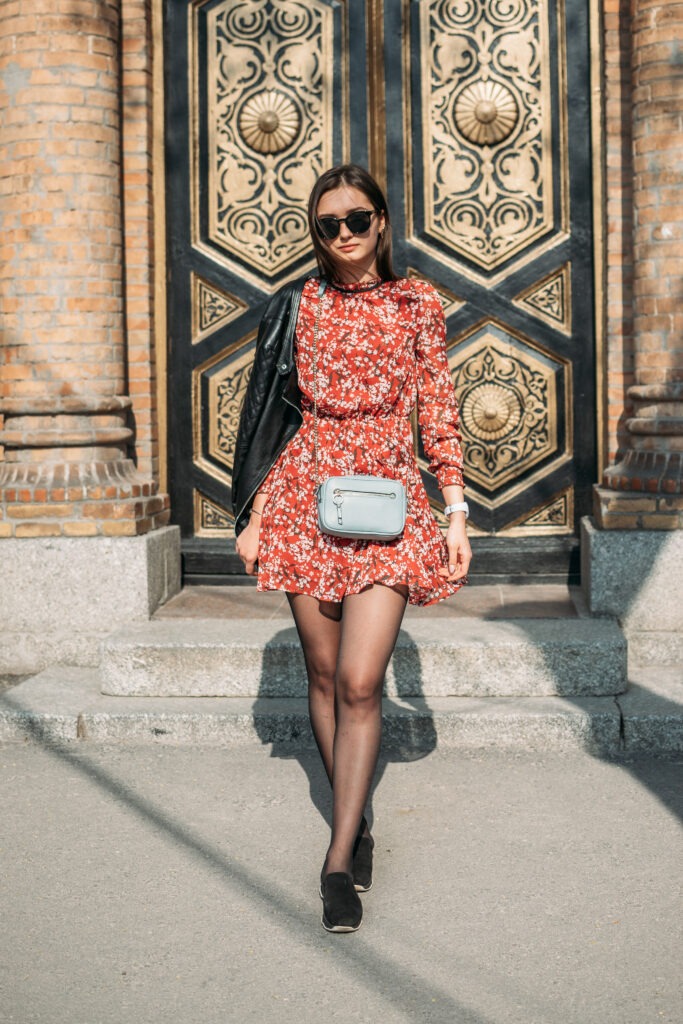
3. Opt for Layering Tees or Blouses
- A fitted white tee under a spaghetti-strap floral dress adds a ‘90s-inspired charm.
- A button-down blouse layered under a dress gives an effortlessly chic, preppy feel.
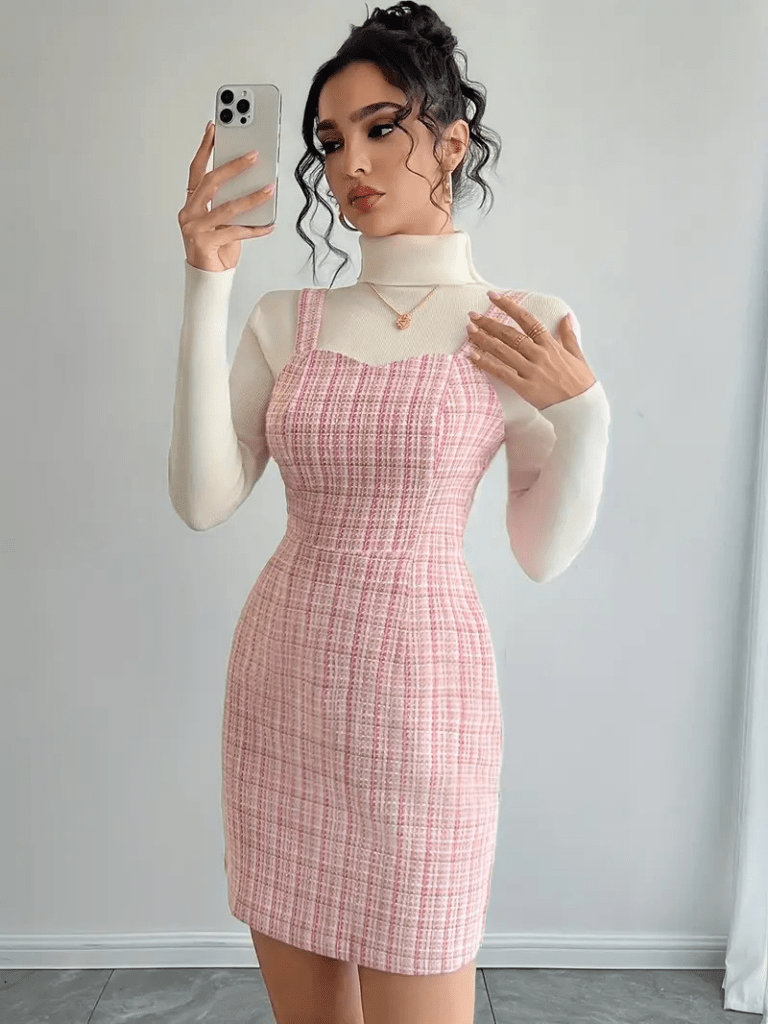
Shop Similar: Turtleneck | Tweed Sleeveless Dress
4. Choose Breathable Footwear
- White sneakers keep it casual and trendy.
- Ballet flats or ankle boots add a touch of elegance.
- Open-toe mules work well for warmer days.
Shop: Baby Doll Dress | Floral Smocked Ruffle Maxi Dress | Collared Neckline Button Down Floral Print Dress | White Denim Jacket
Fall: Cozy & Stylish Transitions
Did someone say pumpkin spice latte? We all love fall, the season of crisp air and cozy layering. During this time of year, it is time to get creative!
1. Swap Lightweight Jackets for Structured Blazers or Leather Jackets
- A plaid blazer adds a polished, autumnal touch.
- A faux leather moto jacket toughens up the softness of florals.
- A trench coat keeps things sleek and sophisticated.
2. Layer with Chunky Sweaters & Knits
- Wear a cropped sweater over your dress for an instant skirt-and-top illusion.
- A long, oversized cardigan paired with a belt creates a cozy, put-together look.
- Try a turtleneck under your dress for extra warmth and a stylish contrast.
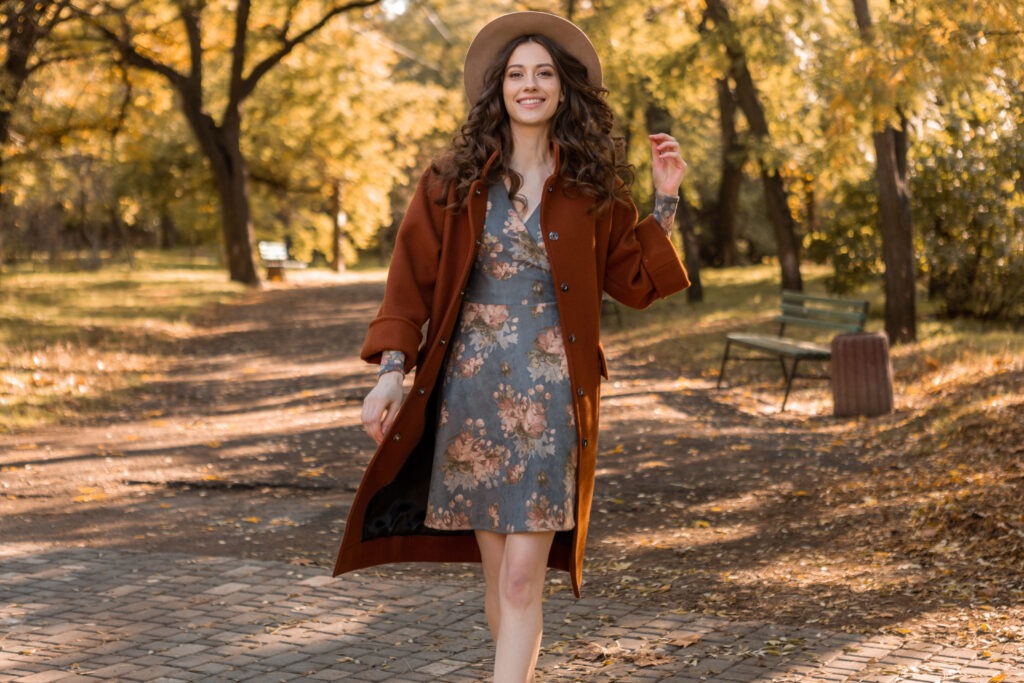
3. Go for Warm, Textured Tights
- Opaque black tights add warmth and make your floral dress more fall-appropriate.
- Try burgundy, mustard, or forest green tights for a pop of seasonal color.
- Ribbed or cable-knit tights add texture and visual interest.
4. Boots, Boots, and More Boots
- Ankle boots are a no-fail option for any fall outfit.
- Knee-high boots look stunning with midi floral dresses.
- Over-the-knee boots add drama and keep you extra warm.

Winter: Warm & Chic Styling
When temperatures drop, you don’t have to ditch your floral dresses. Instead, embrace tactical layering that keeps you warm and stylish.
1. Start with a Thermal or Turtleneck Base Layer
- A fitted turtleneck under a floral dress creates a sleek, fashion-forward look.
- Heat-retaining base layers keep you warm without adding bulk.
2. Add a Statement Coat
- A wool coat in a neutral color like camel or gray pairs effortlessly with floral prints.
- A puffer jacket ensures maximum warmth without sacrificing style.
- Faux fur coats add instant glam and a touch of vintage charm.
3. Opt for Thick Tights & Leggings
- Fleece-lined tights keep you warm without compromising style.
- Wear leggings under midi or maxi dresses for an extra layer of insulation.
- Try leather or suede leggings for a modern, edgy look.
4. Winter-Ready Footwear Choices
- Knee-high or over-the-knee boots provide both warmth and style.
- Combat boots give your floral dress a cool, grunge-inspired look.
- Fuzzy-lined ankle boots keep your feet toasty and cute.
5. Elevate your Look with Accessories
- A chunky knit scarf adds warmth and texture.
- Wool or cashmere berets elevate your winter outfit.
- Leather gloves keep your hands warm while adding a sleek, sophisticated touch.
FAQs
Can floral dresses be formal?
Absolutely, floral dresses can be formal if they have an elegant design, high-quality fabric, and a sophisticated color palette. Pairing them with stylish accessories and proper footwear such as closed toe pumps enhances their formality for events like weddings, cocktail parties, or corporate events.
What’s the best way to layer a summer floral dress for colder months?
Start with a thermal or turtleneck base, add thick tights, and throw on a sweater or blazer. Complete the look with knee-high boots and a warm coat.
Are there any layering mistakes I should avoid?
Yes! Avoid overly bulky layers that drown your shape. Instead of piling on too many thick layers, opt for fitted, insulating pieces under your dress and add structured outerwear.
How do I make floral dresses look more polished for work in colder months?
Layer with a tailored blazer, wear opaque tights, and choose heeled ankle boots or loafers. Stick to muted floral prints or darker colors for a more professional feel.
Conclusion: Floral Dresses for Every Season
Who says floral dresses are just for summer? With the right layering techniques, you can rock them all year long! From lightweight denim jackets in spring to cozy knitwear in fall and statement coats in winter, floral dresses can be a versatile staple in your wardrobe. So, embrace layering, mix textures, and have fun styling your floral dresses every season. Happy layering!
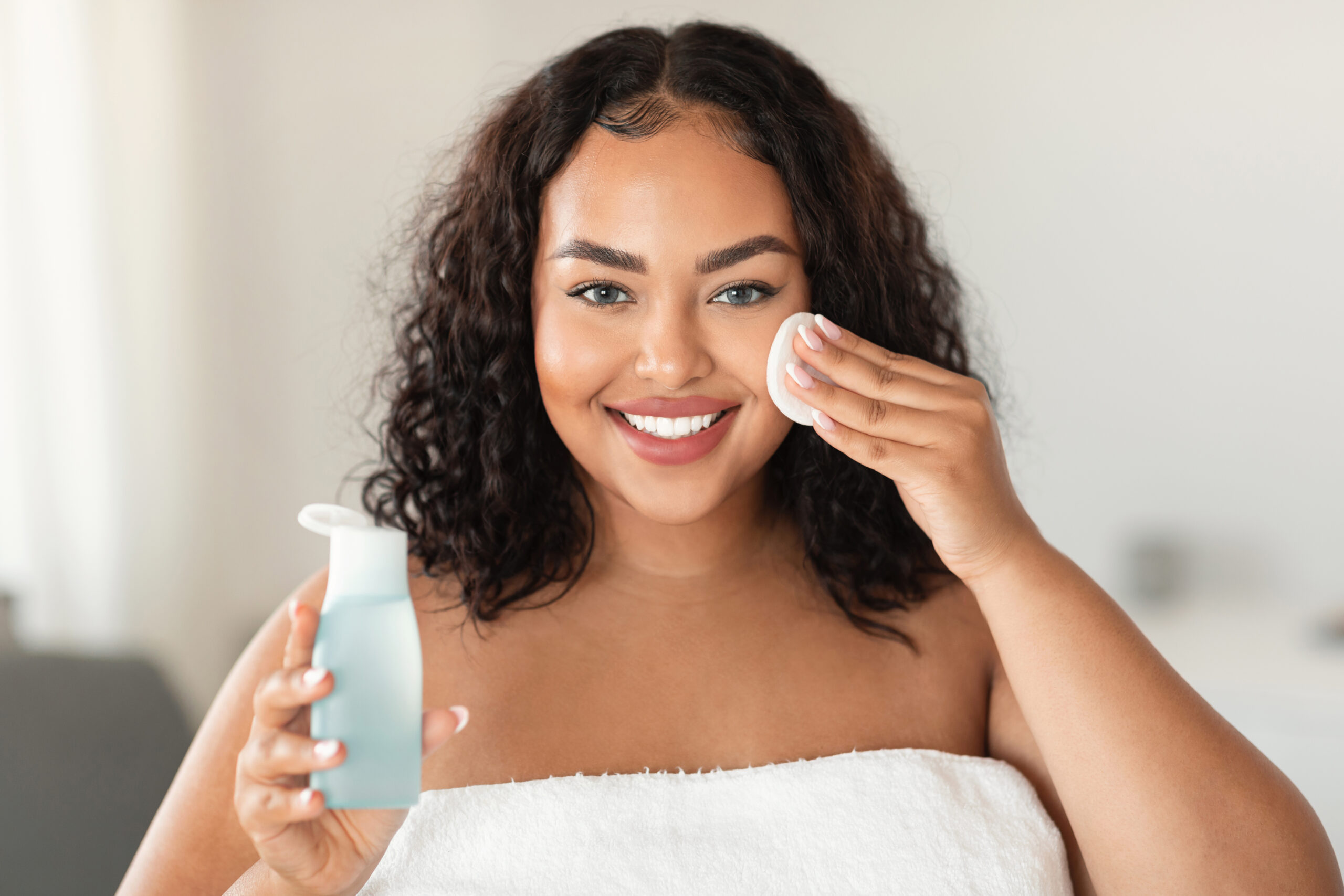
Skincare in Your 30s
Getting older is fun, isn’t it? We are at a point in our lives where we feel like we finally have things figured out. Then, we realize that our skin is starting to have a mind of its own. Gone are the days where three simple skincare products could do the trick. Suddenly, that dewy glow from your 20s needs a little more effort, and fine lines start to sneak up on you before you know it. If you’re wondering how to tweak your routine to keep your skin happy, you’ve come to the right place. Skincare in your 30s is all about balance: hydration, protection, and repair. This guide will walk you through how to maintain your youthful radiance in your 30s.
Why Does Skincare in Your 30s Matter?
Your 30s mark a pivotal shift in your skin’s behavior. Here’s why adjusting your routine is crucial:
- Collagen Production Drops – Your skin starts producing less collagen, leading to fine lines and less elasticity.
- Slower Cell Turnover – This can make your skin appear duller and more prone to dryness.
- Sun Damage Becomes Visible – If you weren’t diligent with SPF in your 20s, sun spots and hyperpigmentation might start showing up.
- Hormonal Changes – Ever heard of adult acne? Yep, it’s real. Hormones fluctuate in your 30s, sometimes leading to breakouts even if you have never had them before.
Building the Perfect Skincare Routine in Your 30s
1. Gentle Cleansing is Key
I used to think that the grittier the cleanser, that meant it was doing the job. Don’t judge me. Lol. I also happen to have very oily skin, so I thought that drying cleansers were best for me. This, however, was false. Harsh cleansers can leave your skin feeling tight. Opt for a gentle, hydrating cleanser that removes dirt without stripping moisture. The one that I use is Cerva Ve Facial Cleanser, specifically the one for dry skin. It leaves your skin feeling clean without the extra dryness. I also use Micellar water to remove makeup if I am wearing any that day.

2. Hydration, Hydration, Hydration!
If there’s one thing your skin craves in your 30s, it’s moisture. I started to realize very recently that my skin would start peeling if I got too dry which was my sign that I needed to upgrade my moisturizer. I started using Bubble and let me tell you, this was a game changer! The Charlotte Tilbury Magic Serum Crystal Elixir is also great for hydration and brightening your complexion.
Some Common Hydration Must-Haves:
- A lightweight hyaluronic acid serum
- A nourishing moisturizer with ceramides
- An occasional overnight hydrating mask
Shop: Bubble Duo Set | Charlotte Tilbury Magic Serum Elixir
3. Start Using Retinol (If You Haven’t Already)
Retinol is known to tackle early signs of aging by helping to boost collagen production, smooth fine lines, and even out skin tone.
Tips for Using Retinol:
- Start with a low concentration (0.25% or 0.5%) and work your way up.
- Apply only at night and always follow with a moisturizer.
- Use SPF during the day—retinol makes your skin more sensitive to the sun.
4. Sunscreen is Non-Negotiable for Skincare in Your 30s
I actually never liked sunscreen because it felt heavy on my skin but after some trial and error, I finally found a really good brand that doesn’t feel too thick. I now wear SPF every single day! Even when it’s cloudy which says a lot.
- SPF 30 or higher
- Broad-spectrum (protects against UVA & UVB rays)
- Lightweight formulas that don’t clog pores
5. Eye Creams: Worth It or Not?
This I feel is optional. However, the skin around your eyes is delicate and often the first area to show signs of aging. A well-formulated eye cream one can help with puffiness and dark circles on days when you didn’t get enough beauty rest.
Look for These Ingredients:
- Caffeine for de-puffing
- Peptides for firming
- Vitamin C for brightening
Extra Tips for Skincare in Your 30s
- Drink More Water – Hydration starts from within.
- Eat Antioxidant-Rich Foods – Berries, nuts, and green tea can help fight free radical damage.
- Manage Stress – Stress can trigger breakouts and dull skin.
- Don’t Sleep in Makeup – It clogs pores and accelerates aging.
- Get Enough Sleep – Beauty sleep is real!
FAQs About Skincare in Your 30s
1. Do I really need to change my skincare routine in my 30s?
Yes! Your skin’s needs evolve over time, and what worked in your 20s may not be enough now. Focusing on hydration, protection, and repair will help maintain youthful skin.
2. How often should I exfoliate?
2-3 times a week is usually ideal. Avoid harsh scrubs and opt for chemical exfoliants like glycolic acid or lactic acid for a gentler, more effective approach.
3. Is it too late to start using anti-aging products?
Not at all! It’s never too late to start taking care of your skin. The sooner you incorporate products like retinol and antioxidants, the better.
4. What’s the best budget-friendly skincare routine for your 30s?
- Cleanser: CeraVe Hydrating Cleanser
- Serum: The Ordinary Hyaluronic Acid
- Moisturizer: Neutrogena Hydro Boost Gel-Cream
- Sunscreen: La Roche-Posay Anthelios SPF 50
- Night Treatment: Olay Retinol 24 Night Cream
5. Should I see a dermatologist?
If you’re dealing with persistent issues like acne, pigmentation, or sensitivity, a dermatologist can help tailor a routine specific to your needs.
Conclusion: Love Your Skin in Your 30s
Your 30s don’t mean you have to say goodbye to glowing skin—it just means you need to be a little more intentional. With the right skincare routine, you can maintain youthful, healthy skin for years to come.
Remember, skincare isn’t about perfection; it’s about consistency. So, embrace your 30s with confidence, a solid skincare regimen, and of course, SPF!

Business Casual Outfit Ideas
In my opinion, “business casual” might be the most confusing dress code ever invented. Too formal and you look like you’re heading to a job interview; too casual and you might as well be heading to Target. Where’s the sweet spot? Right here in this guide! Whether you’re starting a new job, transitioning to an office with a more relaxed dress code, or simply looking to refresh your work wardrobe, I’ve got you covered with everything you need to know about business casual outfit ideas that actually work.
What Exactly Is “Business Casual”?
Business casual lives in that magical space between formal business attire and weekend wear. It is less formal than business professional but still passes as professional. Think of it as professional-looking clothes that give you room to show some personality while still being taken seriously. This can be different depending on your workplace, but there are some golden rules that apply almost everywhere.
The Business Casual Spectrum
Different industries have different ideas about what counts as business casual:
- Creative industries (advertising, design, media): More leeway for trendy pieces. Incorporates bold colors, patterns, and artistic expression.
- Finance and law: A more polished and professional look that is less formal than a suit.
- Tech companies: Often the most casual of all. Prioritizes comfort and functionality for a more relaxed atmosphere.
- Traditional corporations: Typically lean toward the more formal end of business casual. Neat and professional is key in this industry.
Business Casual Outfit Ideas – Essential Pieces
Foundation Pieces
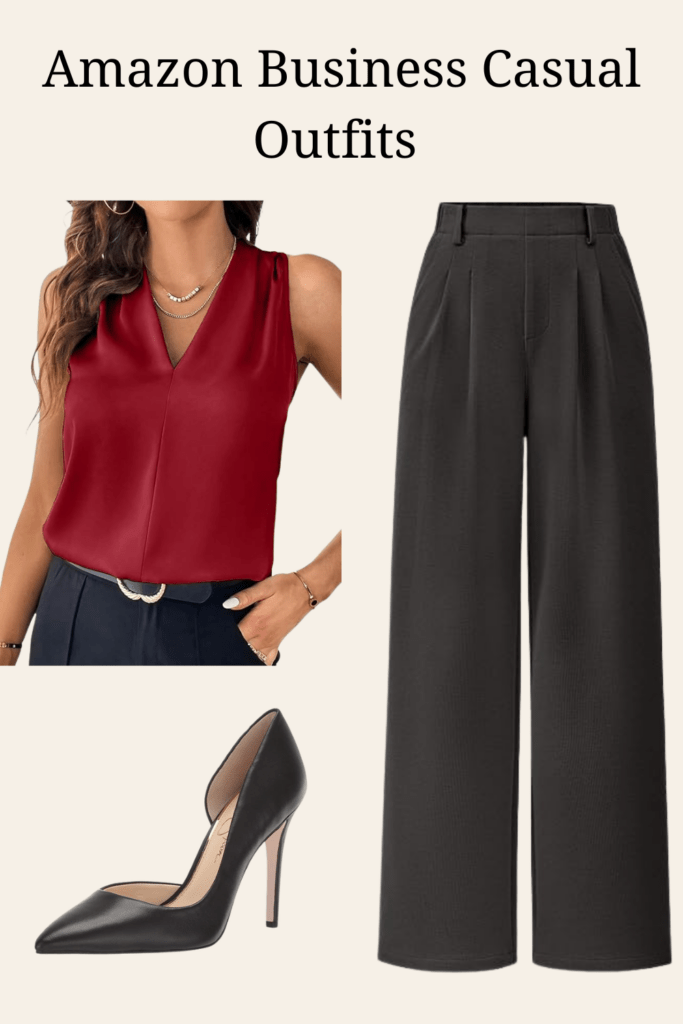
Shop the Look: Sleeveless Top | Jessica Simpson Pumps | Pants
The backbone of any business casual wardrobe includes:
- 2-3 pairs of well-fitting dress pants in neutral colors (black, navy, gray)
- A selection of blouses and tops that can be mixed and matched
- 1-2 blazers that can elevate any outfit instantly
- A few polished dresses (knee-length or longer)
- Comfortable yet professional footwear
Business Casual Outfit Ideas: Must-Have Tops
- Button-down shirts: Both solid colors and subtle patterns work great
- Blouses: Look for interesting details like subtle ruffles or unique necklines
- Knit tops: Fine-gauge sweaters and cardigans are perfect for layering
- Shells: These sleeveless tops work beautifully under blazers and cardigans
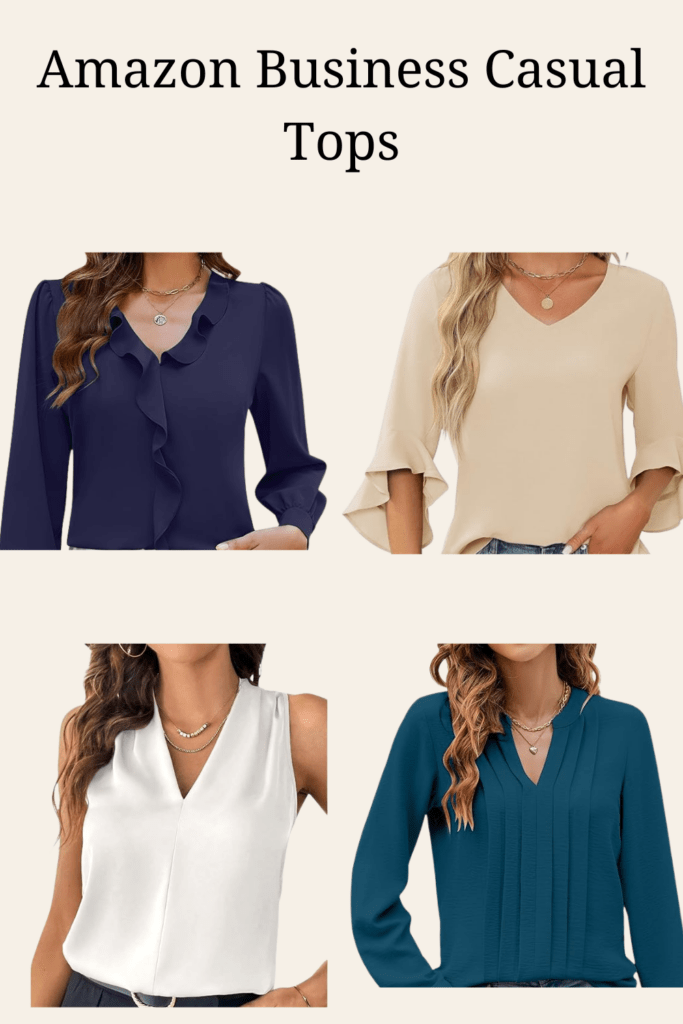
Shop: Top Left | Top Right | Bottom Left | Bottom Right
Pants and Skirts That Mean Business (But Not Too Much)
- Tailored pants: Straight leg, wide leg, or ankle-length styles all work
- Dark wash jeans: Only if your workplace allows them—make sure they’re pristine!
- Pencil skirts: A classic that works with almost everything
- A-line skirts: Flattering and comfortable for long days
The Power of a Great Dress
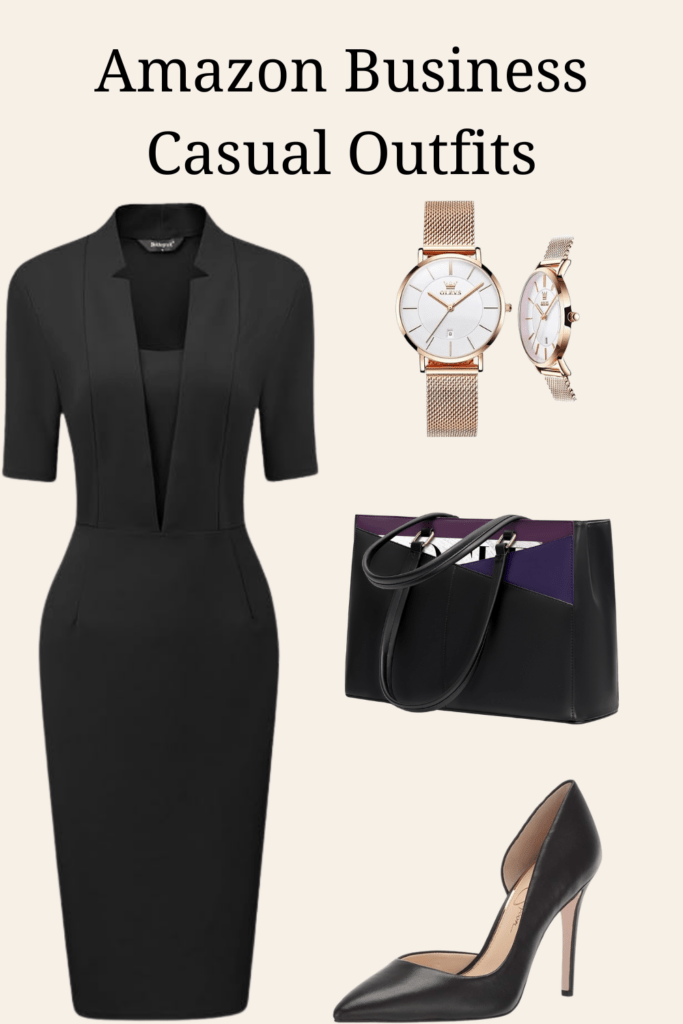
Shop the Look: Dress | Watch | Shoes | Laptop Bag
One-and-done outfits that always look put together:
- Sheath dresses: Classic, simple, and endlessly versatile
- Wrap dresses: Flattering on every body type
- Shirt dresses: Professional yet comfortable
Putting It All Together: Foolproof Outfit Formulas
- The Classic Combo: Tailored pants + blouse + cardigan or blazer
- The Easy Dress: Simple dress + structured jacket + flats or low heels
- The Mix Master: Pencil skirt + button-down or shell + cardigan
- The Modern Approach: Dark jeans + blouse + blazer (for jean-friendly offices)
Business Casual Outfit Ideas for Women
1. The Classic Blazer & Jeans Combo
When in doubt, throw on a blazer! Pair it with:
- A plain or printed blouse
- Dark-wash skinny or straight-leg jeans
- Loafers, ankle boots, or sleek sneakers
This combo is easy, stylish, and works for almost any office setting.
2. Chic & Comfortable Dresses
Dresses make getting ready so much easier. Opt for:
- A wrap dress for a universally flattering fit
- A midi dress with fun prints or subtle patterns
- A sweater dress paired with tights and ankle boots in colder months
3. The Effortless Sweater & Trousers Look

Shop the Look: Floral Print Jacket | Pants | Insulated Lunch Bag | Shoes
A cozy yet polished outfit idea? A lightweight sweater tucked into structured trousers.
- Choose neutral or jewel tones for a classic look
- Add pointed-toe flats or low heels for an elegant touch
- Layer with a longline coat or blazer for extra polish
4. Blouse & Ankle Pants Perfection
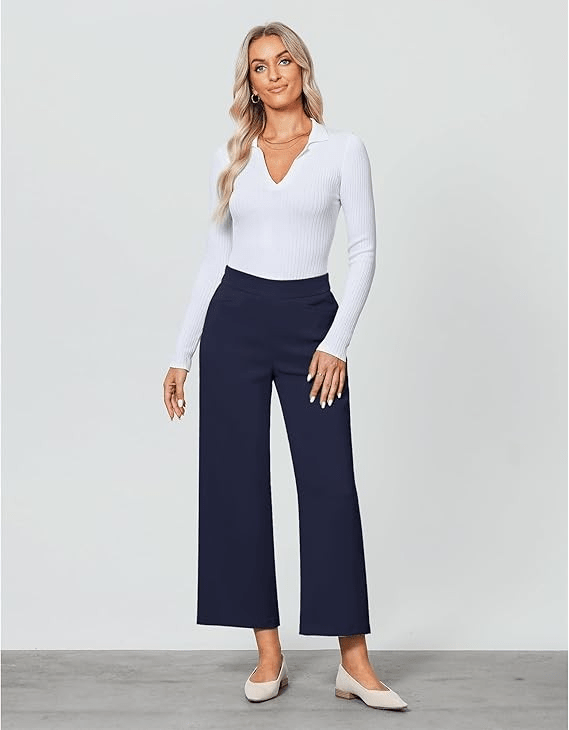
Ankle-length pants are a business casual must-have. Pair them with:
- A flowy blouse or button-down shirt
- Statement earrings for a touch of personality
- Stylish loafers or ballet flats
5. The Power Jumpsuit
Jumpsuits are an underrated business casual staple. Look for:
- Structured fabrics that hold their shape
- Neutral tones or subtle patterns
- A belted waist for a polished silhouette
Business Casual Outfit Ideas – Accessorizing
Accessories can elevate your business casual game without much effort:
- Scarves: Add color and interest to simple outfits
- Watches: Keep it understated but still stylish
- Belts: Should match or complement your shoes
- Jewelry: Simple pieces that don’t make noise or get in the way
- Bags: Structured totes or messenger bags that can fit your essentials
Business Casual Outfit Ideas – Seasonal Switches
Summer Business Casual
- Lighter fabrics like cotton and linen
- Short-sleeved options that still look professional
- Lighter colors that reflect heat
Winter Business Casual
- Layering pieces that add warmth without bulk
- Wool and cashmere for comfort and style
- Boots that can handle weather while still looking polished
FAQs About Business Casual Outfits
Q: Can I wear jeans for business casual? It depends on your workplace. If jeans are allowed, choose dark wash styles without rips or distressing, and pair them with more polished pieces like blazers.
Q: Are open-toed shoes appropriate for business casual? In most cases, peep-toes or simple sandals are fine in warmer months, but flip-flops are still a no-go. Check your company’s specific dress code.
Q: How can I make my business casual wardrobe more sustainable? Focus on quality pieces that last, choose natural fibers when possible, and build a capsule wardrobe of items that mix and match easily.
Q: How casual is too casual for business casual? Avoid anything you’d wear to the gym, beach, or club. If you’re questioning whether something is appropriate, it probably isn’t.
Q: Do I need to dress business casual for virtual meetings? At least from the waist up! Your top half should still look professional, even if you’re wearing pajama pants off-camera.
Conclusion
Business casual doesn’t have to be confusing or boring. By investing in versatile, quality pieces that you can mix and match, you’ll build a wardrobe that works as hard as you do. The key is finding the right balance between professional and comfortable, with a touch of your personal style thrown in.
Remember, confidence is the best accessory for any outfit. When you feel good in what you’re wearing, it shows in how you carry yourself. So build that business casual wardrobe with pieces you love, and you’ll never have to stress about the dress code again!

Women’s Essentials Clothing
Hey friends! So, I have worn uniforms for the majority of my life. In fact, I did so from elementary school all the way up until high school and even while working my first few retail jobs. Uniforms are easy! I realized that most people, although dressed the same, always found ways to make their uniforms unique in some way. Whether it was adding colors, flashy jewelry, or unique shoes, mostly everyone found a way to make wearing a uniform less boring! Having a collection of essential clothing pieces is almost the same as having a uniform. You then need to find ways to style your uniform in a way that is unique to you! Having basic items that work well together for just about anything you have in your closet will make getting dressed so much easier. Trust me! In this guide, we will talk about the importance of women’s clothing essentials and how you can update what you already have in your closet by adding just a few statement pieces.
The 5 Wardrobe Categories in Women’s Essentials Clothing
Wardrobe can be broken down into five categories: athletic wear, casual, polished casual, loungewear, and dressy. These categories are based on your unique lifestyle. If you go into your closet, you will find that you have clothing that falls into one or two categories, this is because you subconsciously buy clothing to fit your lifestyle without even realizing it. Cool right?! High quality basics will help you to elevate what you already have so that you don’t go buying a bunch of new clothing that you don’t need.
Disclosure: Some of the links in this post are ‘affiliate links’. This means if you click on the link and purchase the item, I will receive an affiliate commission.
The Basics: Key Pieces
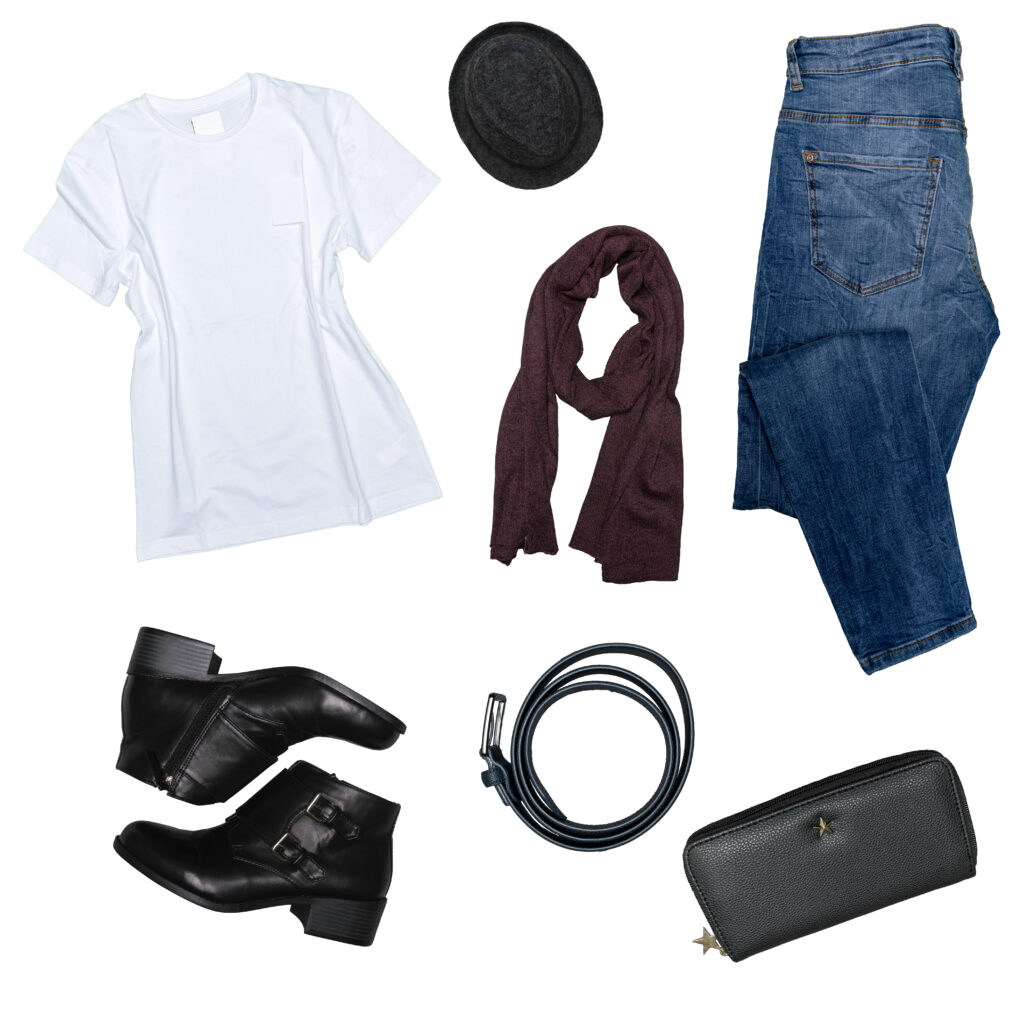
A Great White T-shirt
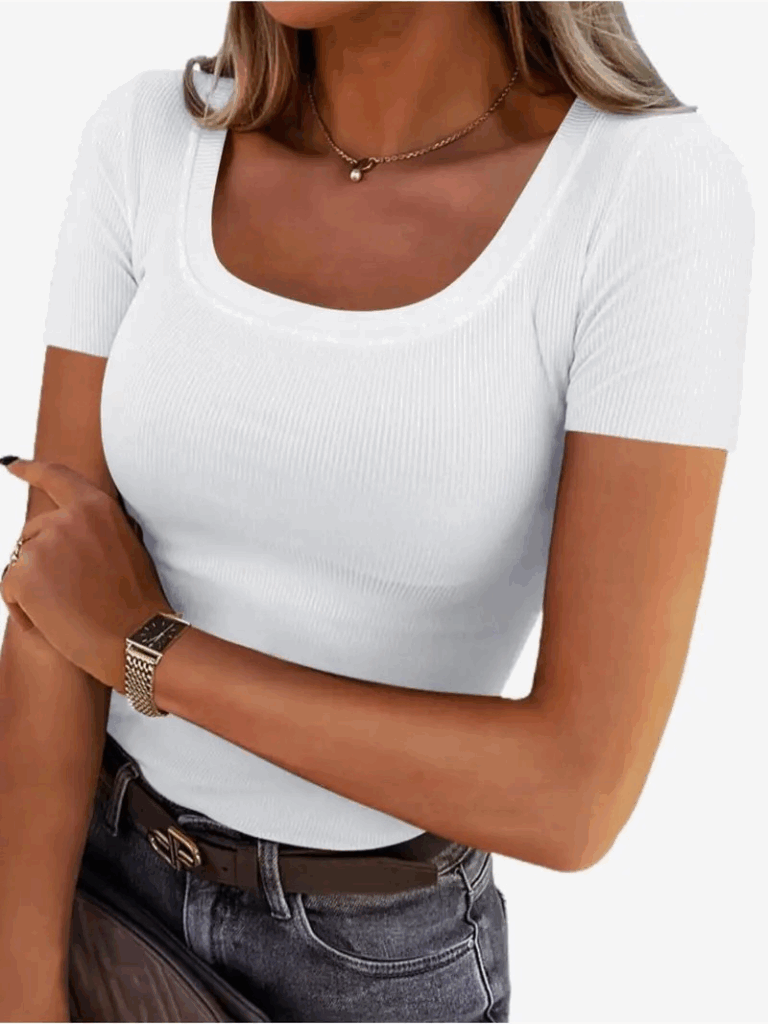
This may sound very basic, but do you have a really nice high quality white shirt? You may never think to buy one because of how boring it is but trust me, you need one. It goes with everything from jeans to fancy skirts and can be dressed up or down. When looking for one, check that:
- The fabric feels nice (100% cotton or cotton with a bit of stretch works well)
- It’s not see-through
- The neckline flatters you (round, V-neck, or scoop)
- It fits comfortably—not too tight or too loose
A Simple Button-Up Shirt
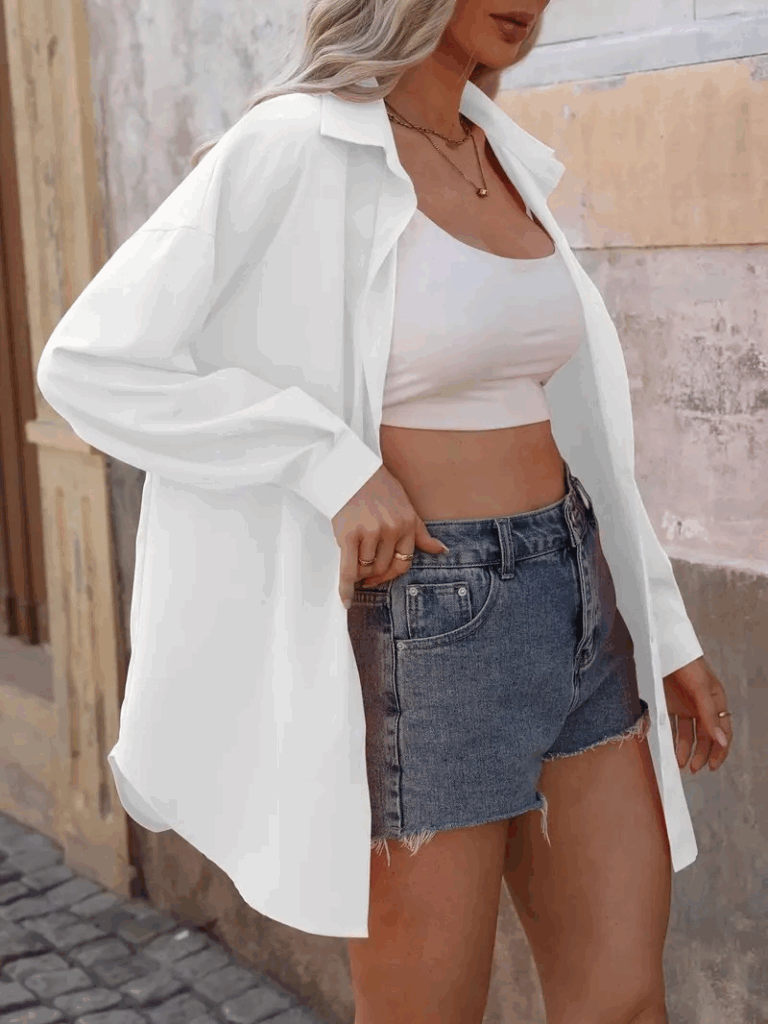
Remember how we talked about clothing categories? A button-up can be worn within every one of these categories to instantly upgrade your look. This look shows the world that you have got it together! White or light blue are the best colors to start off with because they are versatile and complement other colors. A light blue button up can be paired with black, brown, navy, and olive just to name a few. When shopping for a good button-up shirt, look for:
- Cotton that doesn’t wrinkle too easily
- A simple design without fancy details
- A fit that doesn’t gap at the chest
- A length that looks good tucked in or left out
Women’s Essentials Clothing: Bottoms
Jeans That Fit Perfectly
Finding jeans that fit just right can change your whole wardrobe. Dark blue, straight-leg jeans that sit at your natural waist work the best. When picking jeans:
- Focus on comfort and fit rather than trendy details
- Choose a dark or medium blue without too much distressing
- Make sure the length works with both flat shoes and heels
- Look for a small amount of stretch for comfort
Nice Dress Pants
A good pair of dress pants can be worn with just about every clothing category and can be dressed up or down. Black, navy, or gray are the most versatile and easiest to style. Good dress pants should have:
- Fabric that hangs nicely
- A simple design without too many pockets or details
- A comfortable fit at the waist and hips
- A length that just touches the top of your shoes
A Go-To Skirt
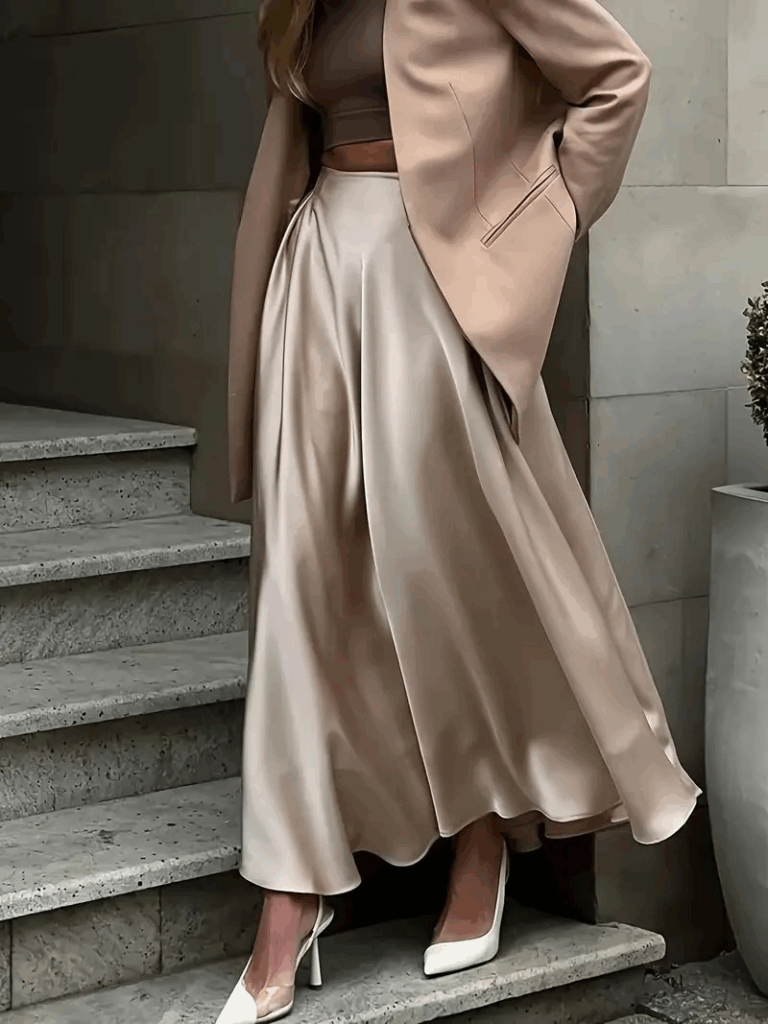
Skirts go with just about anything because of their simple design. Whether you like A-line, straight, or pleated styles, a knee-length skirt in a neutral color gives you many outfit options. Look for:
- Good fabric that isn’t too thin or stiff
- A classic shape
- A comfortable waistband
- A lining so it’s not see-through
Layering Pieces: For Year-Round Wear
A Simple Cardigan

A lightweight cardigan in wool or cotton blend is perfect for layering in any season. The best thing about cardigans is the fact that they come in a variety of styles. Think classic, fitted, oversized, or relaxed when looking for the best cardigan based on your specific style. Consider:
- A simple design without extra decorations
- A good fit in the shoulders and arms
- Buttons or a zipper that lies flat
- A length that works with both pants and skirts
A Well-Fitted Jacket

A good blazer or jacket instantly makes any outfit look more put-together. A single-breasted style in black, navy, or beige goes with almost everything. Key things to look for:
- Good fabric that holds its shape
- Clean, simple design
- Proper fit in the shoulders (most important part)
- Sleeves that end at your wrist
A Light Sweater
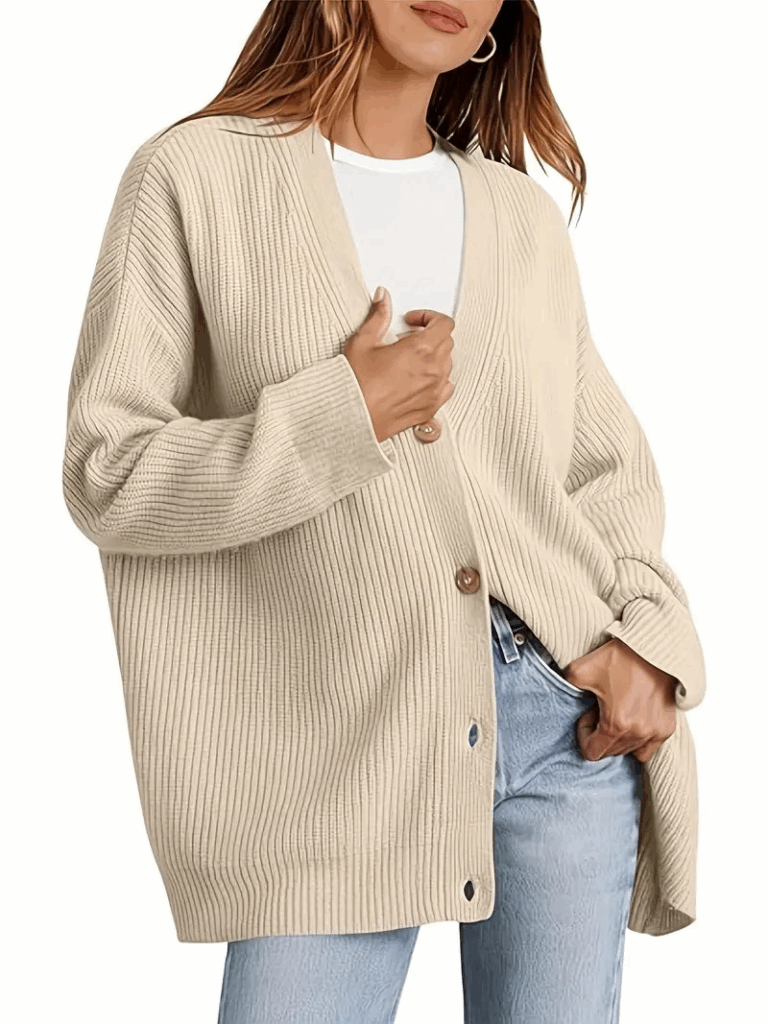
A lightweight sweater in a neutral color works on its own or layered with other pieces. Some lightweight sweater styles are cardigans, pullovers, and crewnecks. When picking one:
- Choose natural materials like wool, cashmere, or cotton
- Look for a simple design
- Make sure it fits well without being too tight or baggy
- Consider a crew neck or V-neck for most versatility
Women’s Essentials Clothing: Outerwear
A Classic Trench Coat
I love a good quality trench coat! Having one can instantly upgrade your look during the colder months. Look for a beige or navy color trench coat as these colors look stylish year after year and never go out of style. A good trench should have:
- Water-resistant fabric
- Traditional details like shoulder flaps
- A belt to define your waist
- Length hitting around the knee
A Warm Winter Coat
For cold weather, a good wool coat in a neutral color keeps you warm and looking put-together. Look for:
- High wool content for warmth
- Clean, simple lines
- Room for layers underneath
- Length at mid-thigh or longer
Accessories: The Final Touches
I was never a big fan of accessories until I realized how much of a difference they can make. Literally adding a belt, necklace, and some sunglasses to your outfit can make you look rich! A few key accessories to add to your wardrobe are:
- A good leather belt in black or brown
- Versatile shoes (flats, ankle boots, and heels)
- A sturdy handbag for everyday use
- Simple jewelry that goes with everything
- A nice pair of sunglasses that fit your face
FAQ: Women’s Essentials Clothing
How many essential pieces should I have? Around 25-35 total items (including shoes and coats) is a good number for a complete basic wardrobe.
How can I tell if clothing is good quality? Check the stitching (it should be even), fabric (natural fibers usually last longer), and details like lined skirts and reinforced buttonholes.
Can I find good basics at affordable prices? Yes! Many regular stores have good quality basics. Look for their “premium” collections which often have better materials.
How do I use the same clothes in different seasons? Layering is the key. The same white shirt works with shorts in summer, with a cardigan in fall, or under a blazer with wool pants in winter.
How often should I replace my basic clothes? With good care, quality basics should last 3-5 years or longer. Replace items when they show visible wear, lose their shape, or no longer fit well.
Conclusion
Building a wardrobe around essential clothing makes getting dressed easier while helping you look your best every day. These timeless pieces work season after season, letting you express your personal style through accessories and a few seasonal items. By choosing quality basics that fit well and match your lifestyle, you create a versatile collection that works harder for you with fewer total pieces. The result is not just a more organized closet, but a smarter approach to fashion that values lasting style over passing trends. Remember that your ideal wardrobe should reflect who you are and work for your real life—creating the perfect balance between style, practicality, and personal expression.

Gift Ideas for Men in Their 30s
Why Comfort Reigns Supreme for Men in Their 30s
Shopping for a guy in his 30s can be a little tricky because he is no longer into the cheap, gimmicky gifts he liked in his 20s, and he probably has most of the basic stuff he needs. What does he truly appreciate now? Comfort! At this stage of life, men want gifts that make their daily routine smoother, their downtime cozier, and their overall experience of life just a bit more enjoyable. If you’re looking for gift ideas for men in their 30s, think beyond the usual gadgets and trendy items. Instead, focus on gifts that can make their lives easier.
The goal is to enhance his comfort, whether at home, at work, or on the go. The best part about these types of gifts is the fact that they are affordable. Let’s dive into some of the best cozy, practical, and thoughtful gifts that he’ll actually appreciate!
An Ottoman
This is a gift that he will actually use every day and not just shove it aside in the dresser somewhere. I gifted my husband an ottoman for Christmas last year along with some other cool techy stuff. He loved the ottoman best.
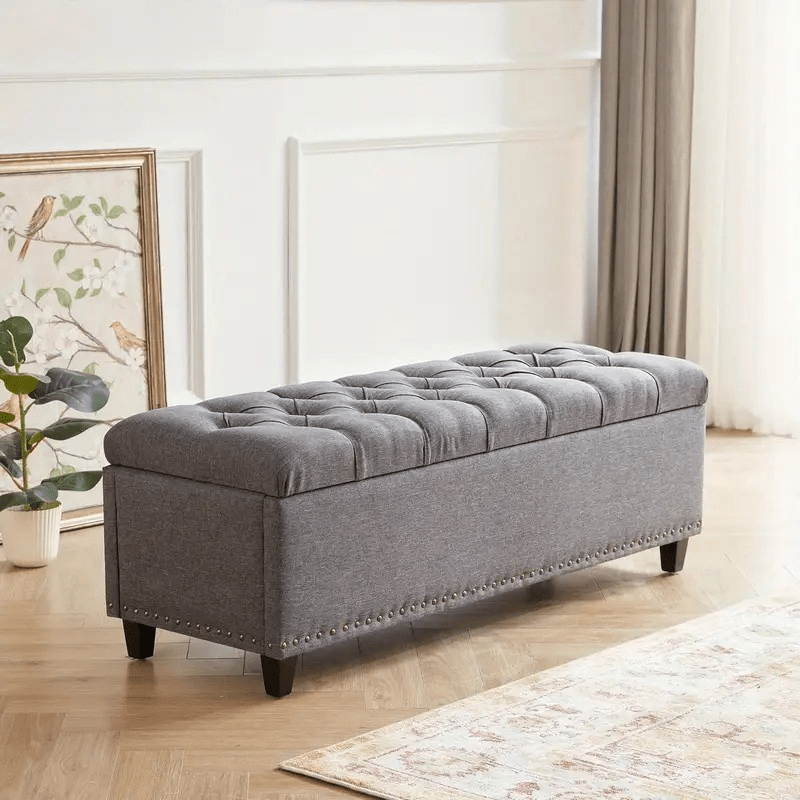
Personalized 50 States Photo Map
Customized gifts are a great way to show that you put the time and energy into picking out a well thought out gift. I gifted my husband a map with all 50 states and placeholders for pictures like the one below. Whenever we go on vacation, we take a picture and put it in the slots. As you can see, we have many more empty spaces than we do filled ones, but I am optimistic that we will get there. There is a map maker app that you install on your phone once you receive it, you then insert the pictures from your phone on to the app in the appropriate slot (the state you visited) and the company will mail the pictures to you so you can add to your map!
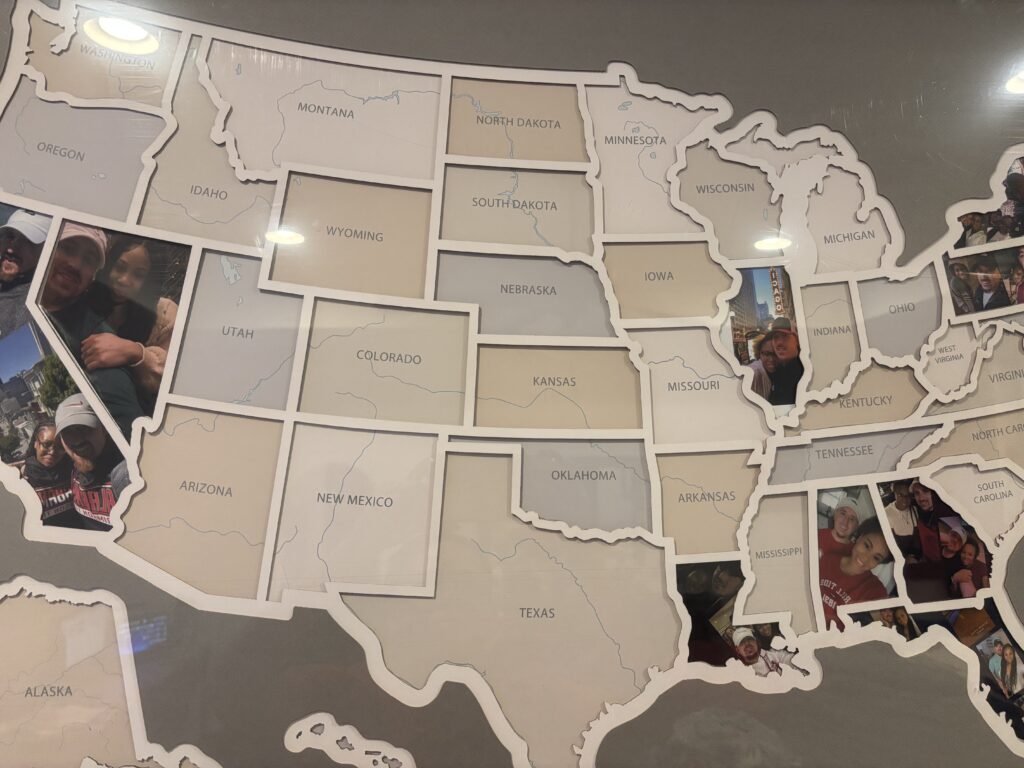
A Posture Corrector
Have you noticed that your other half slouches? Don’t worry, we all do! Lol A posture corrector is a perfect gift for men in their 30s. It relieves back, neck, shoulder and clavicle pain making standing for longer periods of time much easier.
Premium Loungewear
Men in their 30s do not like to admit it, but they love being comfortable in some ultra cozy sweatpants. Chances are he already has a few, buy him some more. Trust me. He will light up once he sees this gift!

A Stone Drying Mat for the Kitchen
This gift is both practical and enjoyable for him. If you’re getting it for your husband, you’ll also benefit from a neater countertop. The drying mat featured above uses fast-dry technology to help dishes dry more quickly.
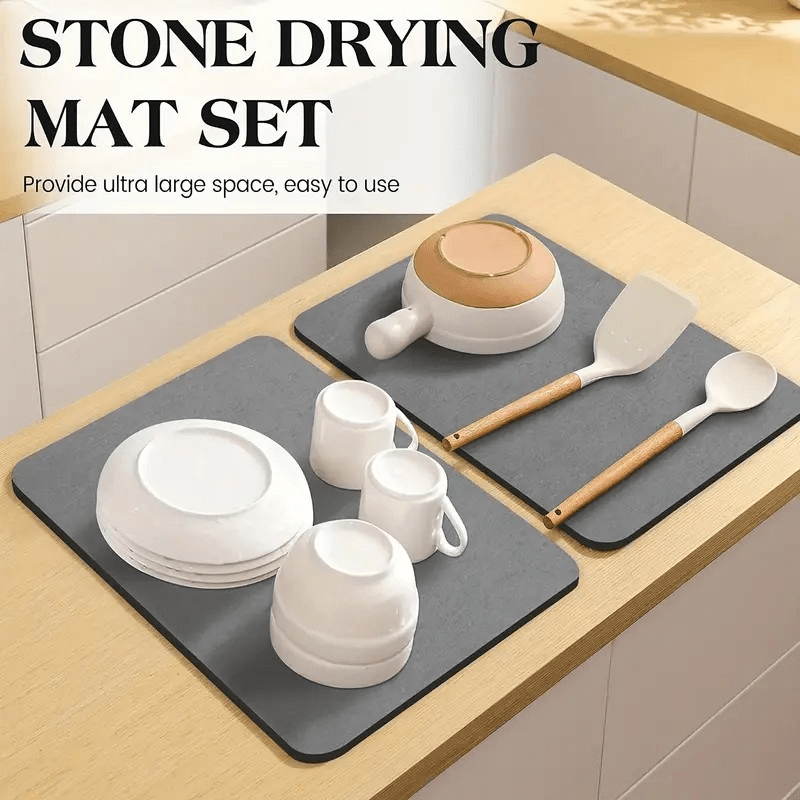
TENS Unit Muscle Stimulator
The sensation you get with this device is like no other so it will take some getting used to. A TENS muscle massager is perfect for relieving pain and is much more effective than the average massager. This is the perfect gift for men in their 30s that workout or live an active lifestyle!
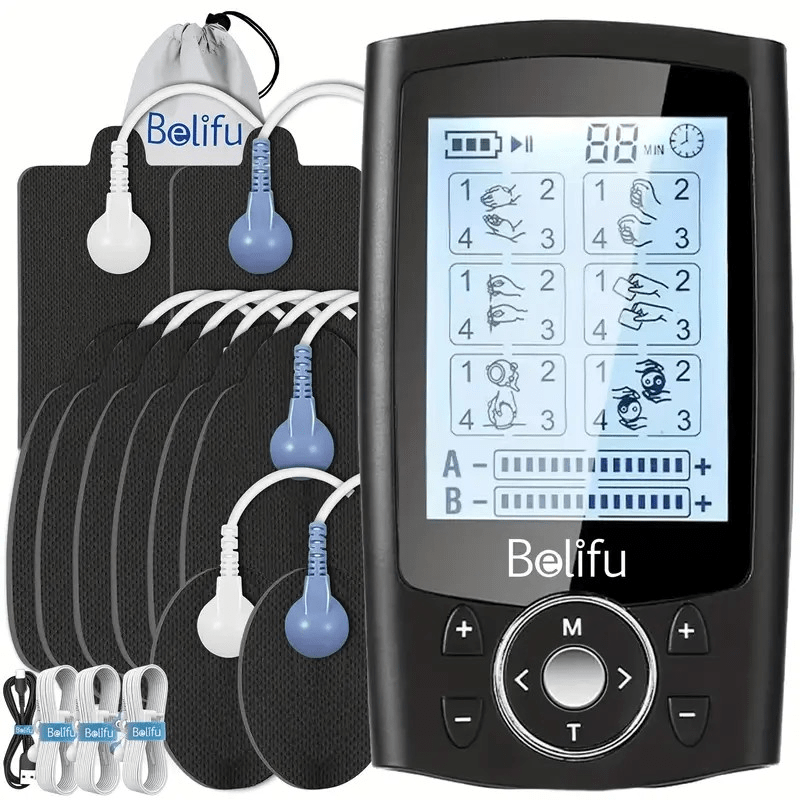
Scalp Massager
This is an awesome gift, and it is super affordable so you can pair it with other gifts or add to a gift basket. Scalp massagers relieve tension, boosts circulation, and promotes healthier hair growth—all while providing a soothing, spa-like sensation for men right at home!
An Adjustable TV Tray Table
Make eating on the couch much easier for him with a TV Tray table. He can place it on the edge of his sofa or bed so he can work or watch a movie without straining his neck or back. This gift will be very much appreciated.
Dart Board
We love our dartboard! This gift is perfect for bonding with your significant other. This is a fun activity for the entire family to enjoy, and he will love it!
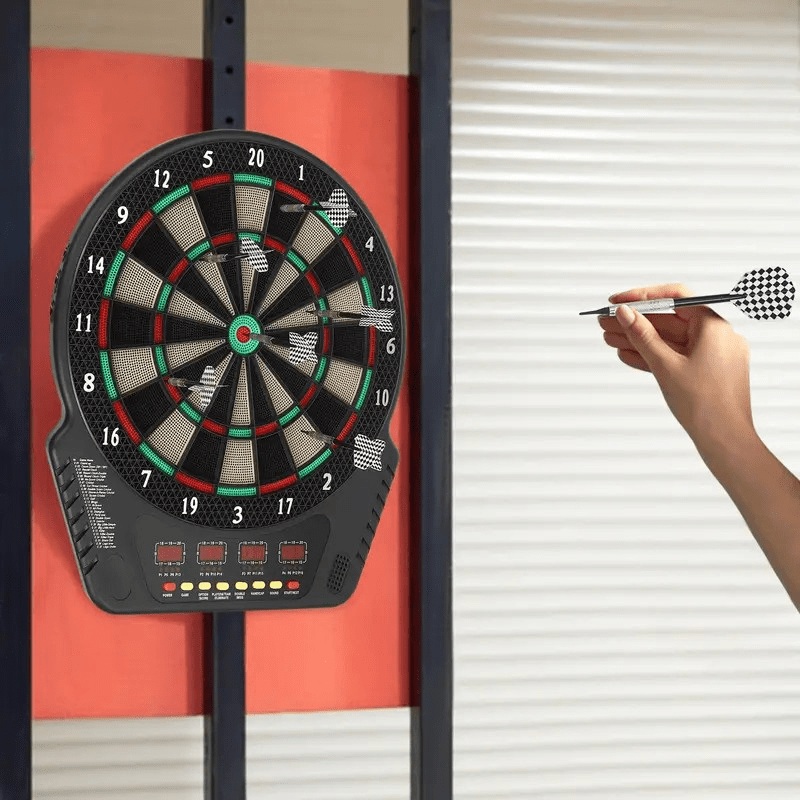
Aromatherapy Diffuser
Pair this gift with essential oils like lavender or eucalyptus for a relaxing home environment that he will enjoy.
Nesting Grill Basket
This gift is perfect for men in their 30s who enjoy grilling. This can be used to whip up some fresh vegetables or small seafood like shift and chunks of meat. He will love this gift because it is something that he will actually use, and it looks really cool.
A Tumbler
If you run out of gift ideas, you can never go wrong with a tumbler. I have never received a tumbler as a gift and thought to myself, “I don’t need a tumbler.” Everyone loves a good tumbler. Bonus points if you get him a heated smart mug.

Noise-Canceling Headphones
JBL is my favorite brand. It’s super affordable, and the sound quality is great for the price. My favorite thing about them is that the Bluetooth doesn’t take forever to connect. Somehow it just knows which device you are wanting to connect to and goes through immediately. They turn off automatically when you’re not using them, so they last for days without needing to be charged. If you want something fancier, go for Bose or Sony headphones.
Smart Lighting System
Allows him to adjust lighting for a perfect cozy atmosphere at home.
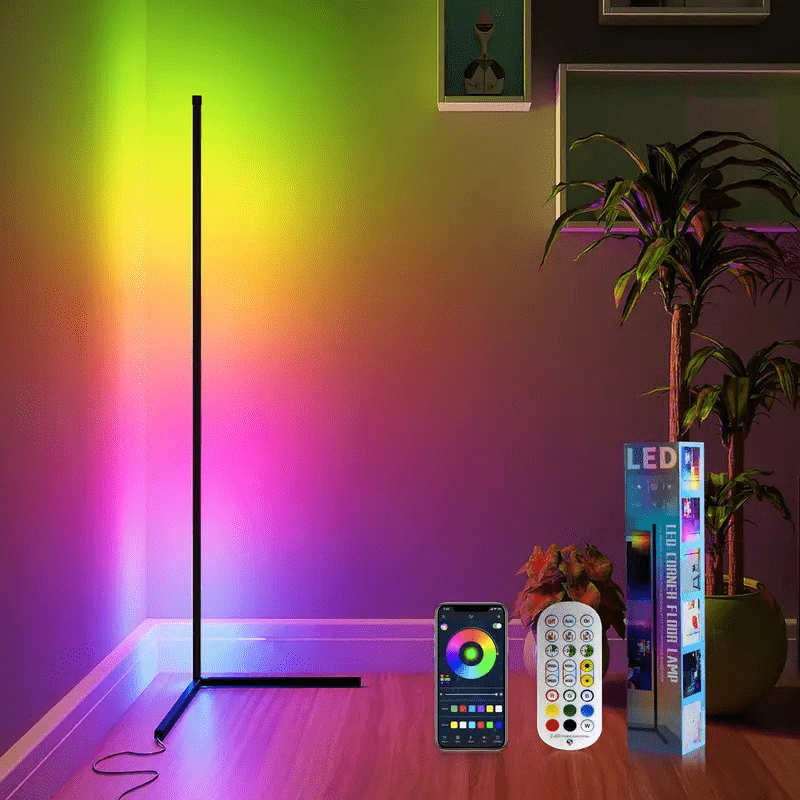
Heated Blanket
A heated blanket is great for improving sleep quality unless you overheat throughout the night like I do.
A Hobby or Experience Gift

Sometimes, the best gift isn’t a thing—it’s an experience. Since many of us aren’t able to hop on a private jet to visit the Grand Canyon, settle for something local. Find a comedy show, concert, or sport game that he likes and get him tickets to those and he will love it!
FAQs About Gift Ideas for Men in Their 30s
1. What’s a great budget-friendly gift for a man in his 30s?
A premium coffee sampler, a high-quality beanie, or a leather key organizer are affordable yet thoughtful choices.
2. What should I avoid when buying a gift?
Avoid gimmicky, impractical, or overly trendy items. Men in their 30s appreciate quality and usefulness over novelty.
3. What’s a last-minute gift idea that still feels thoughtful?
An e-gift card for his favorite streaming service, a luxury grooming kit, or an audiobook subscription are excellent last-minute picks.
4. Are experience gifts better than physical gifts?
It depends! Some men love tangible items, while others appreciate memorable experiences like a concert or a weekend getaway.
5. What’s the best all-around gift for comfort?
A weighted blanket or an ergonomic chair—both provide relaxation and improve well-being.
Conclusion: Comfort Wins Every Time
When choosing gift ideas for men in their 30s, always prioritize comfort. Whether it’s a cozy hoodie, a stress-relieving massage gun, or an unforgettable experience, the best gifts enhance his daily life.
Instead of buying something flashy or trendy, go for something practical, high-quality, and comfortable—he’ll appreciate it more than you know!
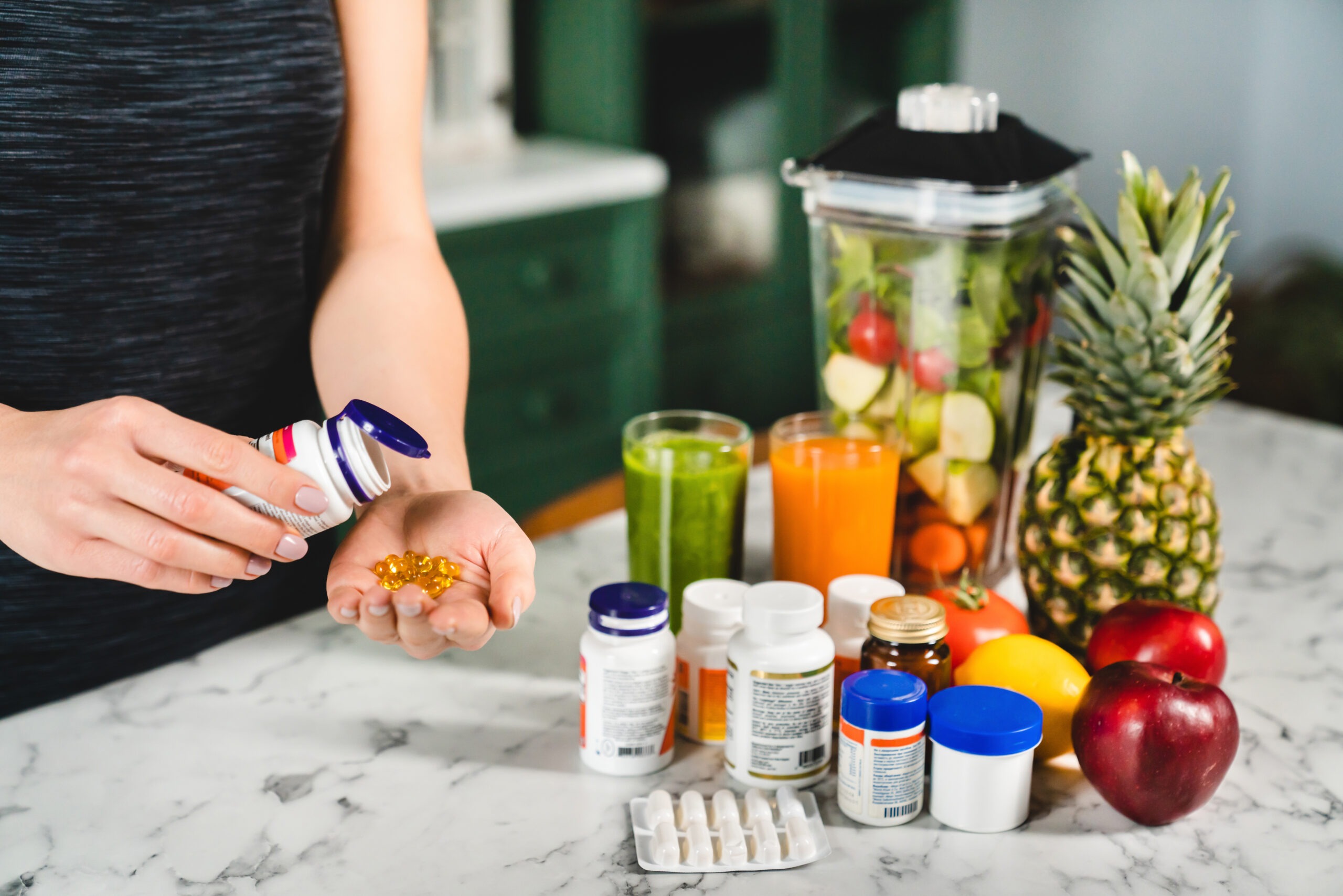
Best Vitamins for Women in Their 30s
Your 30s are a time of transformation—both personally and physically. From career growth to family responsibilities, life gets busier, and your body’s nutritional needs start to shift. You may notice changes in energy levels, metabolism, and even skin elasticity. That’s where vitamins step in! Getting the right nutrients can help you feel your best, prevent deficiencies, and support long-term wellness. But with so many supplements out there, how do you know which ones truly make a difference? I have tried my share of supplements and realize that some work better than others. In this guide, I will break down the best vitamins for women in their 30s to help you stay strong, energized, and glowing from the inside out.
Why Do Women in Their 30s Need Specific Vitamins?
Your 20s might have been all about getting by on coffee and fast food, but your 30s? That’s when your body starts demanding more. Here’s why:
- Metabolism slows down – Making weight management trickier.
- Hormonal changes begin – Prepping for pregnancy or just balancing cycles.
- Bone density starts to decline – Time to think about long-term bone health.
- Stress and fatigue hit harder – Juggling work, family, and life takes a toll.
To stay ahead of these changes, it’s crucial to fuel your body with the right nutrients. So, let’s dive into the best vitamins for women in their 30s and how they support your health.
Disclaimer: Before beginning any supplements, consult your healthcare provider. Additionally, getting bloodwork done can help identify any vitamin deficiencies you may have.
Best Vitamins for Women in Their 30s
Vitamin D – The Sunshine Vitamin
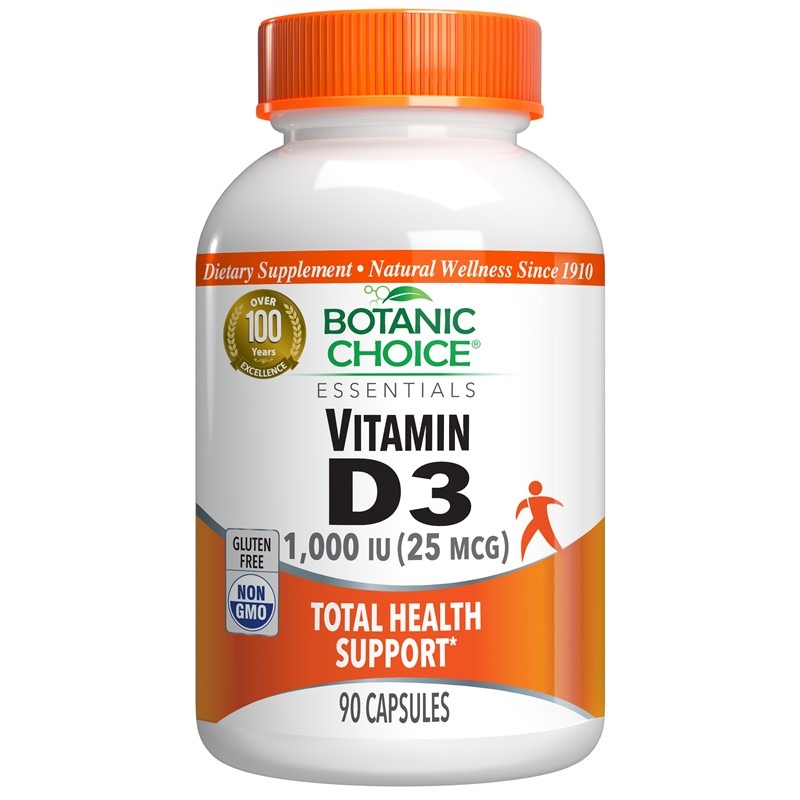
You might think of Vitamin D as just a bone booster, but it does so much more! It supports immune function, mood regulation, and even hormone balance. Studies show that vitamin D deficiency can lead to osteoporosis, a metabolic disorder that is associated with bone mass reduction and changes in bone turnover. Another study highlights the importance of vitamin D when it comes to women’s reproductive health warning that low vitamin D is associated with impaired fertility.
Why it’s essential:
- Enhances calcium absorption for strong bones
- Helps regulate mood and reduce stress
- Strengthens the immune system
Best sources:
- Sunlight exposure
- Fatty fish (salmon, mackerel)
- Fortified dairy products
Tip: If you spend most of your day indoors, consider a Vitamin D3 supplement.
B Vitamins – The Energy Boosters
One thing that I noticed in my 30s was increased exhaustion especially by midday. According to an article by Mito Health, as we get older, our ability to absorb vitamin B12 from food sources decline. B vitamins, especially B6 and B12 play a key role in energy production and brain function.
Why they’re essential:
- Keeps your metabolism running efficiently
- Supports brain health and mental clarity
- Helps with red blood cell production
Best sources:
- Whole grains
- Leafy greens
- Lean meats and eggs
Pro tip: If you’re vegetarian or vegan, a B12 supplement is a must since it’s mostly found in animal products.
Disclaimer: This post contains affiliate links, which means that if you click on the link and make a purchase, I may receive a small commission.
Iron – For Strength and Stamina

Low iron levels have become more common with women in their 30’s especially those who suffer from heavy menstrual cycles. Low iron can lead to fatigue, dizziness, and weakened immunity.
Why it’s essential:
- Prevents anemia and keeps energy levels up
- Supports healthy oxygen flow in the blood
- Strengthens the immune system
Best sources:
- Red meat
- Spinach and lentils
- Fortified cereals
Tip: Pair iron-rich foods with Vitamin C (like citrus fruits) to improve absorption.
Calcium – Protecting Your Bones for the Future
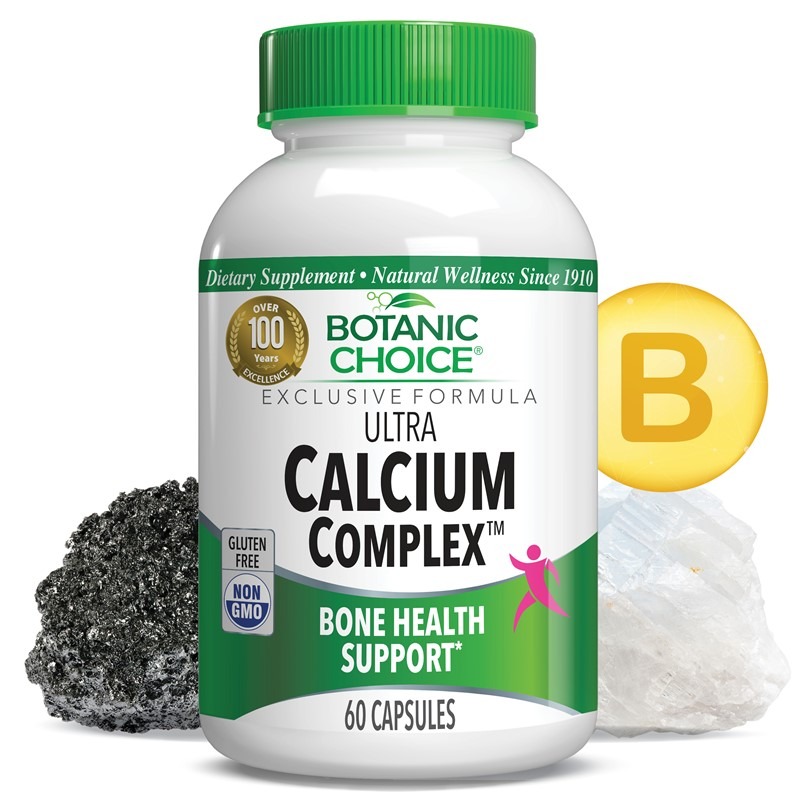
Studies show that once you hit your 30, your bones have reached their peak mass. With that being said it is important to ensure that your bones remain healthy as you get older.
Why calcium is essential:
- Reduces the risk of osteoporosis later in life
- Supports muscle function and nerve signaling
- Helps maintain strong teeth
- Helps avoid Premenstrual Syndrome
Best sources:
- Dairy products (milk, cheese, yogurt)
- Leafy greens (kale, bok choy)
- Almonds
Pro Tip: Combine calcium with Vitamin D for better absorption.
Omega-3 Fatty Acids – For Brain and Heart Health
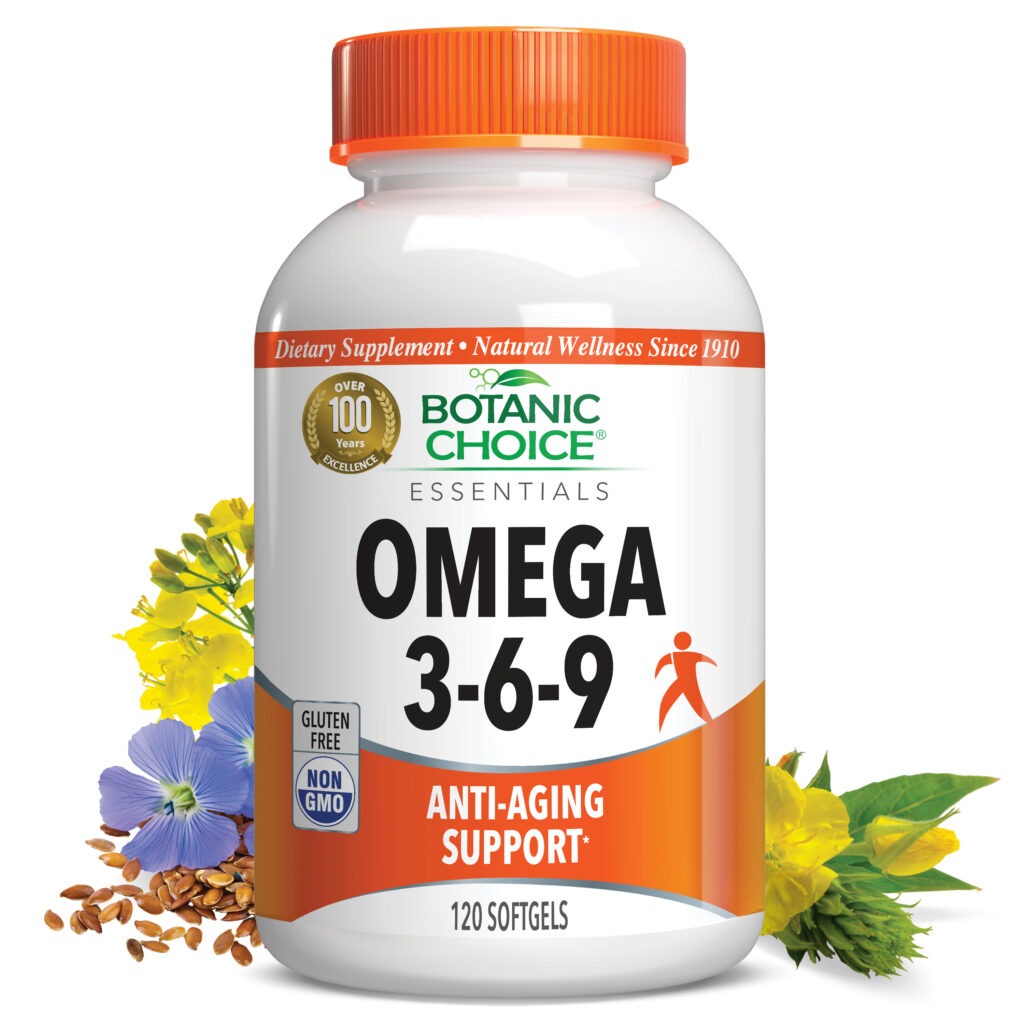
Omega-3s are vital for heart health, brain function, and reducing inflammation.
Why they’re essential:
- Support brain health and memory
- Reduce inflammation and joint pain
- Keep skin glowing and hydrated
Best sources:
- Fatty fish (salmon, tuna)
- Chia seeds and flaxseeds
- Walnuts
Tip: If you don’t eat fish, try an algae-based Omega-3 supplement.
Magnesium – The Relaxation Mineral

This is by far my favorite supplement for women in their 30s. Between work stress and busy schedules, magnesium can be a game-changer for relaxation and sleep.
Why it’s essential:
- Helps reduce stress and anxiety
- Aids in muscle recovery and relaxation
- Supports better sleep quality
Best sources:
- Nuts and seeds (almonds, pumpkin seeds)
- Dark chocolate (yes, really!)
- Bananas
Pro tip: Try a magnesium supplement before bed for better sleep.
Collagen – The Secret to Youthful Skin
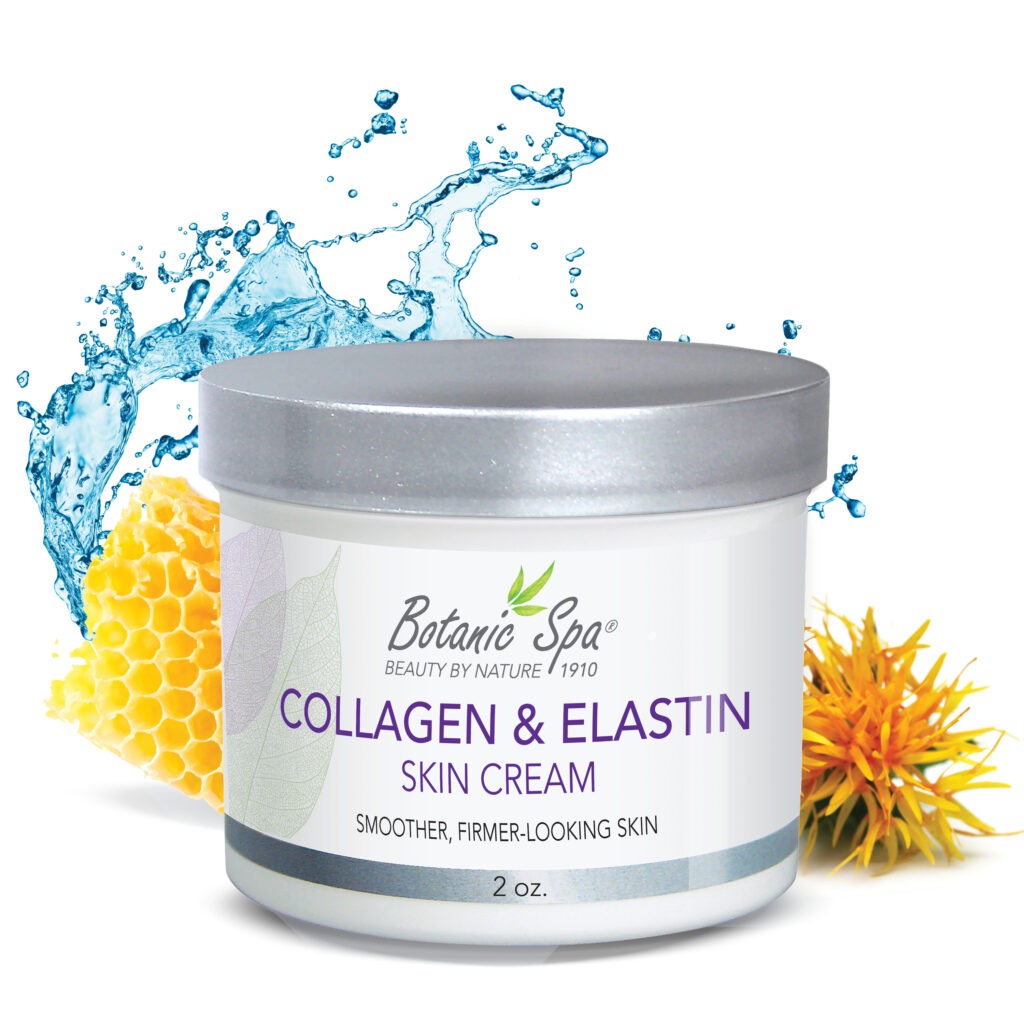
Your body’s natural collagen production starts slowing in your 30s, leading to wrinkles and less skin elasticity. A collagen supplement can help keep your skin firm and glowing.
Why it’s essential:
- Supports skin elasticity and hydration
- Strengthens hair and nails
- Aids in joint health
Best sources:
- Bone broth
- Chicken skin and fish
- Collagen powder supplements
Tip: Look for hydrolyzed collagen peptides for better absorption.
FAQs About the Best Vitamins for Women in Their 30s
Do I really need to take supplements, or can I get everything from food?
Ideally, you should get most nutrients from a balanced diet. But if you have dietary restrictions or deficiencies, supplements can help fill the gaps.
Can I take all these vitamins together?
Most of these vitamins work well together, but some can interfere with absorption. For example, calcium and iron shouldn’t be taken at the same time. Always check with your doctor for personalized advice.
How do I know if I have a vitamin deficiency?
Common signs include fatigue, brittle nails, hair thinning, poor sleep, and frequent illness. If you suspect a deficiency, a blood test can confirm it.
What’s the best time of day to take vitamins?
- Morning: B vitamins, iron, and Vitamin D for energy
- Evening: Magnesium and collagen for relaxation and skin repair
Are there any vitamins to avoid taking too much of?
Yes! Fat-soluble vitamins like A, D, E, and K can build up in your system if taken excessively, potentially leading to toxicity. Always stick to recommended dosages.
Conclusion
Your 30s are a pivotal time for setting the foundation for long-term health. Whether it’s boosting energy, improving skin, or strengthening bones, the best vitamins for women in their 30s can make a big difference in how you feel every day.
Start with a nutrient-rich diet, supplement when needed, and listen to your body. Taking care of yourself now will pay off in your 40s, 50s, and beyond.
Looking for a personalized supplement plan? Talk to a healthcare provider to find the best fit for your needs. Stay healthy, stay strong, and keep shining!

How to Style Graphic Tees
How to Style Graphic Tees: The Ultimate Guide to Effortless Fashion
Graphic tees are more than just casual staples—they’re statement pieces that reflect personality, style, and creativity. Whether you love vintage band tees, bold typography, or artsy designs, styling them can elevate your outfit from basic to effortlessly cool. But how do you wear graphic tees without looking too casual or sloppy?
In this guide, we’ll explore multiple ways to style graphic tees for different occasions, body types, and personal aesthetics. From chic layering to trendy accessories, you’ll learn how to turn your favorite tee into a fashion-forward look.
How to Choose the Right Graphic Tee
Before diving into styling, picking the right graphic tee is key. Here’s what to consider:
1. Fit Matters
- Oversized tees give off a relaxed, trendy vibe.
- Fitted tees create a polished and put-together look.
- Cropped graphic tees are perfect for high-waisted bottoms.
2. Design & Colors
- Neutral colors (black, white, gray) are versatile and easy to style.
- Bold colors add personality and make a statement.
- Minimalist graphics work for a sleek and modern aesthetic.
3. Fabric Quality
- 100% cotton tees offer breathability and comfort.
- Blended fabrics (cotton + polyester) provide stretch and durability.
- Vintage-washed tees give a worn-in, soft feel.
Dressing Up Your Graphic Tee
Looking for an easy way to style your graphic tee for daily wear? Here are a few outfit ideas:
1. Graphic Tee with Wide Leg Jeans
I love this look! The jeans pair perfectly with this classy vintage top. This outfit is comfortable, yet effortlessly chic. The nude heels are not too tall so you can run errands with this outfit on the weekends. You can also wear this to work for Casual Fridays!
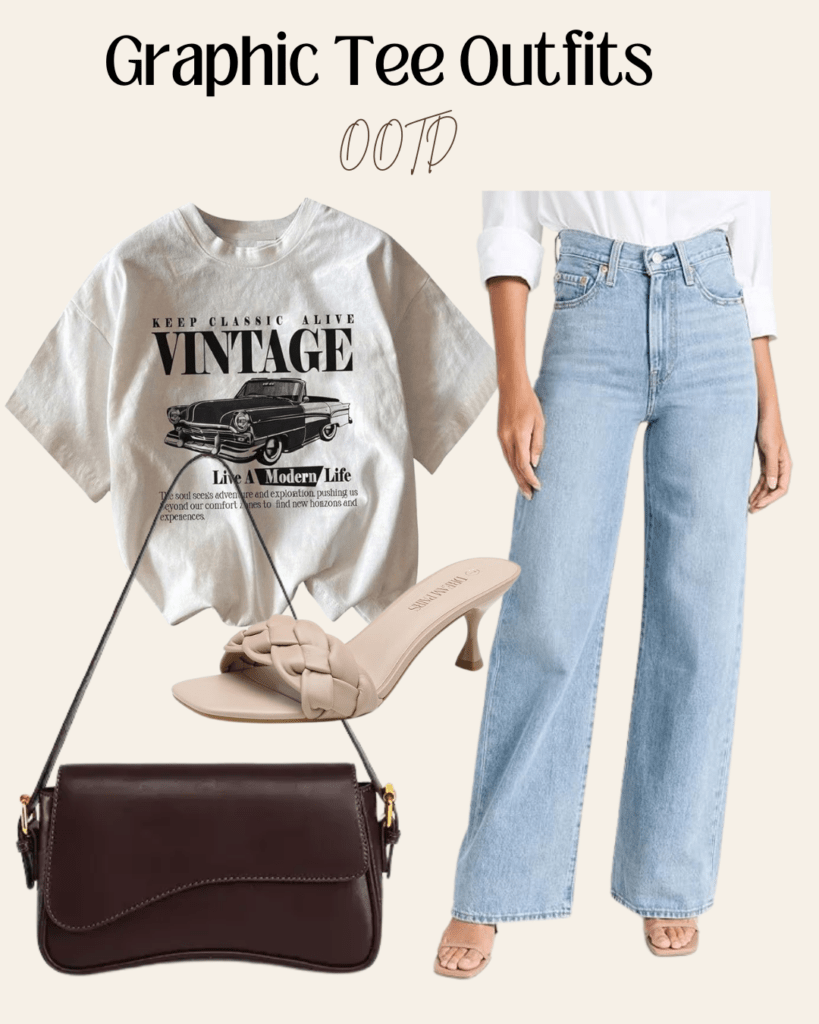
Shop the look: Tee Shirt | Jeans | Handbag | Shoes
2. Wide Leg Dress Pants with Slouchy Bag
Slouchy bags are in, and I am so excited about it! This classy look is perfect for those who love adding some color to their wardrobe. Imagine walking into brunch wearing this effortlessly chic outfit. Pair this with pointy flats for sophistication or sneakers for a casual-vibe.

Shop the look: Pants | Tee Shirt | Slouchy Bag | Shoes | Perfume | Gold Watch
3. Baggy Jeans and Pumps

Shop the look: Heels | Graphic Tee | Bag | Jeans
Other Classy Ways to Style Graphic Tees
1. Layering with Blazers
A structured blazer instantly upgrades a graphic tee from casual to classy.
- Pair with tailored pants for a business-casual look.
- Opt for an oversized blazer for a trendy, relaxed aesthetic.
- Finish with heels or loafers for a polished touch.
2. High-Waisted Trousers
One thing we love is simplicity. I said simple, not basic! This is a perfect everyday look. You can tuck this graphic tee into the high-waisted trousers for a more sophisticated yet trendy look. I love wide-leg trousers because they give a modern, fashion-forward vibe. Add statement jewelry for a chic finish.
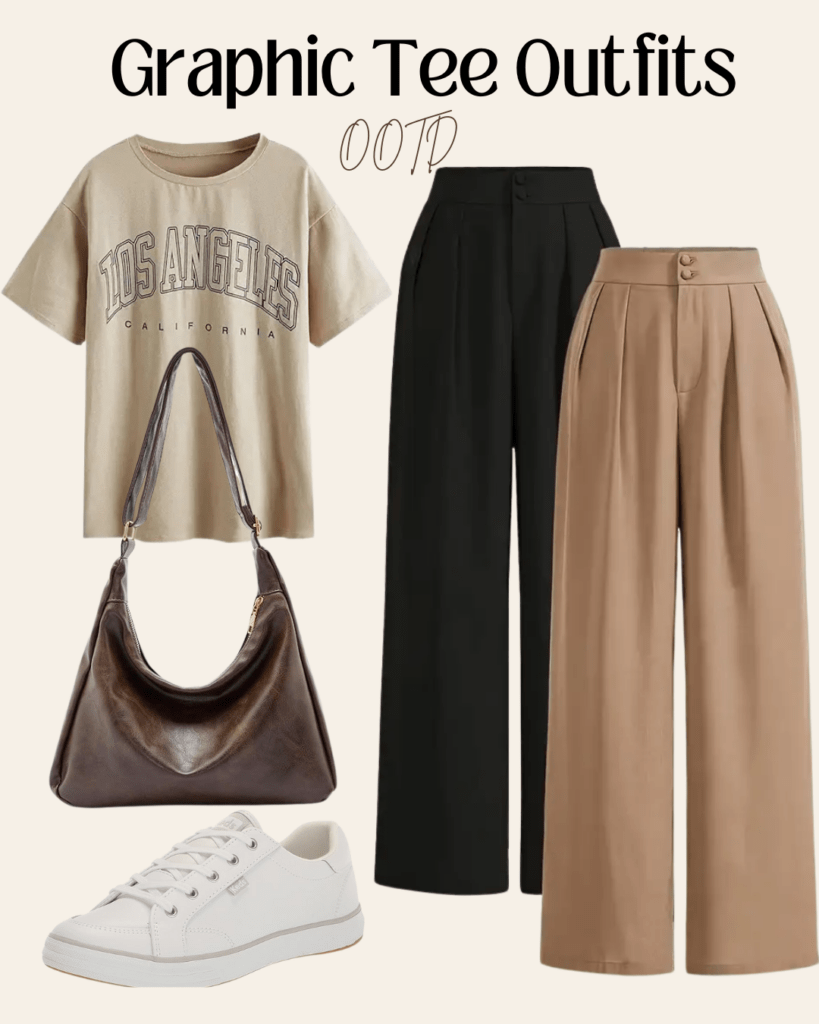
Shop the look: Tee Shirt | Pants | Handbag | Shoes
3. Pairing with Statement Accessories
Accessories can transform a simple graphic tee into a statement outfit. Try:
- Bold earrings or layered necklaces.
- A stylish belt to cinch the waist.
- A structured handbag to add refinement.
Edgy and Street Style Looks
If you love a bold and trendy aesthetic, these outfit ideas are for you.
1. Leopard Print Skirt & Combat Boots
Get into this cool street-style look! Leopard print is in, and we are taking full advantage of that! You can also throw on a leather jacket with this look or pair with ripped jeans or leather pants. You can also swap the combat boots with chunky sneakers.
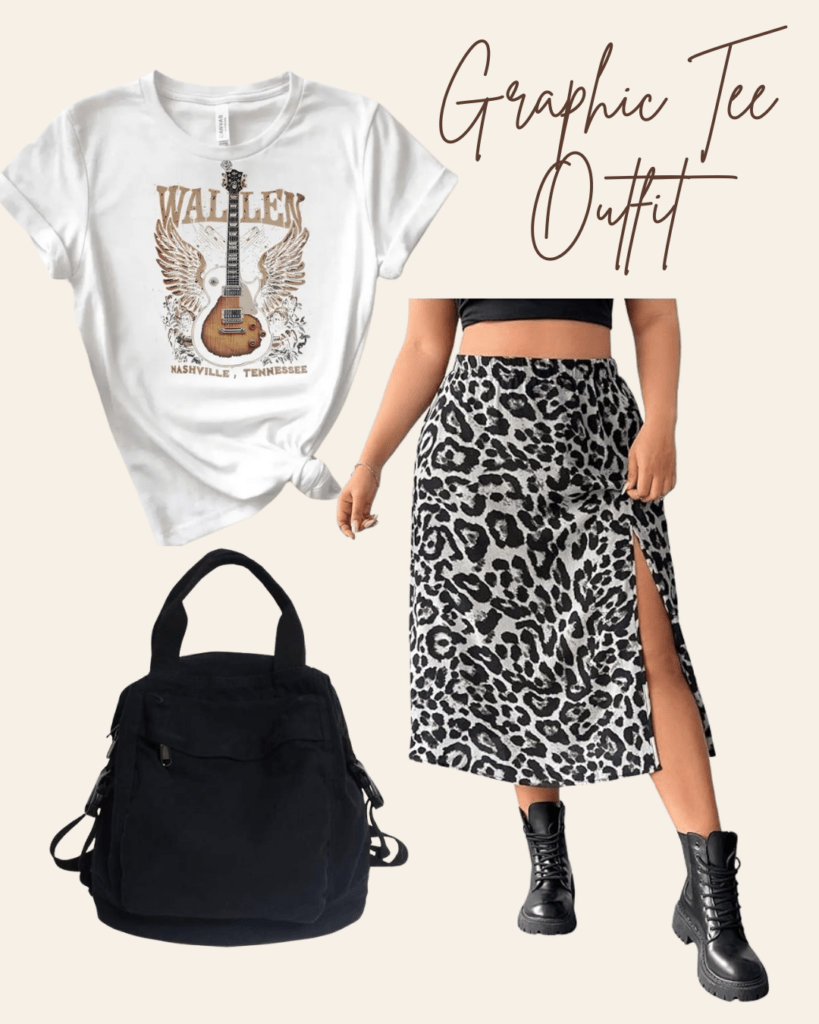
Shop the look: Skirt | Tee Shirt | Bag
2. Layering with Flannels or Hoodies
Want a grunge-inspired outfit? Layer your tee with a flannel or hoodie.
- Tie a flannel around your waist for a 90s vibe.
- Wear an oversized hoodie underneath a graphic tee for a layered look.
3. Cargo Pants & Chunky Sneakers
Graphic tees pair perfectly with cargo pants for an urban streetwear look.
- Choose neutral or camo prints for a bold statement.
- Finish with dad sneakers or high-top Converse.
Graphic Tees for Different Seasons
Spring & Summer
- Tuck a graphic tee into denim shorts with sneakers or sandals.
- Knot the tee at the waist for a cropped effect.
- Wear with a lightweight kimono for a boho vibe.
Fall & Winter
- Layer under a cozy cardigan or oversized sweater.
- Wear with a trench coat or wool coat for a chic touch.
- Pair with knee-high boots or ankle boots for extra warmth.
Creative Ways to Style Graphic Tees
Looking for fresh ideas? Try these creative styling hacks:
1. Knot It Up
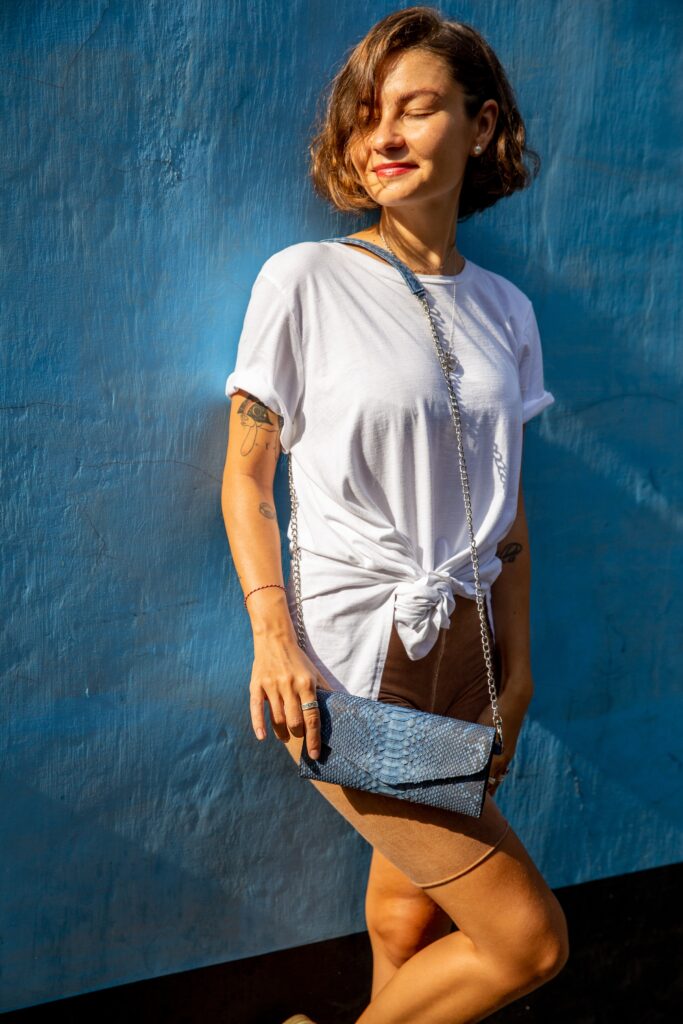
- Tie a knot at the front or side to create a cropped effect.
- Works great with high-waisted jeans, skirts, or shorts.
2. Layer Over a Dress
- Wear a graphic tee over a slip dress or bodycon dress.
- Cinch with a belt for a defined waist.
3. Belted & Tucked-In Looks
- Tuck your tee into jeans and add a statement belt.
- Try a French tuck (half-tuck) for a casual yet polished look.
Final Styling Tips for Graphic Tees
- Balance Proportions: If your tee is oversized, pair it with fitted bottoms.
- Experiment with Footwear: Sneakers for casual, boots for edgy, heels for chic.
- Mix Textures: Leather, denim, or silk can add contrast and style.
- Keep Accessories Minimal: Let the graphic tee be the focal point.
Conclusion
Graphic tees are one of the most versatile pieces in any wardrobe. Whether you’re going for a casual, chic, edgy, or street-style look, there are endless ways to style them. By mixing and matching different pieces, layering creatively, and accessorizing thoughtfully, you can make your favorite graphic tee work for any occasion. Happy styling!
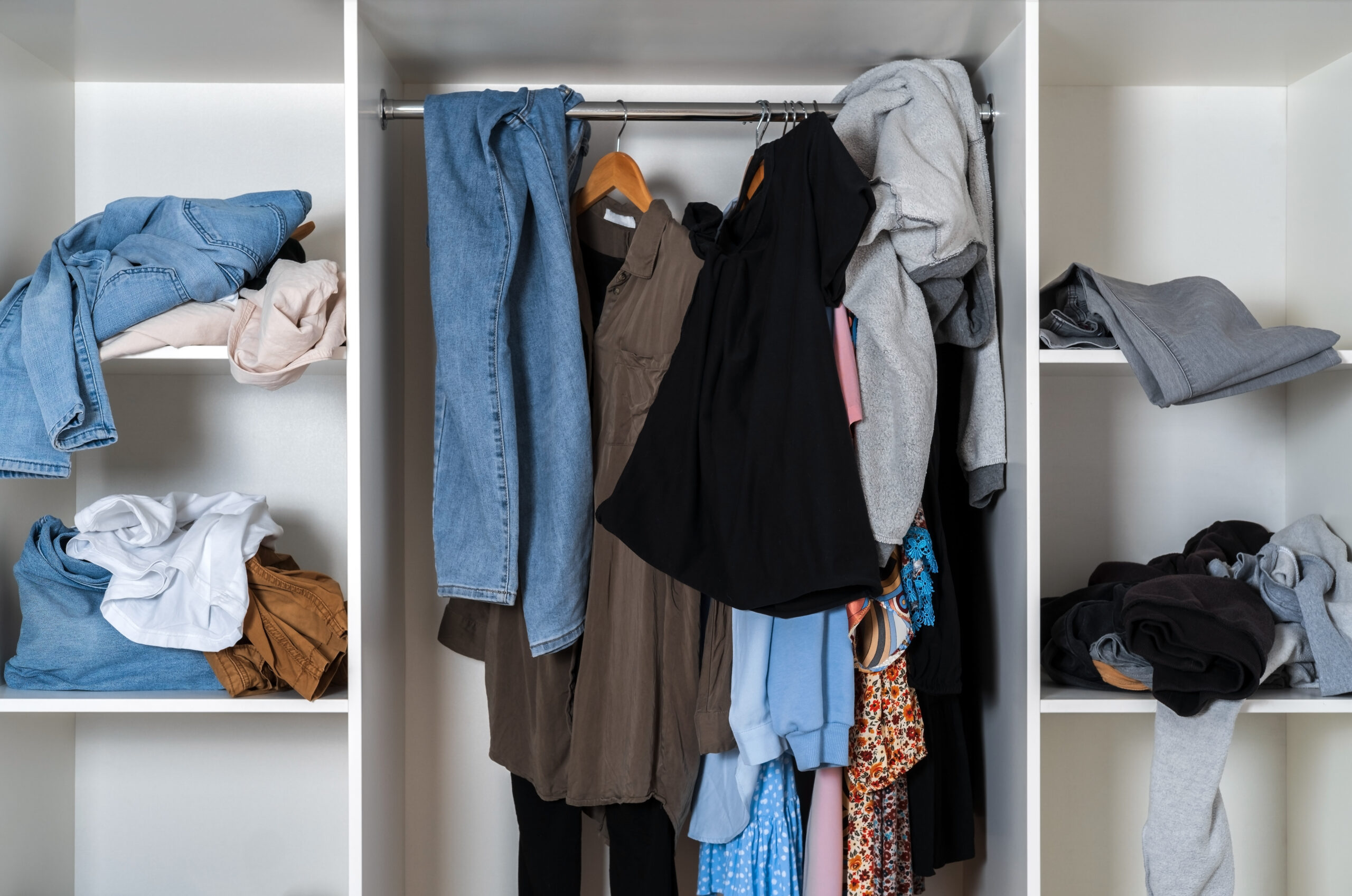
Different Types of Closets
Fixing Your Wardrobe: Solutions for Every Type of Closet
In order to start dressing better, we must get comfortable with the idea of “out with the old in with the new.” What I mean by this is we need to get rid of those horrid items that are taking up space in our closets causing us to have a mental breakdown every time we decide to get up and get dressed. Before we go throwing away everything in our closets, we need to do some detective work. Go into your closet and begin looking at the clothing that you have, but you need to do so objectively. As you read through this post, identify which type of closet you have and consider the steps you can take to improve it. We’ll explore different closet types, and I’d be willing to bet that everyone reading this will see themselves in at least one or two of these categories. Let’s dive in!
The Mediocre Closet
I know we are starting off a little strong but stick with me here. If you have this type of closet, you have no clothing pieces that stand out or pop! Nothing bold, classy, or exquisite. Just basics. Everything looks pretty much the same because you hardly go out anyway, so why bother? Nothing is wrong with this type of closet per say, but it might be in your best interest to add a bit of color, pattern or texture to bring those basics to life. Here are some steps you can take to improve your wardrobe.
- Identify your personal style—create a mood board for inspiration.
- Invest in statement pieces (bold colors, prints, or unique cuts).
- Add accessories like scarves, jewelry, or structured handbags.
- Incorporate textures and layers to add depth.
- Try styling your basics in new ways (layering, mixing prints, tucking vs. untucking).
The Outdated Closet
If you are a 90’s baby like me, you love some acid-washed jeans, a tube top, and jelly sandals. Lol okay maybe we are not dressing that old school but if you fall into this category, you may have some clothing pieces that you have held onto for a while. You are typically a neat person, and your clothing is in pretty good condition, they just look old-fashioned. The solution?
- Do a purge—donate items that don’t fit or look dated.
- Keep classic pieces like blazers, denim, and neutral sweaters.
- Modernize with current silhouettes—swap bootcut jeans for straight-leg, or boxy blazers for fitted ones.
- Mix old with new—pair a vintage top with trendy high-waisted pants.
- Tailor items to update the fit (cropping jackets, tapering pants, adjusting sleeve lengths).
The Packed Closet
You sure do love a good deal. Don’t worry, so do I, however, it is time to declutter your space. You may have attempted to clean out your closet but found every reason to keep certain items. Some of your excuses may be: “It was a gift from a friend.” “The price tag is still on there.” “I never wore this one, but I plan to.” You get my point. You can never find anything you need because your closet is full to the brim! The solution?
- Do a wardrobe detox—if you haven’t worn it in a year, donate it.
- Categorize clothes by season and store out-of-season items elsewhere.
- Use the “hanger trick” (turn all hangers backward; after wearing something, turn the hanger forward—after six months, donate untouched items).
- Create go-to outfits for different occasions and take photos for easy reference.
- Consider a minimalist approach—curate a wardrobe with only essentials that mix and match well.

The Thrift Store Closet
If you have this type of closet, just about everything you bought was on sale at your local JC Penny or you found it at Goodwill or some other discount store. Now, you may have found some staples but none of the pieces go together so you are stuck with some nice, thrifted finds that you can’t wear. This is the category I fall into by the way, so I know it all too well. So, what can you do about your thrift store closet?
- Create a capsule wardrobe—stick to a defined color palette.
- Stop buying things just because they’re cheap—ask, “Would I pay full price for this?”
- Declutter by getting rid of items that don’t fit your style.
- Be intentional—only buy pieces that work with at least three outfits.
- Invest in key pieces instead of multiple “okay” ones.
The Trendy Closet
You fall into this category if you wear most of your clothing items once or twice and have a wide variety of colors, prints, and styles. Although you have nice clothes, you may find it hard to put many of your clothes together. Your solution?
- Identify core basics that work year-round (white button-ups, classic denim, neutral tops).
- Limit trend purchases—choose only 1-2 trendy pieces per season.
- Balance fast fashion with quality staples that last.
- Focus on timeless silhouettes rather than fleeting styles.
- Use accessories to add trendiness rather than replacing entire outfits.
Final Thoughts About Different Types of Closets
No matter what type of closet you have, the key to a great wardrobe is intentionality. Declutter, define your style, and invest in pieces that truly serve you. By making these small changes, you can turn your closet into a space filled with outfits you love—without the stress!

How to Feel Beautiful
How to Feel Beautiful Even When You’re Just Going to Work
Getting dressed for work every morning doesn’t always feel glamorous. Whether you’re rushing out the door with a coffee in hand or hopping on yet another Zoom meeting in your ‘work-appropriate’ loungewear, it’s easy to fall into a routine that feels repetitive and a bit boring. But just because you’re headed to work doesn’t mean you can’t feel beautiful and confident in the process. Here’s how to bring a little extra radiance to your workday, no matter what’s on your to-do list.
Start with Skincare
Your morning routine sets the tone for your entire day. Taking a few extra minutes to cleanse, moisturize, and apply sunscreen can make a world of difference in how you feel. Remember, when you look good, you feel good! A glowing complexion can instantly boost your confidence, even if you’re keeping your makeup minimal.
Disclosure: Some of the links in this post are ‘affiliate links’. This means if you click on the link and purchase the item, I will receive an affiliate commission.
How to Feel Beautiful – Light, Effortless Makeup
Makeup is of course optional, but it can really make a difference in the way you feel throughout the day. To make this process less complicated, keep makeup to a minimum. A small amount of tinted moisturizer, mascara, and lip gloss can enhance your natural beauty without taking up too much time in the morning. If you love a bold lipstick, don’t be afraid to wear it to work—confidence is the best accessory!
Wear What Makes You Feel Good
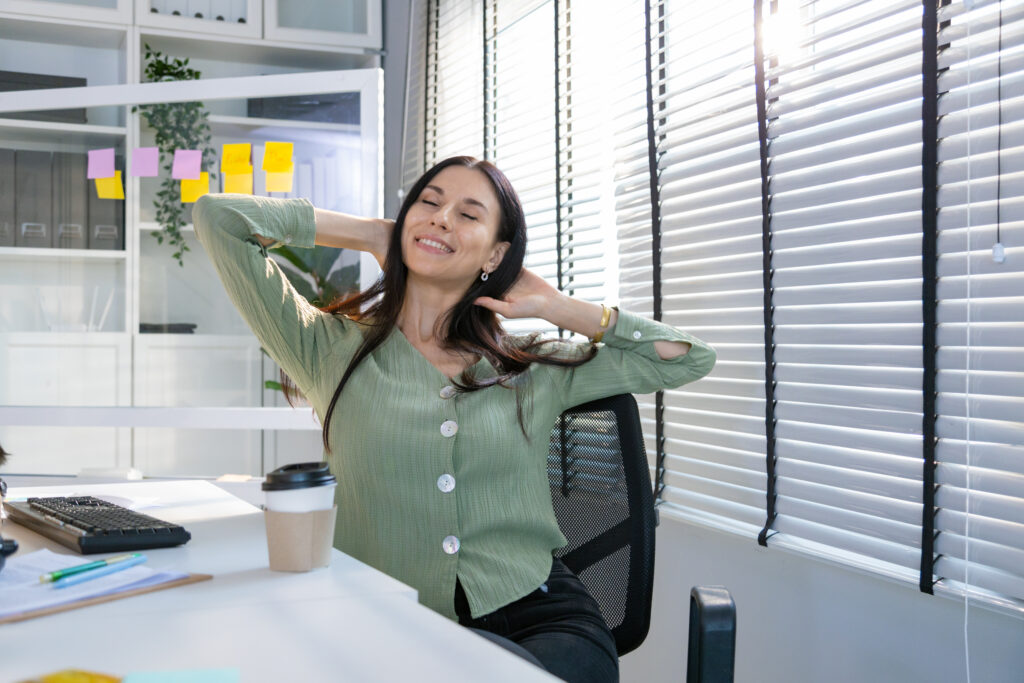
Even if your job has a strict dress code, you can still find ways to incorporate pieces that make you feel amazing. I work from home, so I make sure to wear comfortable lounge pants and put more effort towards making sure the upper part of my body looks “zoom ready.” If you work in an office, create a uniform. Find a few blouses that fit just right, a few pairs of chic flats that feel effortlessly stylish, and some statement accessories to brighten up your outfit. Small choices can make a big impact on how you carry yourself.
Embrace Simple, Polished Hairstyles
You don’t need a salon-fresh blowout to feel put together. A sleek ponytail, a chic bun, or soft waves can elevate your look in minutes! Since my hair is relaxed, I stick to the basics by wearing my hair down with a middle or side part on most days. On other days, I wear a sleek ponytail with a cute hair bow. Find a few easy go-to styles that work for your hair type and make you feel polished with minimal effort.
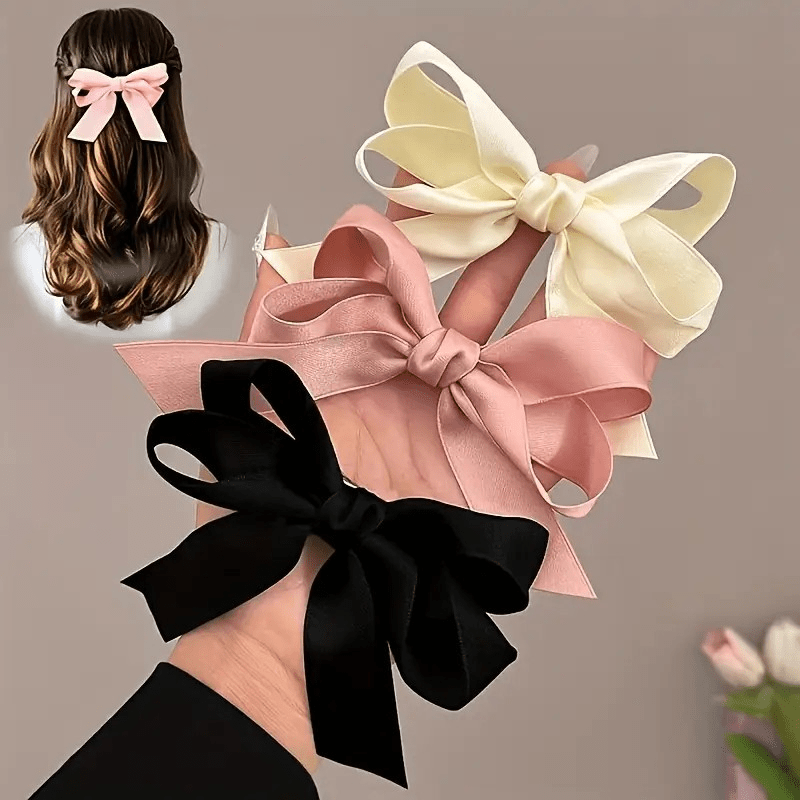
Fragrance for an Extra Confidence Boost
Scent has a powerful effect on mood. A light spritz of your favorite perfume or a subtle essential oil can make you feel fresh and energized throughout the day. Just be mindful of office etiquette—go for something soft and not overpowering.

How to Feel Beautiful – Posture and Mindset Matter
Nothing makes you look and feel more beautiful than confidence. Stand tall, keep your shoulders back, and walk with purpose. When you feel good about yourself, it shows, no matter what you’re wearing.
Find Joy in the Little Things
Sometimes, it’s the smallest moments that make us feel the most beautiful. Enjoy your morning coffee in a cute mug, listen to your favorite playlist on the way to work, or take a moment to compliment yourself in the mirror before heading out. Finding little joys in your routine can make each day feel more special.

Surround Yourself with Positive Energy
Beauty isn’t just about how you look—it’s also about how you feel. Spend time with people who uplift and inspire you, even if it’s just a quick chat with a coworker or a supportive text from a friend. Positivity radiates, and when you feel good on the inside, it shines through on the outside.
End the Day with Self-Care
You’ve had a long day of taking care of everyone else, now it’s time to take care of yourself. It can be challenging to focus on your self-care in the evenings especially when you have so many obligations. Take time to unwind, whether it’s with a relaxing skincare routine, a good book, or a few moments of mindfulness. When you care for yourself consistently, beauty becomes a daily habit.

Keep Evolving Your Style and Self-Care Routine
Feeling beautiful is an ongoing journey. Don’t be afraid to experiment with new styles, try different makeup looks, or switch up your skincare routine. As you grow and change, your sense of beauty should evolve with you. Embrace the process and enjoy discovering what makes you feel the best version of yourself.
At the end of the day, feeling beautiful is about so much more than appearances. It’s about confidence, self-care, and embracing the little things that make you feel like the best version of yourself—even when you’re just going to work.

Minimalist Outfits
Minimalist Outfits: The Ultimate Guide to Effortless Style
What Are Minimalist Outfits?
At its core, a minimalist outfit is all about simplicity, functionality, and timelessness. These outfits focus on:
- Neutral colors – Think black, white, gray, beige, and navy.
- Clean lines – Simple silhouettes without unnecessary embellishments.
- High-quality fabrics – Well-made pieces that stand the test of time.
- Versatility – Clothes that can be mixed and matched effortlessly.
Minimalist fashion isn’t boring—it’s intentional. When done right, it looks polished, put-together, and effortlessly stylish.
Why Choose Minimalist Outfits?
1. Saves Time and Energy
2. Long-Term Savings
Fast fashion trends come and go, but minimalist pieces never go out of style. Investing in timeless basics means you won’t have to replace your wardrobe every season.
3. Elevates Your Style
A cluttered closet often leads to messy, mismatched outfits. But with a minimalist wardrobe, every piece complements the others, making you look effortlessly chic without even trying.
4. Eco-Friendly Choice
Minimalism naturally leans towards sustainability. By focusing on quality over quantity, you reduce waste and support ethical fashion choices.
How to Build a Minimalist Wardrobe
1. Declutter Your Closet
- Have I worn this in the past year?
- Does this fit my personal style?
- Can I wear this in multiple ways?
If the answer is no, it’s time to let it go.
2. Stick to a Neutral Color Palette
Minimalist outfits thrive on neutral shades because they’re easy to mix and match. That doesn’t mean your wardrobe has to be all black and white—earthy tones, soft blues, and muted pastels work beautifully too.
3. Invest in High-Quality Basics
Every minimalist wardrobe should include a few staple pieces:
- White button-down shirt – A classic piece that works for both casual and formal occasions.
- Black or navy blazer – Instantly elevates any outfit.
- Well-fitted jeans – A must-have for effortless style.
- Plain t-shirts and tank tops – Perfect for layering.
- Tailored trousers – A chic alternative to jeans.
- Classic sneakers and loafers – Comfortable yet stylish footwear.
4. Choose Versatile Pieces
Before buying anything new, ask yourself: “Can I wear this in at least three different ways?” If the answer is yes, it’s a keeper. The two-piece set below is super affordable and can be styled in numerous ways. You can pair this with some sneakers, a tote bag, and baseball cap for a casual look. Add heels, some statement jewelry and a clutch for a classier look!
5. Focus on Fit and Fabric
A well-fitted outfit always looks more put-together. Invest in high-quality fabrics like cotton, wool, and linen that feel good and last longer.
Minimalist Outfits for Every Occasion
1. Casual Minimalist Look

Shop the Look: Slouchy Bag | Sunglasses | Sleeveless Cropped Knit Cardigan | Levi Jeans
2. Office-Ready Minimalist Outfit
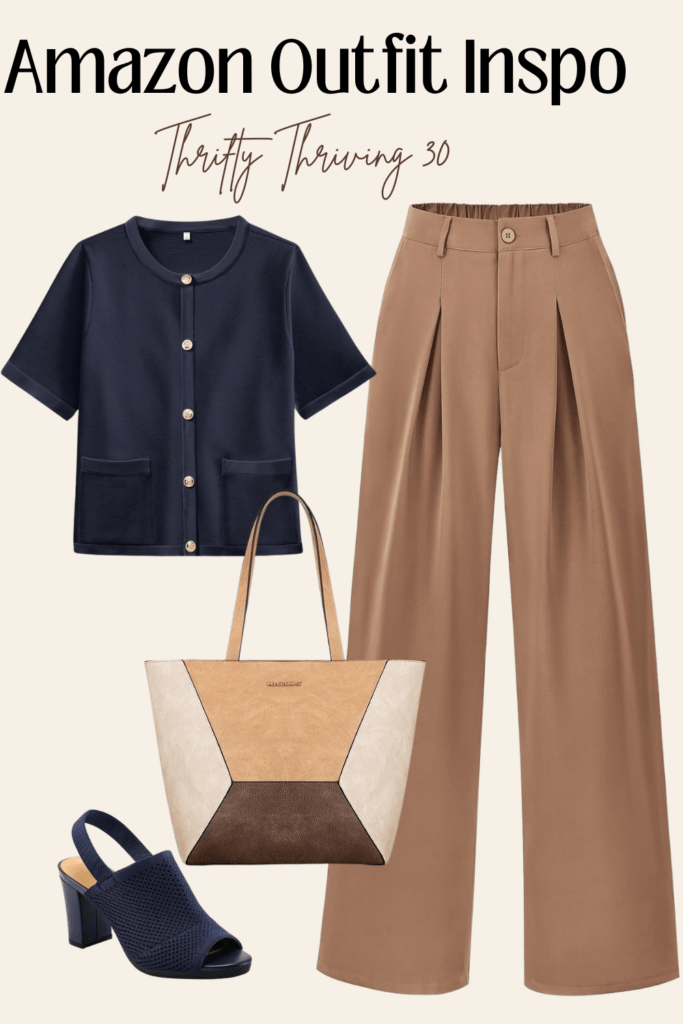
Shop the Look: Short Sleeve Cardigan Sweater | Tote Bag | High Waist Palazzo Pants | Chunky Block High Heel Shoe
3. Minimalist Weekend Errands Outfit
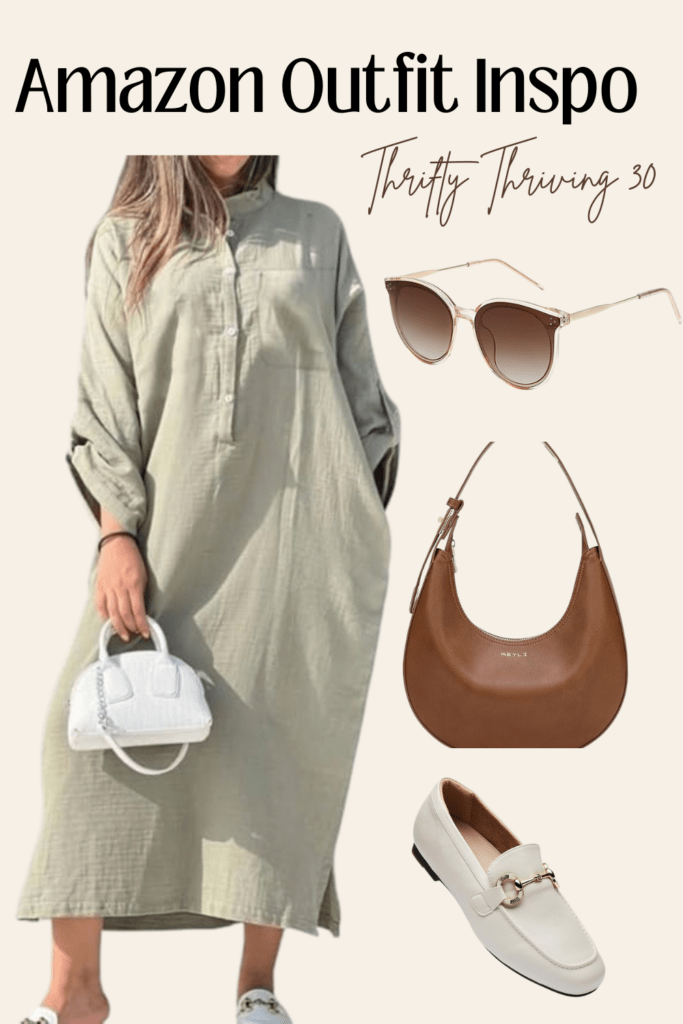
Shop the look: Dress | Sunglasses | Shoulder Bag | Slip on Shoe
4. Preppy Minimalist Outfit
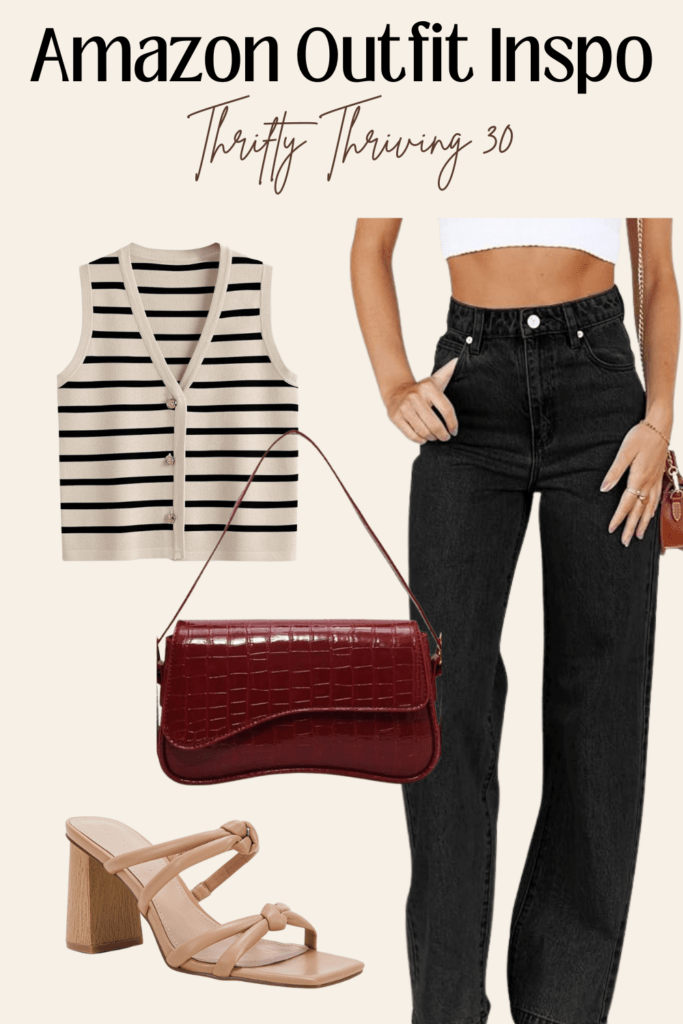
Shop the Look: Shoulder Bag | Jeans | Sweater Vest | Open Toe Heeled Sandal
5. Everyday Minimalist Outfit
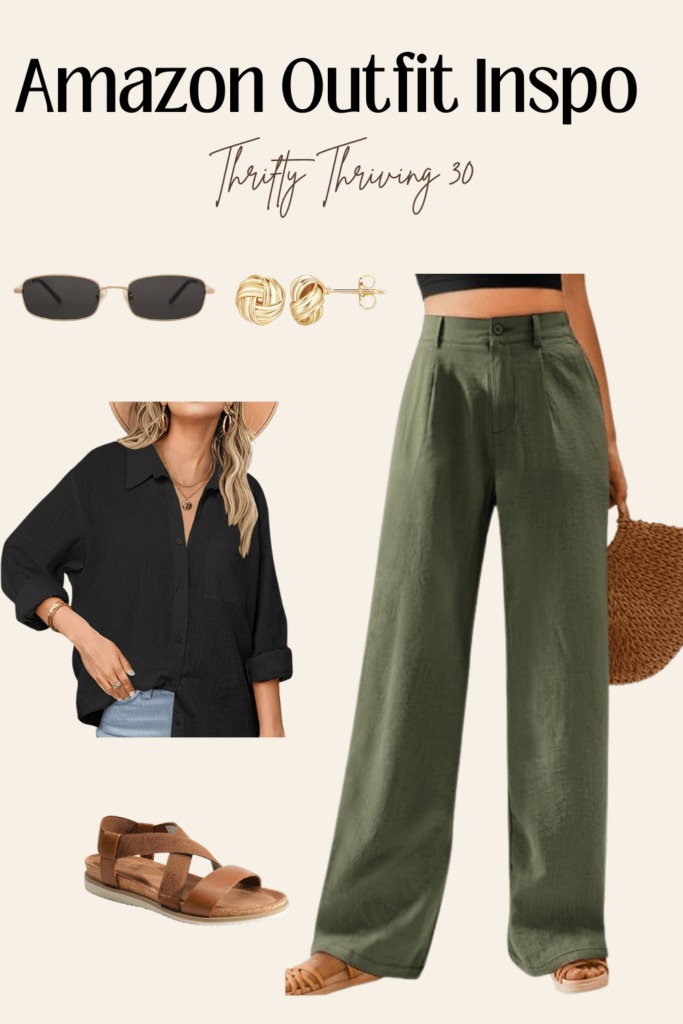
Shop the Look: Blouse | Gold Stud Earrings | Wide Leg Pants | Low Wedge Sandals
Common Myths About Minimalist Outfits
1. Is Minimalist Fashion Just Black and White?
Nope! While neutral colors dominate, you can add subtle pops of color like olive green, rust, or deep blue for variety.
2. Do Minimalist Outfits Mean Dressing Boring?
Absolutely not. Minimalism is about refined simplicity, not a lack of style. The key is in the details—textures, layering, and accessories.
3. Is Minimalist Fashion Expensive?
Not necessarily. While high-quality items may cost more upfront, they last longer, saving you money in the long run.
4. Can Minimalist Outfits Work for All Body Types?
Yes! The beauty of minimalist fashion is its adaptability. Tailored fits and clean lines complement all shapes and sizes.
FAQs
1. How do I start dressing in a minimalist style?
Begin by decluttering your wardrobe, sticking to neutral colors, and investing in versatile, high-quality basics.
2. What brands are best for minimalist fashion?
Some great minimalist brands include Everlane, COS, Uniqlo, and The Frankie Shop.
3. Can I still follow trends while keeping a minimalist wardrobe?
Of course! Just be selective—incorporate trendy pieces that align with your minimalist aesthetic rather than chasing every new fad.
4. How many pieces should be in a minimalist wardrobe?
There’s no strict number, but most minimalist wardrobes have around 30-50 pieces, including shoes and accessories.
Conclusion
Minimalist outfits aren’t about sacrificing style—they’re about refining it. With a carefully curated wardrobe, you’ll save time, money, and effort while looking effortlessly polished every day.
So, ready to embrace the less-is-more philosophy? Start building your minimalist wardrobe today and experience the freedom that comes with it.
Want more style tips? Stay tuned for more fashion insights!
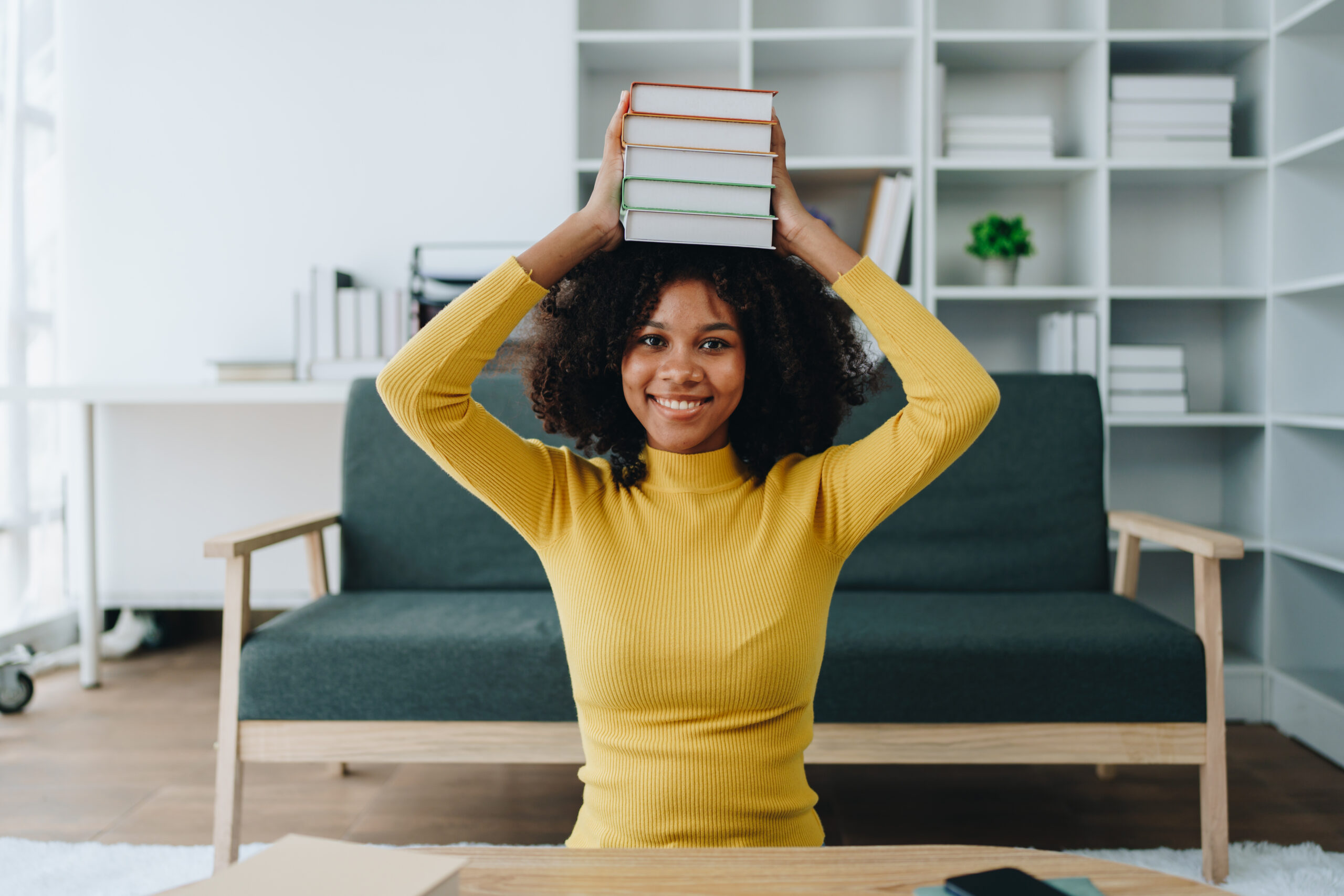
Popular Self-Help Books
A Detailed Review of Popular Self-Help Books
Self-help books have the power to inspire, motivate, and offer practical tools for personal growth. With so many options available, it can be difficult to determine which ones truly make a difference. Below is a review of five highly regarded self-help books, examining their key takeaways, strengths, and potential downsides.
1. Atomic Habits – James Clear

Summary: Atomic Habits focuses on the power of small, consistent improvements. Clear explains that making minor changes, when done consistently, can lead to significant life transformations. He introduces the concept of habit stacking, the importance of identity-based habits, and practical strategies for overcoming bad habits while forming good ones.
Strengths:
Practical, actionable advice backed by science
Simple, easy-to-follow steps
Encourages sustainable long-term change
Weaknesses:
Some concepts feel repetitive
More focused on behavioral changes than deep emotional work
Best For: People looking for a structured approach to building better habits and breaking bad ones.
2. The Subtle Art of Not Giving a F*ck – Mark Manson
Summary: Mark Manson takes a no-nonsense, counterintuitive approach to self-help, arguing that life is not about being happy all the time. Instead, he suggests that we should carefully choose what we care about, accept struggles, and find meaning in life’s difficulties.
Strengths:
Refreshingly blunt and humorous writing style
Encourages critical thinking about personal values
Avoids toxic positivity and unrealistic self-improvement expectations
Weaknesses:
Profanity and bluntness may not appeal to everyone
Lacks structured steps for personal growth
Best For: People who prefer a straightforward, no-BS approach to self-improvement.
3. The 7 Habits of Highly Effective People – Stephen R. Covey

Summary: This classic book outlines seven principles that can improve productivity and personal effectiveness. Covey divides the habits into three categories: personal victories (independence), public victories (interdependence), and renewal (continuous growth).
Strengths:
Timeless principles applicable to all areas of life
Focuses on long-term personal and professional development
Encourages self-awareness and responsibility
Weaknesses:
Can feel a bit dense and overly theoretical
Requires patience and commitment to implement effectively
Best For: Professionals, leaders, and those who want a structured approach to personal and career success.
4. You Are a Badass – Jen Sincero
Summary: Jen Sincero blends humor, personal anecdotes, and motivation to encourage readers to build confidence, take risks, and create the life they desire. She emphasizes the power of mindset, belief, and positive energy in achieving goals.
Strengths:
Motivational and uplifting tone
Simple and easy to read
Encourages readers to take bold action
Weaknesses:
Lacks deep scientific backing
Heavy focus on manifesting and positive thinking, which may not work for everyone
Best For: Anyone needing a motivational boost or struggling with self-doubt.
5. The Power of Now – Eckhart Tolle
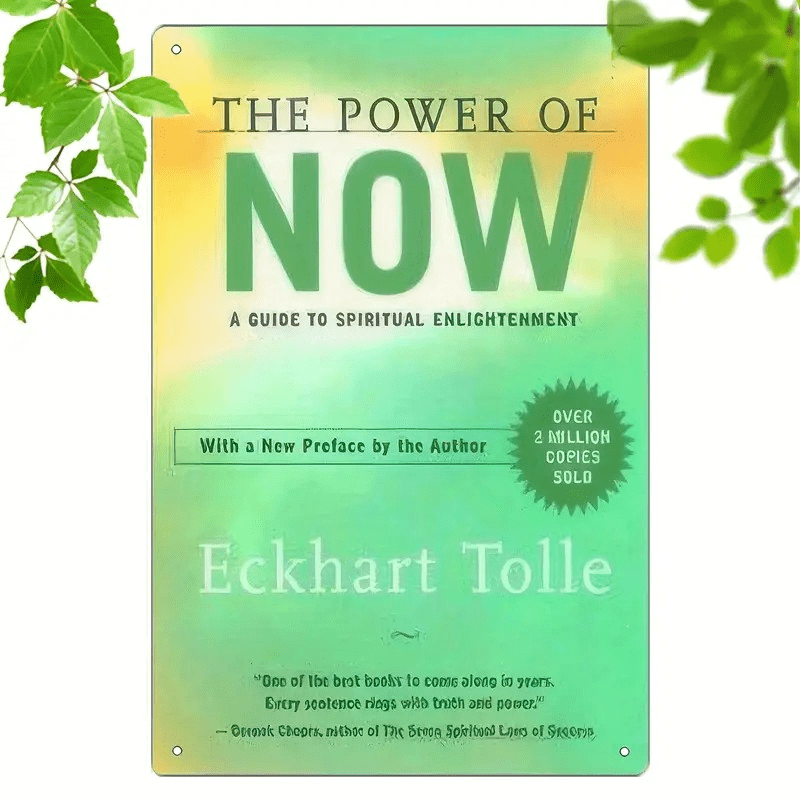
Summary: This spiritual self-help book encourages mindfulness and present-moment awareness. Tolle explains that most of our suffering comes from identifying too much with our thoughts, rather than simply experiencing the present.
Strengths:
Deep and thought-provoking
Helps reduce stress and anxiety through mindfulness
Encourages inner peace and self-acceptance
Weaknesses:
Can feel abstract or philosophical rather than practical
Not ideal for those looking for actionable step-by-step guidance
Best For: Those interested in mindfulness, spiritual growth, or stress reduction.
Why You Should Read Self-Help Books
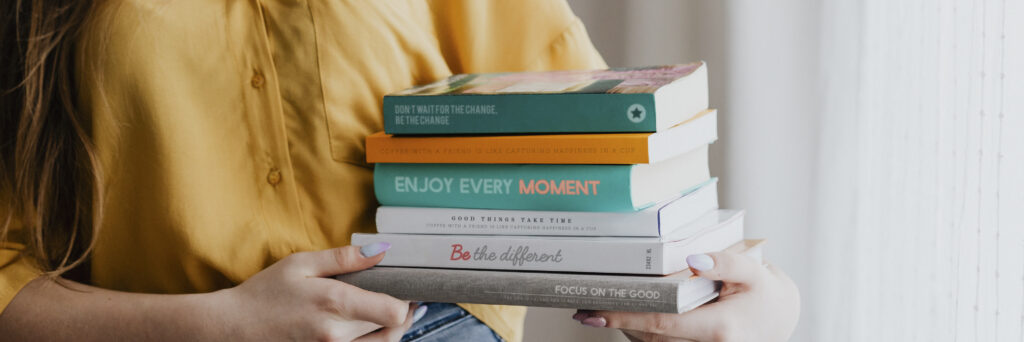
Reading self-help books can be a powerful way to gain new perspectives, develop positive habits, and improve various aspects of your life. They provide practical strategies for personal growth, motivation, and overcoming challenges, often based on research and real-life experiences. Whether you want to build confidence, manage stress, or boost productivity, self-help books offer valuable insights that can help you make meaningful changes. Plus, they serve as a source of inspiration, reminding you that growth and success are always within reach.
Final Thoughts on Popular Self-Help Books
Each of these books offers something unique, whether it’s practical habit formation, motivational mindset shifts, or philosophical perspectives.
- If you want practical habit-building advice, Atomic Habits is the best pick.
- If you enjoy straight talk and humor, The Subtle Art of Not Giving a Fck* or You Are a Badass are great choices.
- For a structured, principle-based approach, The 7 Habits of Highly Effective People is a timeless classic.
- If you’re seeking spiritual insight and mindfulness, The Power of Now is worth exploring.
No matter where you are on your self-improvement journey, there’s a book out there that can help you grow. What’s your favorite self-help book? Let me know in the comments!
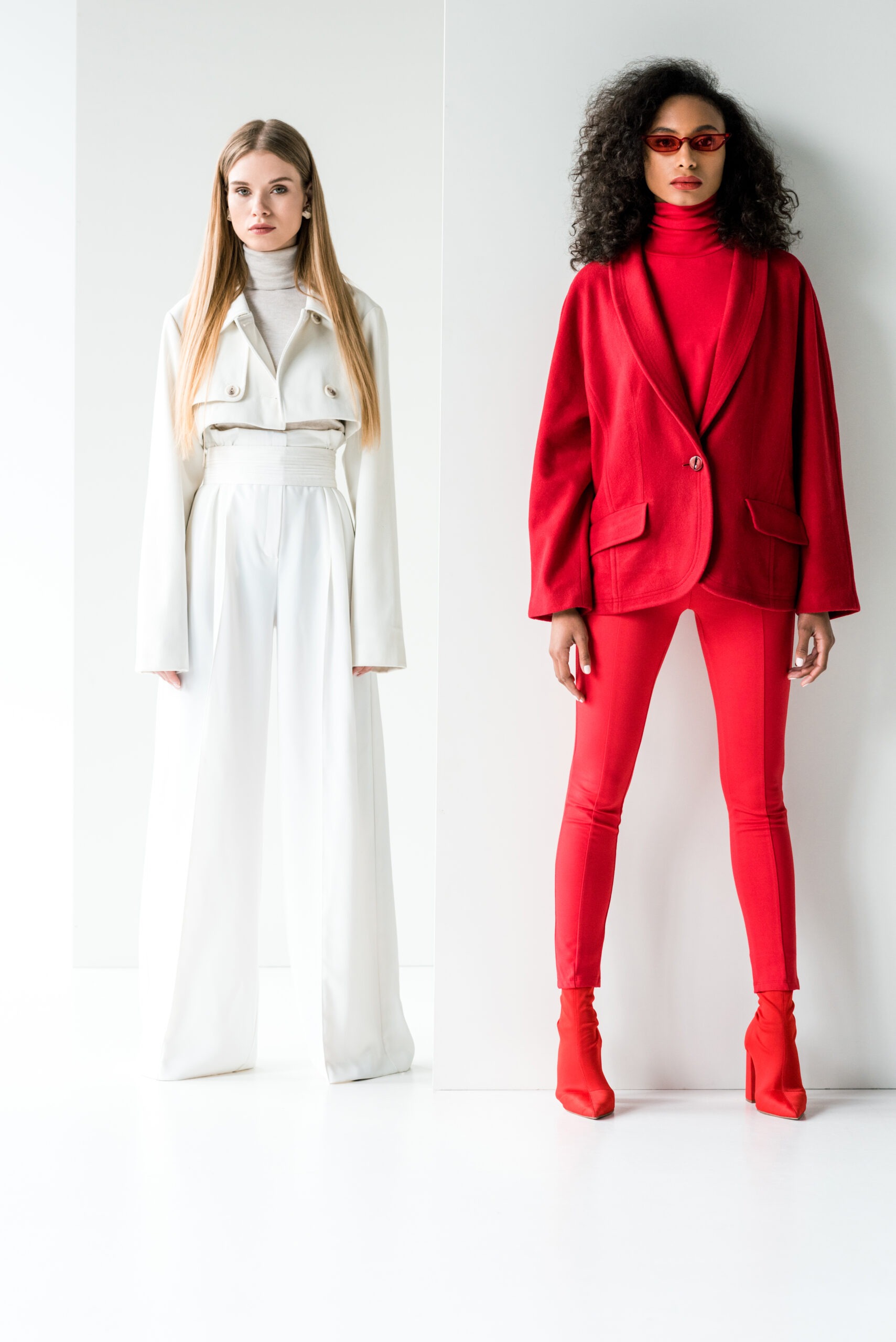
Types of Clothing Styles
Decoding Fashion: A Complete Guide to Types of Clothing Styles
Fashion speaks volumes before you say a word. The clothes we choose reflect our personalities, values, and how we want the world to perceive us. With countless options available today, understanding different types of clothing styles has become essential for anyone looking to refine their personal aesthetic or experiment with new fashion territories.
Whether you’re rebuilding your wardrobe, searching for inspiration, or simply curious about fashion’s diverse landscape, this guide will walk you through the most influential clothing styles shaping today’s fashion scene. We’ll explore their distinguishing characteristics, historical roots, and modern interpretations to help you navigate the rich tapestry of sartorial expression.
Understanding Types of Clothing Styles: Beyond Trends
The Cultural Significance of Clothing Styles
Fashion has always been more than mere clothing—it’s a visual language that evolves alongside society. Throughout history, types of clothing styles have emerged as responses to cultural movements, technological innovations, and shifting social values. What begins as practical necessity often transforms into powerful statements of identity and belonging.
In today’s digital age, clothing styles spread and transform faster than ever before. Social media platforms have democratized fashion, allowing subcultures and niche aesthetics to gain global influence virtually overnight. This accessibility has created unprecedented freedom for personal expression through clothing, blurring traditional boundaries between different style categories.
Timeless Types of Clothing Styles
Classic Elegance

Classic style emphasizes timeless sophistication through:
- Well-tailored silhouettes that honor proportion
- High-quality fabrics that improve with age
- Neutral color foundations with strategic accents
- Minimal but meaningful accessories
- Emphasis on fit rather than passing trends
This approach to dressing creates a refined, enduring aesthetic that transitions effortlessly between contexts and seasons.
Bohemian Spirit
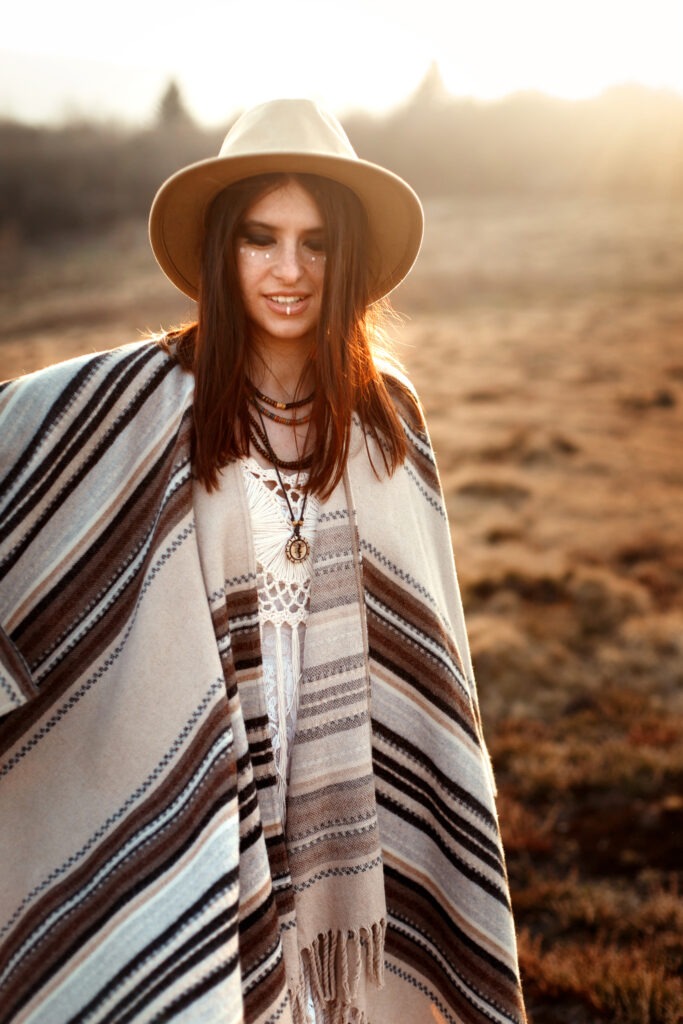
The bohemian (or “boho”) style celebrates artistic freedom and multicultural influences through:
- Loose, flowing garments that prioritize comfort
- Natural textiles like cotton, linen, and hemp
- Rich patterns and textures layered together
- Artisanal accessories featuring natural elements
- Warm, earthy colors interspersed with vibrant hues
This free-spirited aesthetic evokes creative expression, cultural appreciation, and harmony with nature.
Urban Streetwear

Born from youth culture, hip-hop, skateboarding, and graffiti art, streetwear has evolved into a dominant global force characterized by:
- Comfortable, often oversized silhouettes
- Bold graphics, logos, and statement pieces
- Athletic and utilitarian influences
- Limited-edition collaborations and drops
- Sneaker culture as a central component
Streetwear continues to challenge traditional fashion hierarchies by blending luxury with accessibility and comfort with cultural commentary.
Minimalist Refinement

Embracing the “less is more” philosophy, minimalist style features:
- Clean lines and uncluttered silhouettes
- Thoughtfully curated capsule wardrobes
- Monochromatic or limited color palettes
- Subtle textural variations instead of patterns
- Architectural influences in shape and structure
This approach focuses on quality over quantity, creating space for intentionality in both appearance and consumption habits.
Emerging Types of Clothing Styles
Conscious Fashion

As sustainability becomes increasingly central to fashion conversations, conscious style has developed its own aesthetic language:
- Ethically sourced and eco-friendly materials
- Transparent production practices and longevity
- Natural dyes and low-impact finishing techniques
- Upcycled and repurposed elements
- Celebration of craftsmanship and traditional techniques
This approach treats clothing as an investment in both personal expression and planetary wellbeing.
Digital Nomad Aesthetic
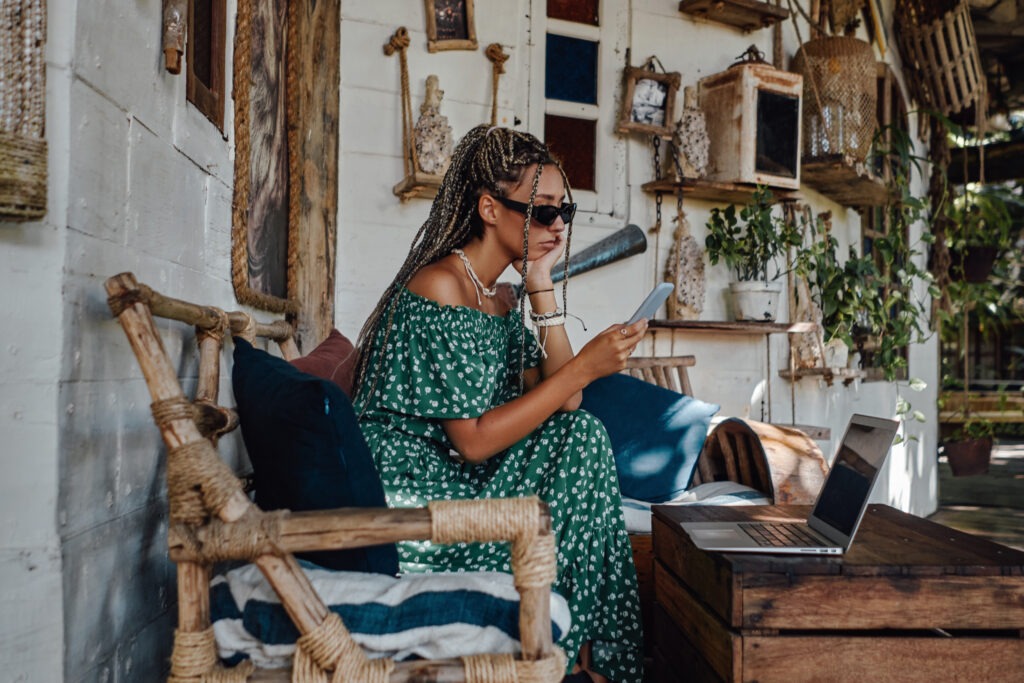
Responding to changing work patterns and increased mobility, this versatile style incorporates:
- Adaptable pieces that transition between environments
- Performance fabrics with technical benefits
- Modular designs that maximize packing efficiency
- Wrinkle-resistant and quick-drying properties
- Subdued color palettes for mixing and matching
This practical yet polished approach balances professional presentation with comfort and functionality.
Nostalgic Revival
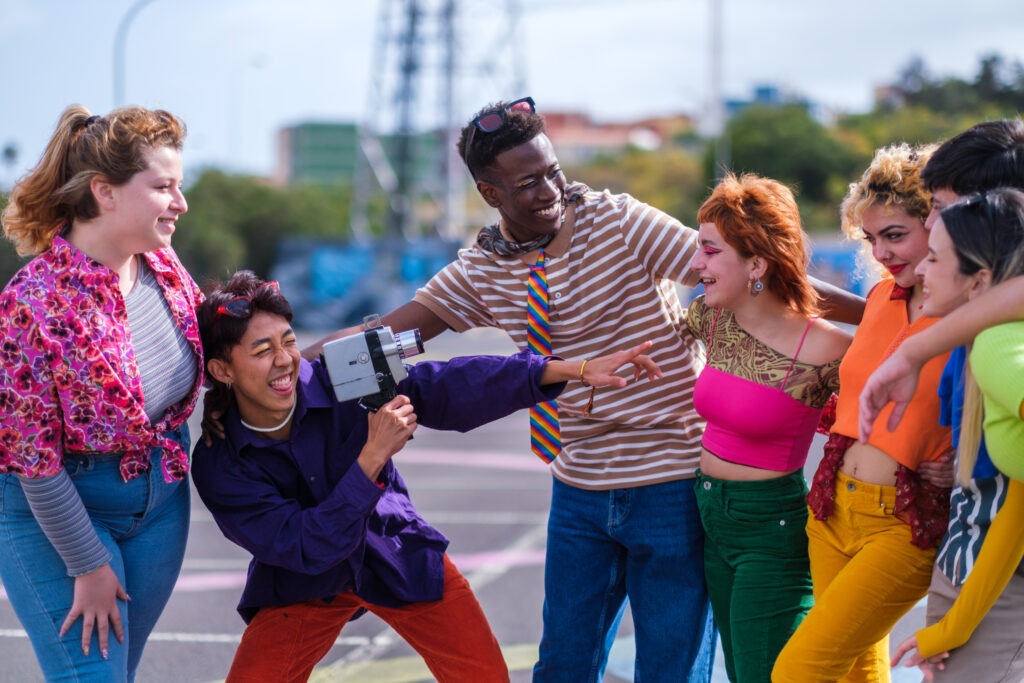
Drawing inspiration from previous decades, nostalgic styles reinterpret historical elements through contemporary lenses:
- Y2K aesthetics (1990s-2000s) featuring low-rise silhouettes, mini bags, and playful accessories
- 70s influences with wide-leg pants, platform shoes, and earthy palettes
- 80s-inspired bold shoulders, vibrant colors, and statement jewelry
- Vintage-sourced authentic pieces mixed with modern basics
These revivals allow wearers to reference cultural touchpoints while creating fresh, relevant looks.
Fluid Expression
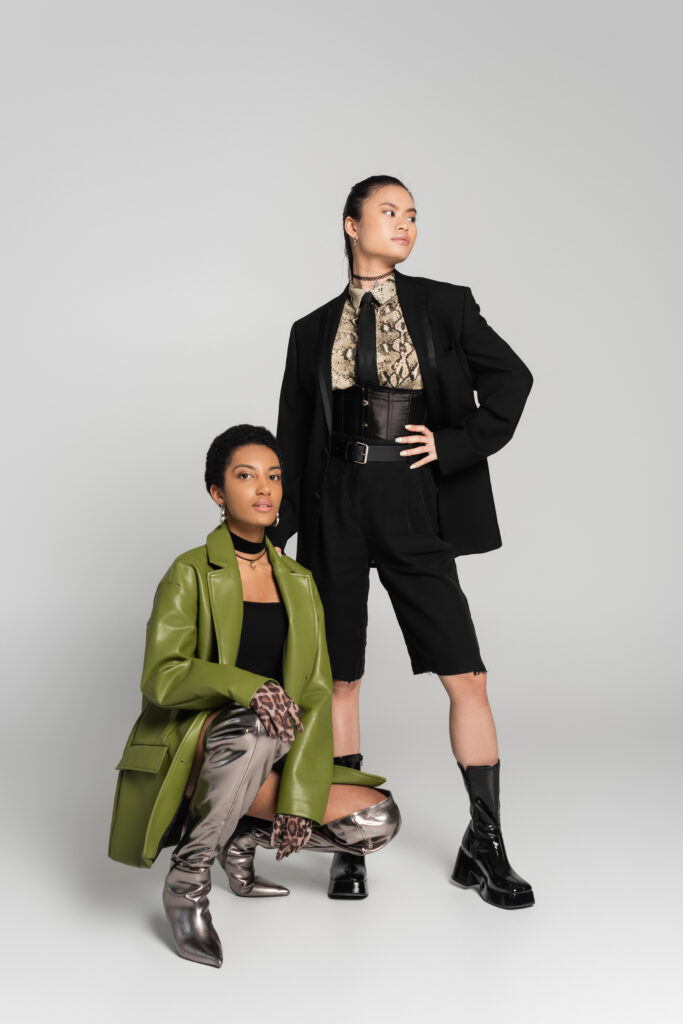
Moving beyond traditional gender constraints, fluid fashion prioritizes:
- Silhouettes that celebrate individual expression over conformity
- Experimental proportions and unconventional combinations
- Repurposing of historically gendered elements in new contexts
- Focus on how garments interact with and honor diverse bodies
- Creative tension between structure and fluidity
This approach challenges binary thinking while expanding the vocabulary of personal style for everyone.
Cultivating Your Personal Style
How to Navigate Different Types of Clothing Styles
Developing authentic personal style involves thoughtful exploration rather than strict adherence to categories. Consider these steps:
- Analyze your lifestyle needs and practical requirements
- Identify recurring themes in items you’re naturally drawn to
- Experiment with fusion approaches that blend different aesthetics
- Pay attention to how different styles make you feel when worn
- Build a foundation of versatile pieces that can adapt across style directions
Remember that the most compelling personal styles often exist at the intersection of multiple influences, reflecting the multifaceted nature of individual identity.
Frequently Asked Questions About Types of Clothing Styles
How do I identify which clothing style best matches my personality?
Start by noting patterns in clothes you feel most confident wearing and images you save for inspiration. Consider your lifestyle requirements, values, and the aspects of your personality you want your appearance to communicate. Experiment with different aesthetics in small doses before committing to significant wardrobe changes.
Can I embrace multiple types of clothing styles?
Absolutely! Many fashion-forward individuals incorporate elements from various style categories based on mood, occasion, and evolving preferences. This eclectic approach often results in the most authentic and interesting personal aesthetics.
How often do clothing styles typically cycle through fashion?
Fashion operates on multiple timelines simultaneously. Micro-trends may last only a few months, while broader style movements often cycle through 15-20 year periods. Classic elements, however, remain relatively consistent with subtle evolutions. The digital age has accelerated trend cycles while simultaneously allowing greater style diversity.
What’s the difference between a clothing style and a trend?
A clothing style represents a cohesive aesthetic approach with consistent underlying principles and cultural context. Trends are specific elements (silhouettes, colors, patterns) that temporarily gain popularity within or across various style categories. Styles tend to have longevity, while trends are more ephemeral.
Final Thoughts
The diverse types of clothing styles available today offer unprecedented opportunities for personal expression through fashion. Each aesthetic provides a unique vocabulary for communicating identity, values, and creative vision through what we wear.
As you explore this rich landscape of possibilities, remember that clothing styles are tools for expression rather than rigid categories demanding allegiance. The most compelling wardrobes reflect individual journeys, thoughtfully incorporating elements that resonate on a personal level rather than following prescribed formulas.
By understanding the defining characteristics and contexts of different types of clothing styles, you gain freedom to engage with fashion more intentionally. Your wardrobe becomes not just a collection of garments but a dynamic, evolving reflection of your authentic self—past, present, and future.
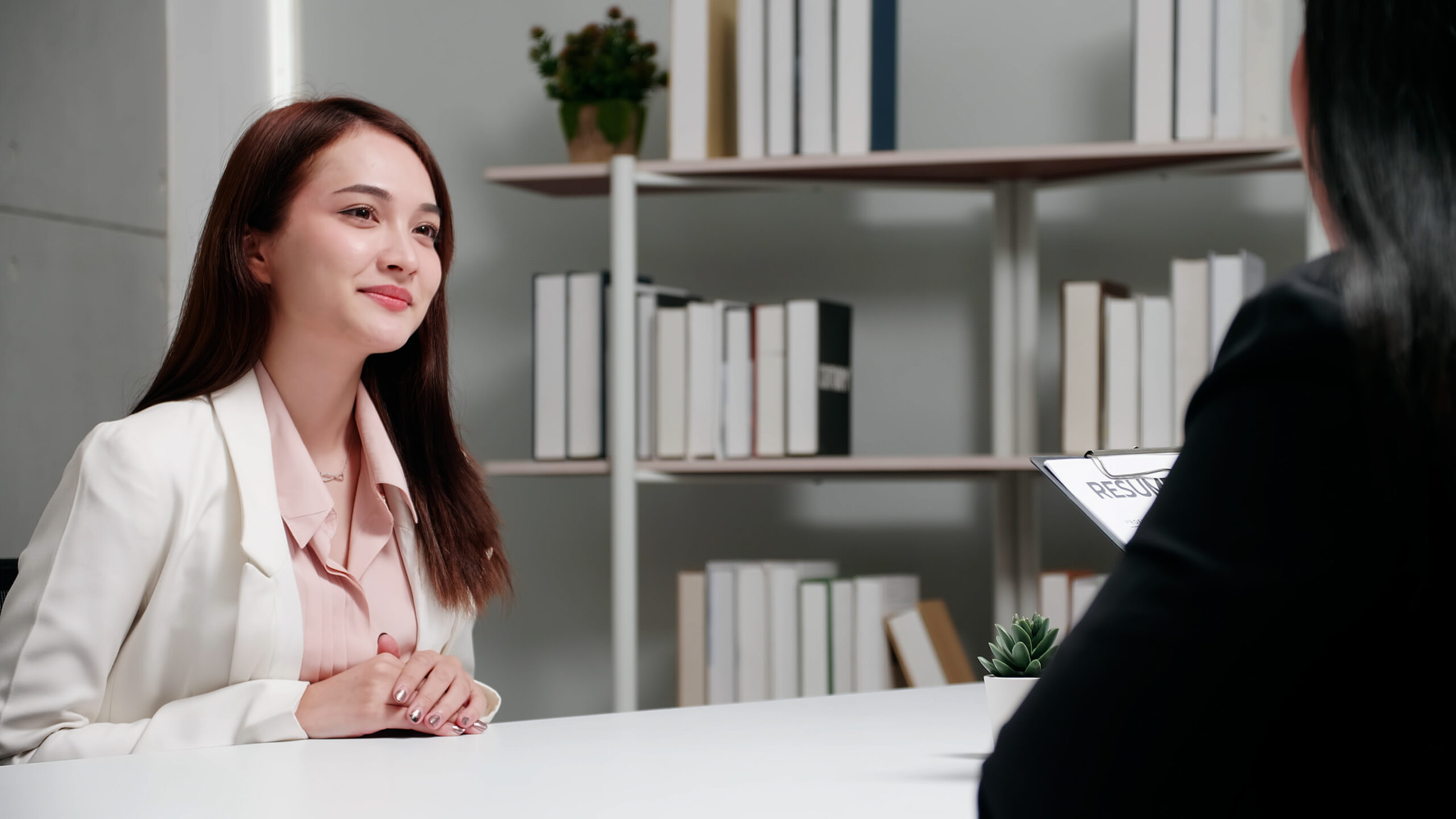
How to Dress for an Interview
How to Dress for an Interview: A Complete Breakdown
First impressions matter—a lot. And when it comes to job interviews, your outfit plays a huge role in shaping that initial perception. I happen to be very close to my boss and she gives me the inside scoop on exactly what she looks for when vetting a new employee. It’s not just about looking good; it’s about looking appropriate, confident, and prepared. Whether you’re applying for a corporate job, a startup gig, or a creative role, knowing how to dress for an interview can give you a competitive edge.
Your attire should match the company culture, industry, and job role. So, how do you strike the perfect balance between professionalism and personality? Let’s break it down.
1. Understanding the Dress Code: What’s the Industry Standard?
Different industries have different expectations when it comes to interview attire. Here’s a quick guide:
Corporate & Business Professional
If you’re interviewing for a position in finance, law, consulting, or any corporate setting, business professional attire is the way to go.
- Men: A well-fitted suit (navy, gray, or black), dress shirt, tie, leather shoes, and minimal accessories.
- Women: A tailored suit (pants or skirt), blouse, closed-toe heels or flats, and subtle jewelry.
Business Casual
Tech companies, startups, and marketing agencies often lean towards business casual. It’s professional but with a relaxed touch.
- Men: Dress pants or chinos, a button-down shirt or polo, and loafers or dress shoes.
- Women: A blouse with dress pants, a knee-length skirt, or a casual blazer paired with comfortable shoes.
Casual & Creative Fields
If you’re interviewing for a job in design, media, or other creative fields, the dress code may be more flexible. I always say to dress one level above casual to make a good impression.
- Men & Women: Well-fitted jeans or slacks, a smart-casual top, and stylish yet professional shoes. Just avoid anything too loud, ripped, or overly trendy.
2. The Do’s and Don’ts of Interview Attire
Even if you nail the industry dress code, there are still some rules to keep in mind.
Do’s:
- Dress slightly more formal than the company’s daily dress code. It’s better to be overdressed than underdressed.
- Wear clean, well-ironed clothes. Wrinkled shirts or scuffed shoes can ruin your entire look.
- Stick to neutral or muted colors for a polished, professional look.
- Ensure your outfit fits well. Too tight or too baggy? Neither will work in your favor.
Don’ts:
- Avoid flashy patterns or neon colors. You want them to remember you, not your outfit.
- Steer clear of strong perfumes or colognes. You never know if the interviewer has allergies.
- Say no to sneakers, flip-flops, or excessive accessories. Keep it sleek and professional.
3. Grooming & Personal Hygiene: The Final Touches

Looking the part goes beyond just clothing. Grooming and hygiene are equally important.
- Hair: Keep it neat. If you have long hair, consider styling it away from your face.
- Facial Hair: Trim or groom your beard for a tidy appearance.
- Nails: Keep them clean and trimmed. No chipped nail polish!
- Makeup: Keep it natural and professional.
- Breath: Pop a mint before your interview—bad breath is a confidence killer.
- Perfume: Keep it at a minimum. Do not drown yourself in perfume. Instead, make sure you at least take a bath or wear a very subtle perfume.
How to Dress for an Interview: Special Cases

1. Virtual Interviews: What Should You Wear?
Just because it’s over Zoom doesn’t mean you can slack off. Dress the same way you would for an in-person interview.
- Stick to solid colors to avoid distracting patterns on camera.
- Wear fully professional attire (yes, even pants!). You never know when you’ll need to stand up.
- Good lighting and a tidy background also contribute to a polished appearance.
2. What to Wear for a Startup Interview
Startups usually have relaxed dress codes, but that doesn’t mean showing up in sweatpants.
- A smart-casual outfit—like a button-down shirt with chinos—strikes the perfect balance.
- Avoid overly formal suits unless it’s a leadership role.
3. What to Wear When you Don’t Know the Dress Code
When in doubt, go for business casual or slightly more formal. If possible, check the company’s website or social media to get a sense of their culture.
Frequently Asked Questions About How to Dress for an Interview(FAQs)
1. Can I wear jeans to an interview?
It depends on the industry. For casual and creative fields, dark, well-fitted jeans can work. But for corporate roles, stick to dress pants.
2. Is it okay to wear all black to an interview?
Absolutely! Black is classic, professional, and stylish. Just break it up with a colored or white shirt to avoid looking too somber.
3. Can I wear sneakers to an interview?
Unless the company culture is super casual, sneakers aren’t a great choice. Opt for loafers, dress shoes, or polished flats instead.
4. How much jewelry is too much?
Less is more. Stick to one or two simple accessories—like stud earrings or a watch. Anything too flashy can be distracting.
5. What should I wear if the company says, “dress comfortably”?
“Comfortable” doesn’t mean sloppy. Go for business casual—chinos or dress pants with a well-fitted top.
Final Thoughts
Knowing how to dress for an interview is about more than just putting on a nice outfit. It’s about understanding the company culture, dressing appropriately for the role, and feeling confident in what you wear. Whether you’re going for a corporate job or a creative position, the key is to look polished, professional, and put-together.
Remember, when in doubt, always dress slightly more formal than necessary. It’s better to be the best-dressed candidate than the one who looks out of place. So, pick your outfit wisely, walk in with confidence, and let your skills do the rest!

How to Dress in Your 30s
First things first, there is no such thing as “dressing your age.” Wear what makes you happy and feel good about yourself. However, I do remember turning 30 and thinking to myself, “What do I wear now?!” For some reason, I felt fearful of dressing too young or too old and I truly believe that I am not alone with this feeling. With that being said, I understand how it feels to have fashion pieces that you once loved but it no longer feels like you. Turning 30 is a transformative time in a woman’s life – both personally and professionally. While trends come and go, dressing well in your 30s is about finding a balance between style, comfort, and sophistication.
So, how can you elevate your wardrobe to align with this new chapter of your life? The key lies in focusing on quality, defining your personal style, and curating a wardrobe that works for you rather than against you.
Invest in Quality Over Trends
In your 20s, it’s common to experiment with different styles and follow trends that you see on social media. However, your 30s call for a shift in perspective. While social media is a great place to start to find some inspiration, a personal style is about dressing for yourself—not following what’s trending.
Instead of chasing trends, invest in timeless, high-quality pieces that will last for years.
Why Should You Prioritize Quality?
- Longevity – High-quality fabrics and well-constructed garments stand the test of time.
- Better Fit – Quality clothing tends to have better tailoring and structure.
- Cost-Effective – While quality items may have a higher upfront cost, they save money in the long run as they don’t wear out quickly.
A good rule of thumb is to shop for more affordable seasonal pieces and invest in good quality classic pieces. Some examples of classic clothing include tailored blazers, well-made leather jackets, and high-quality jeans. These essentials will keep your wardrobe looking polished and put together. Your seasonal items will be easier to part ways with because you didn’t spend a whole lot of money on them to begin with.
Define Your Own Style
Your 30s are the perfect time to solidify your personal style. But how do you do that?
Ask Yourself These Questions:
- What outfits make you feel the most confident?
- What colors and silhouettes flatter your body type?
- Think of one clothing item that you love, why do you like it?
- Which styles align with your lifestyle and daily activities?
Did you realize that when you hit 30, you ended up buying more and wearing less? I have several pieces of athleisure that I don’t wear. Why? Because I only exercise once a week. That, I need to do better at, but this isn’t about me. I realized that I more often than not, I work from home with the occasional days where I go into the office. With that being said I started buying more business casual outfits. Buy clothes that you will wear based on your lifestyle. Maybe you are the outdoorsy type. Wear more functional clothing that can withstand varying weather conditions. Perhaps you are more of a minimalist. Stick to neutral-toned clothing. Whatever your style is, own it and refine it with pieces that truly represent who you are. If you are not sure of what your clothing style is, be sure to check out my blog post on this topic!
How to Dress in your 30s – Decluttering
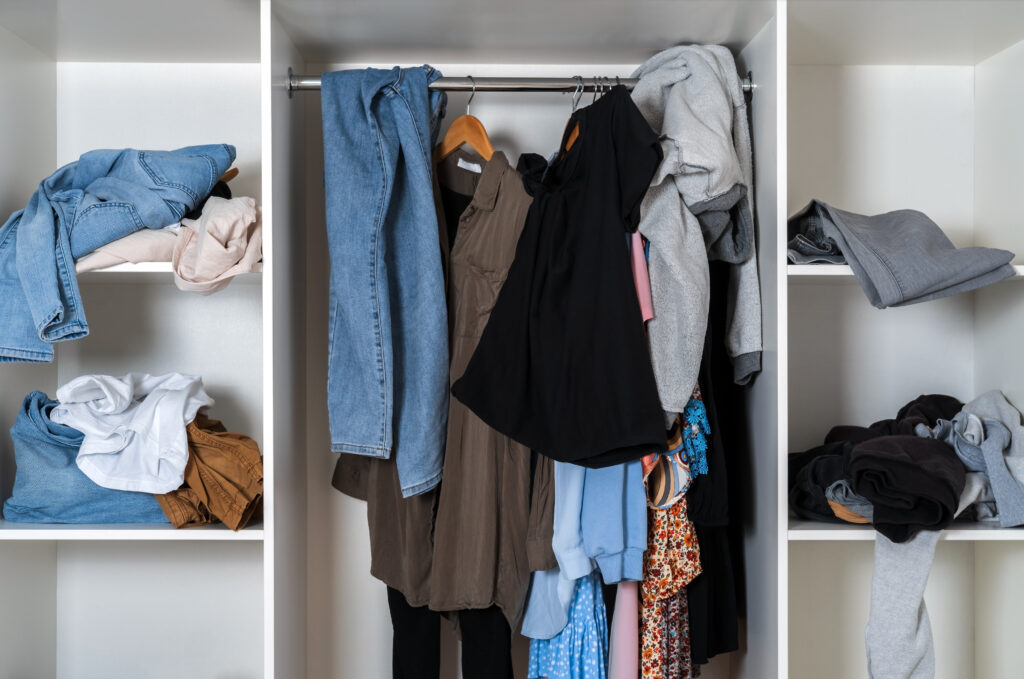
A cluttered wardrobe filled with unworn or outdated items can make getting dressed stressful. Your 30s are a great time to streamline your closet and make space for pieces that truly align with your style.
Steps to Declutter Your Closet:
- Take Everything Out – Lay out all your clothes so you can assess what you have.
- Sort Items into Categories – Keep, donate, sell, or recycle.
- Let Go of Pieces That No Longer Serve You – If it doesn’t fit, isn’t your style anymore, or hasn’t been worn in a year, it’s time to say goodbye.
- Organize Your Closet Efficiently – Arrange your clothes in a way that makes them easy to access. Use hangers, drawers, and storage solutions to keep everything neat.
A decluttered closet allows you to focus on pieces you truly love which will make getting dressed much more enjoyable!
Prioritize Fit
No matter how expensive or stylish a piece of clothing is, if it doesn’t fit well, it won’t look good. Prioritizing fit over everything else will make a huge difference in your overall appearance.
How Can You Ensure the Perfect Fit?
- Know your body type – Understanding your proportions helps you choose clothing that enhances your best features.
- Get items tailored – A little tailoring can turn an average outfit into a stunning one. Adjusting hemlines, sleeve lengths, or waistlines can make all the difference. You can even start making the adjustments yourself. Think of it as a fun new hobby to experiment with in your 30s.
- Avoid overly tight or baggy clothing – Aim for a silhouette that complements your frame without feeling restrictive.
Appreciate your body, for a well-fitted outfit exudes confidence and sophistication, which is exactly what you want in your 30s. If you want more inspiration on getting out of your comfort zone when it comes to dressing up, I have a blog post for that! Check out what might be holding you back from dressing up and what to do about it.
Invest in High-Quality Basics
If you have been paying attention to fashion trends, you will notice lots of talk about building a “capsule wardrobe.” A capsule wardrobe consists of timeless, high-quality basics. These are the pieces that you can mix and match for any occasion.
How to Dress in your 30s – Essential Basics to Invest In:
- A Classic White Shirt – Perfect for layering or wearing alone.
- A Few Good Quality Tank Tops – Also great for layering.
- A Well-Tailored Blazer – Instantly elevates any outfit.
- Dark Wash Jeans – A versatile piece that works for both casual and semi-formal occasions.
- A Little Black Dress – Timeless, chic, and always appropriate.
- Quality Footwear – A good pair of leather boots, classic pumps, or stylish sneakers can pull any look together.
- A Structured Handbag – A polished, well-made bag can make any outfit pop!
Building your wardrobe around high-quality basics ensures you always have something stylish to wear without overthinking your outfits.
Mindful Shopping
Gone are the days of impulse shopping and buying items just because they’re on sale. Your 30s are about shopping with intention and making purchases that align with your personal style.

How to Shop More Mindfully in Your 30s:
- Create a Shopping List – Before heading to the store or browsing online, make a list of what you actually need.
- Invest in Versatile Pieces – Choose items that can be styled in multiple ways.
- Consider Cost Per Wear – Instead of focusing on the price tag alone, think about how often you’ll wear the item. If it’s something you’ll use frequently, it’s worth the investment.
- Avoid Trend-Driven Purchases – Trends fade, but your style should remain timeless.
By being more intentional with your shopping habits, you’ll build a wardrobe filled with pieces that you love and wear regularly.
Styling Statement Pieces with Confidence
Letting One Item Do the Talking
Whether it’s a graphic tee or a bold blazer, styling statement pieces is all about balance.
How to Wear Statement Items:
- Style a white blazer over a printed dress or jeans and a simple top.
- Pair a graphic tee with a structured blazer and tailored pants for a cool twist on smart casual.
- Let one statement item shine—don’t overload your outfit with competing pieces.
Statement pieces add personality. Just be sure they still reflect your taste and are easy to mix with staples.
Dressing for Special Occasions
Confidence Is the Key Ingredient
Whether it’s an interview or a night out, what you wear should help you feel your best.
What to Wear for:
- Job Interviews: Stick with structured silhouettes, closed-toe shoes, and neutral colors.
- Clubbing or Night Out: A bold dress or sleek pants with a bodysuit and heels.
- Casual Gatherings: Statement jeans with a cute blouse and ankle boots.
Dress codes vary, but confidence is always in style. Choose pieces that flatter your shape and fit the occasion.
Seasonal Styling Strategies
Dressing Well Year-Round
Adapting your wardrobe to each season ensures you’re both stylish and comfortable.
Tips for Layering and Seasonal Adaptation:
- In spring, wear floral dresses with light cardigans or denim jackets.
- For fall, layer dresses with tights, boots, and trench coats.
- In winter, add chunky scarves, knee-high boots, and structured wool coats.
- Don’t forget breathable fabrics in summer—think cotton, linen, or moisture-wicking blends.
The trick is layering with intention—build outfits that can be adjusted as the temperature changes.
Accessorizing to Elevate Your Look
Small Details Make a Big Impact
Accessories are the finishing touch that can turn an average outfit into a fashion-forward look.
Must-Have Accessories for Women in Their 30s:
- A crossbody bag in a neutral color
- Gold or silver hoops and stacking rings
- A quality everyday watch
- A belt that adds structure to loose outfits
- Sunglasses with classic frames
When in doubt, keep accessories simple. The goal is to complement, not overpower.
Final Thoughts
Dressing in your 30s is all about refinement, confidence, and investing in pieces that enhance your personal style. By prioritizing quality over trends, focusing on the perfect fit, and curating a wardrobe filled with versatile basics, you can ensure that your style remains timeless and sophisticated.
So, as you step into this stylish new decade, remember—your wardrobe should empower you, reflect who you are, and make you feel incredible every day. Happy styling!
